On this page you will discover our Asian travel diaries.
Follow us on social media:
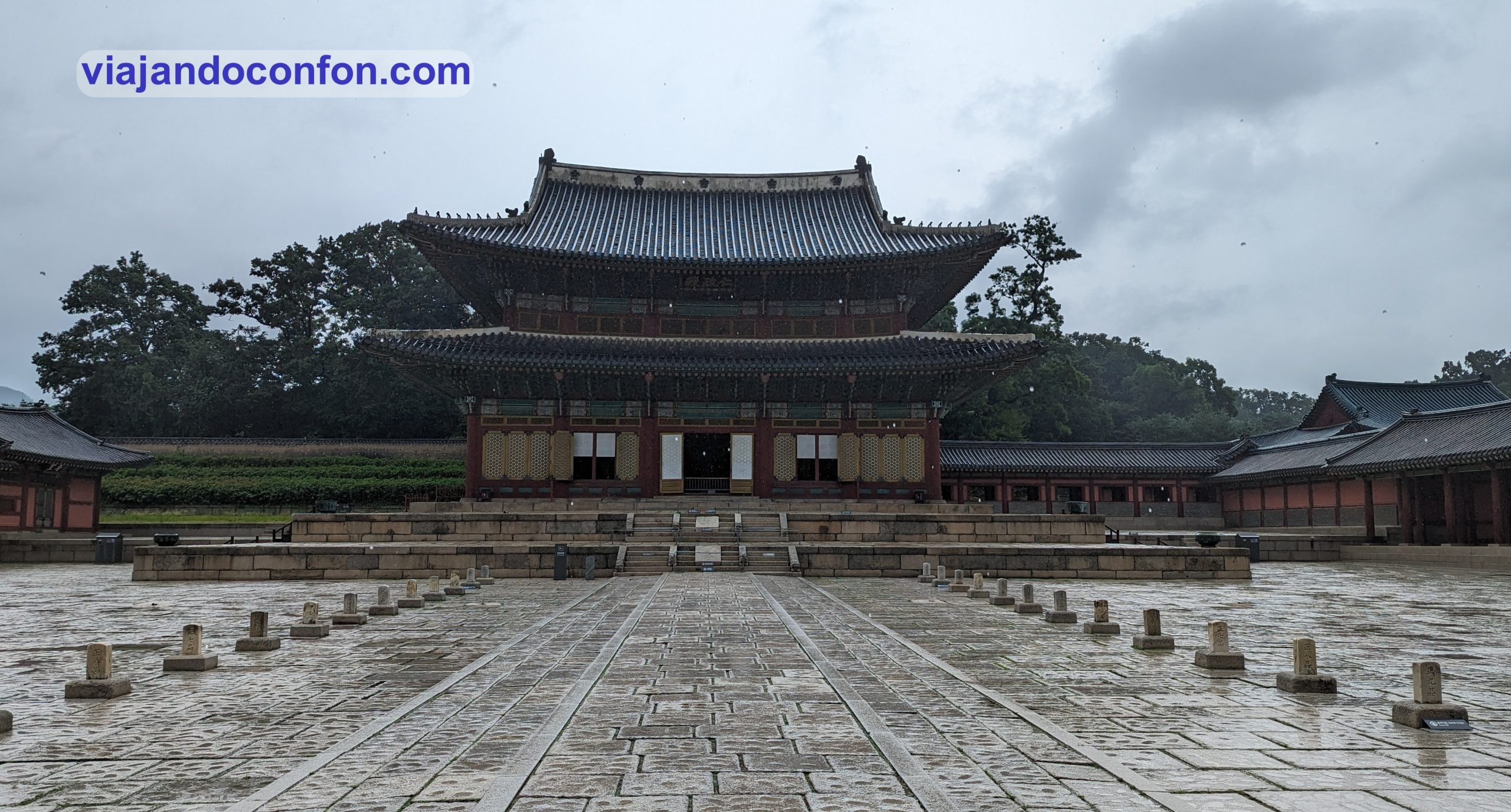
As always, we recommend traveling with good health insurance. IATI is a specialist in travel insurance and, for being our reader, you have a 5% discount.
On this page you will discover our Asian travel diaries.
Follow us on social media:

As always, we recommend traveling with good health insurance. IATI is a specialist in travel insurance and, for being our reader, you have a 5% discount.
We continue our trip through South Korea. We are still in Seoul, but now it’s time for an excursion.
August 13th
Today we are getting up quite early again. We are going on an excursion to the city of Suwon. But this time on our own, not like the visit to the DMZ.
The city of Suwon is located 30km south of Seoul and is the capital of the province of Gyeonggi. To get there we took line 1 of the Seoul underground. Approximately 1 hour and 15 minutes later we arrived at Suwon station. Yes, the underground goes to Suwon.
We got off the underground and went in search of the bus stop to go to the first stop: Padalmun Gate. There we got on the bus nº11 and we got off next to the gate.

Built in 1794, Paldalmun is the southern gate of Hwaseong Fortress in Suwon. The area around Paldalmun Gate was a road leading to the Samnam region. Therefore, people frequented it even before the construction of Hwaseong Fortress.
The current building is the original one, which was restored in 2013.

We go round the gate and head for Mount Padalsan to walk along the wall. Note that the climb can be really tough. A combination of hills and steep stairs.
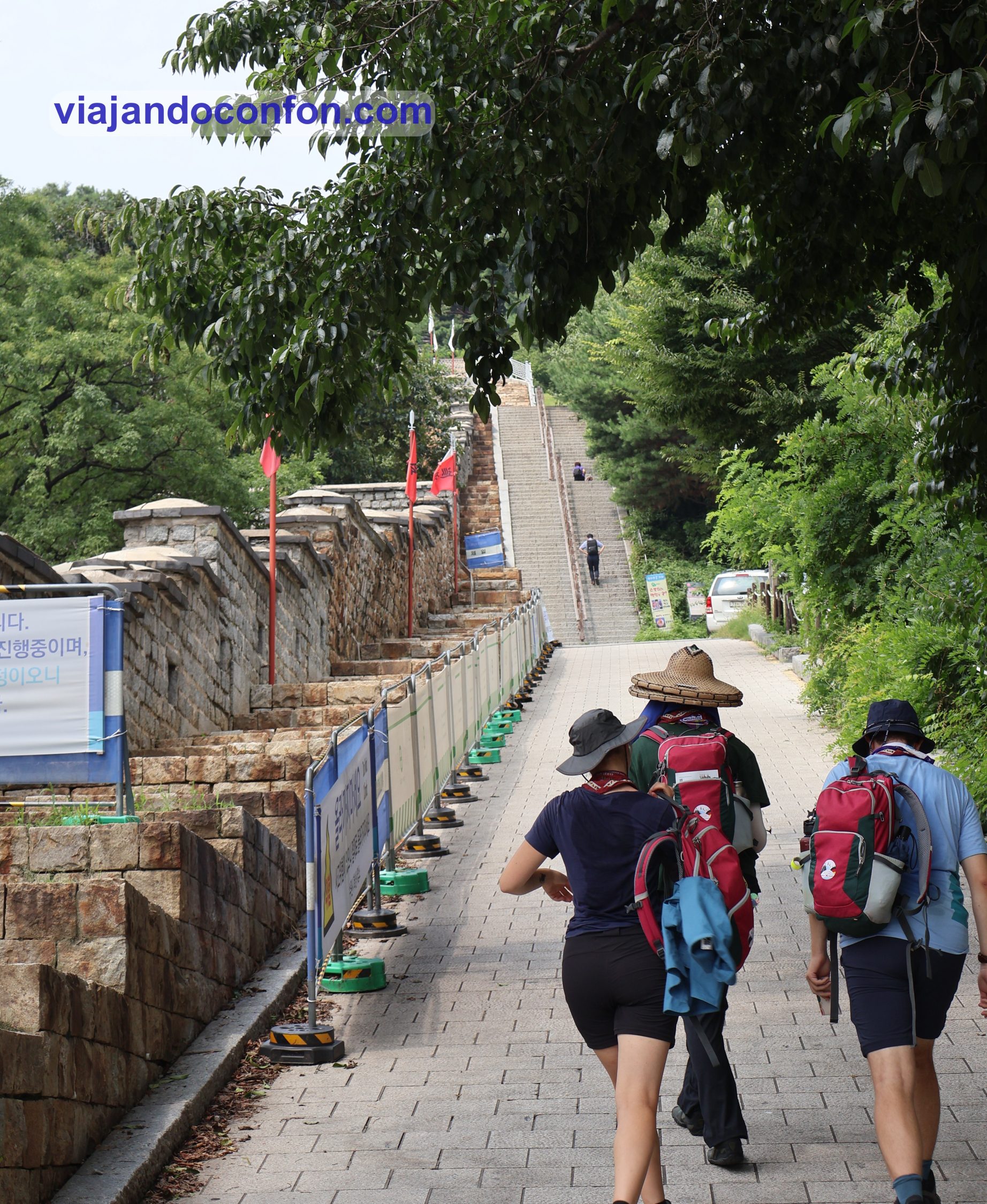
At the end of the climb we needed a well-deserved rest. Between the steps and the humid heat, it felt like we had taken a shower. Here we can sit on shady benches next to the Korean Independence Monument.
At the bottom of the stairs is the Seonamammun Gate. Built in 1796, it is an emergency gate built in the southwest of Hwaseong. It is one of the 5 secret gates of the fortress.

If we go south through the gate, we come to the south-west tower or Huayang Tower. It is located in a very high area perfect for surveillance… if the trees would let us. I suppose it would be clearer at the time.
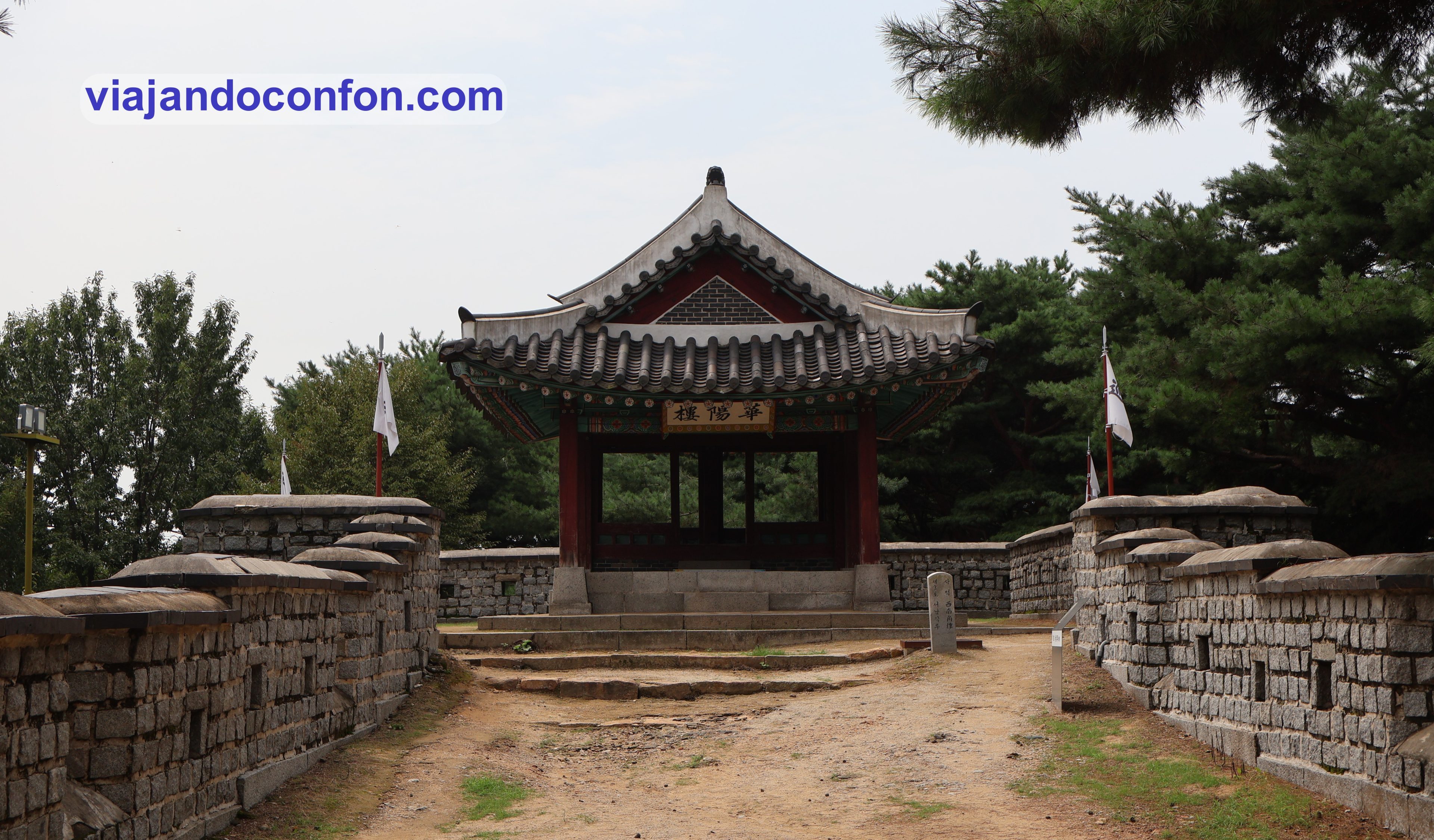
We retrace our steps, cross the gate again and head towards Seoporu. This is a guardhouse that served as a lookout for the soldiers. It is one of the five guard pavilions in Hwaseong Fortress.
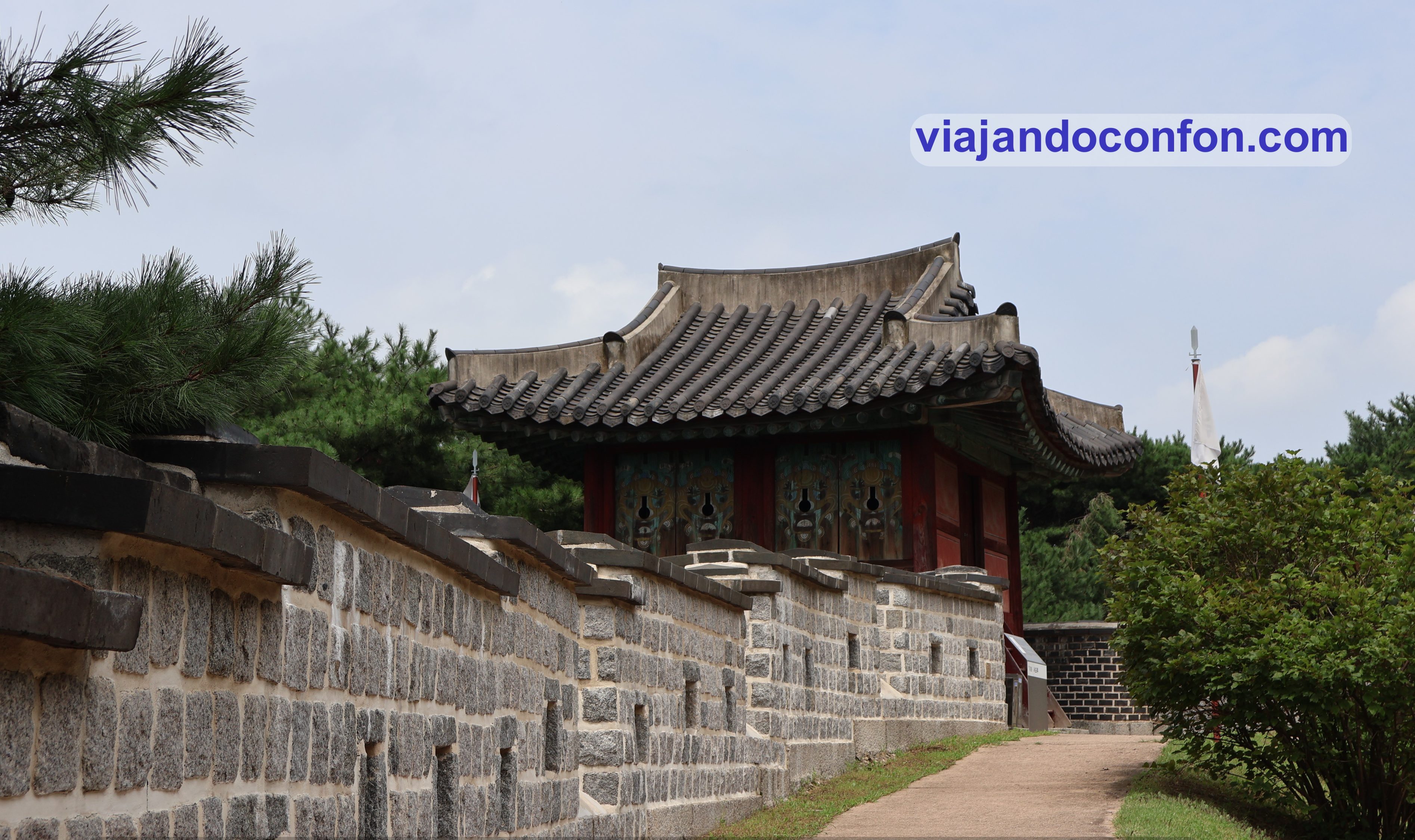
A little further north is the Hyowon Bell. It was created to honour King Jeongjo’s filial devotion to his father, Crown Prince Sado.
The bell must be rung three times. The first ringing is in gratitude for parental love. The second is to hope for happiness in the family. And the third as a prayer for self-improvement.

A little further on we come to the jewel in the crown of Mount Paldal: Seojangdae. This is the Western Command Post and was the general command centre of Hwaseong Fortress.
In 1795, when King Jeongjo visited the fortress, he took command of military training from this post.
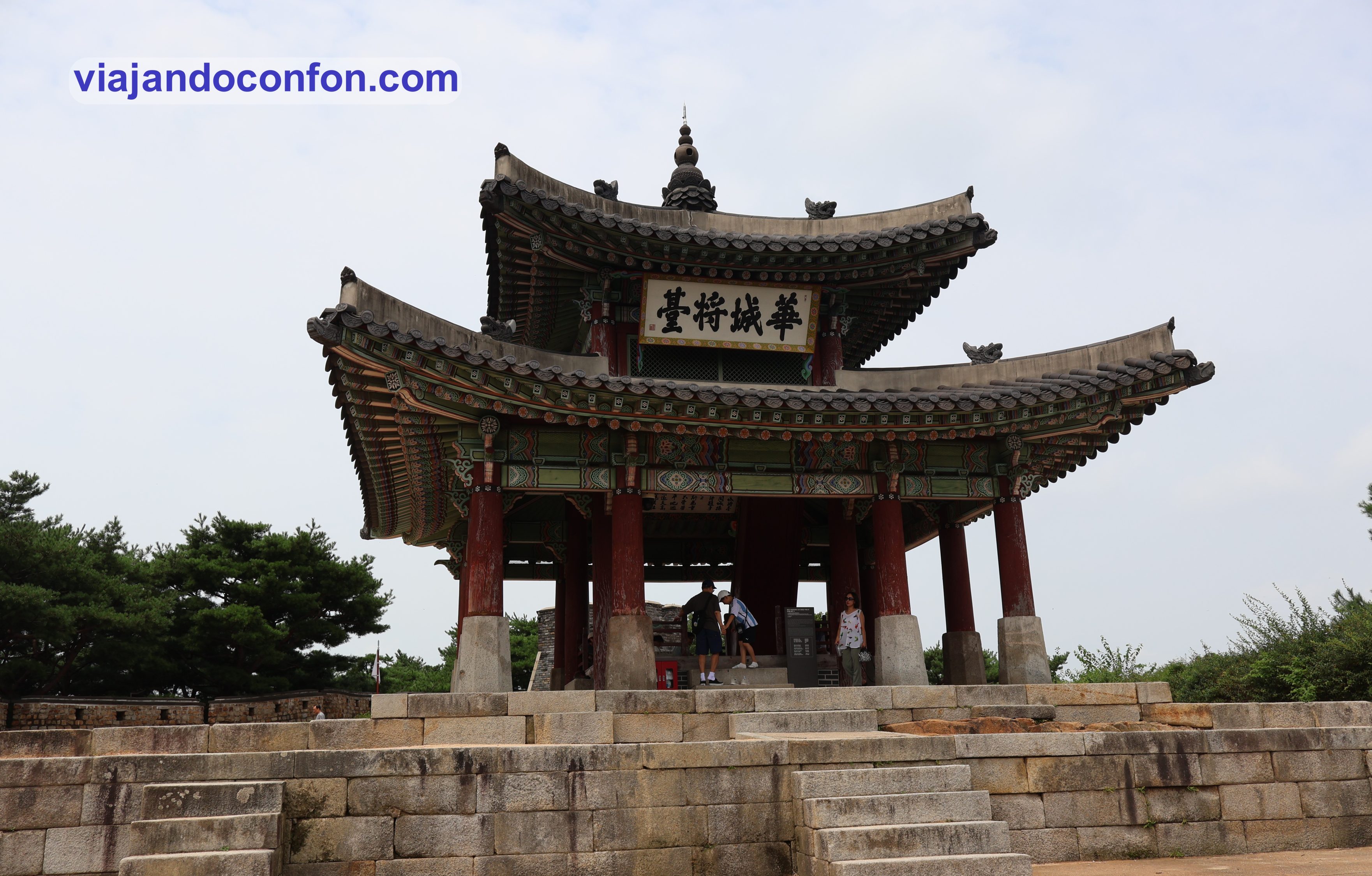
From here we can enjoy wonderful views of the city of Suwon. It’s a long climb but, frankly, it’s worth it.
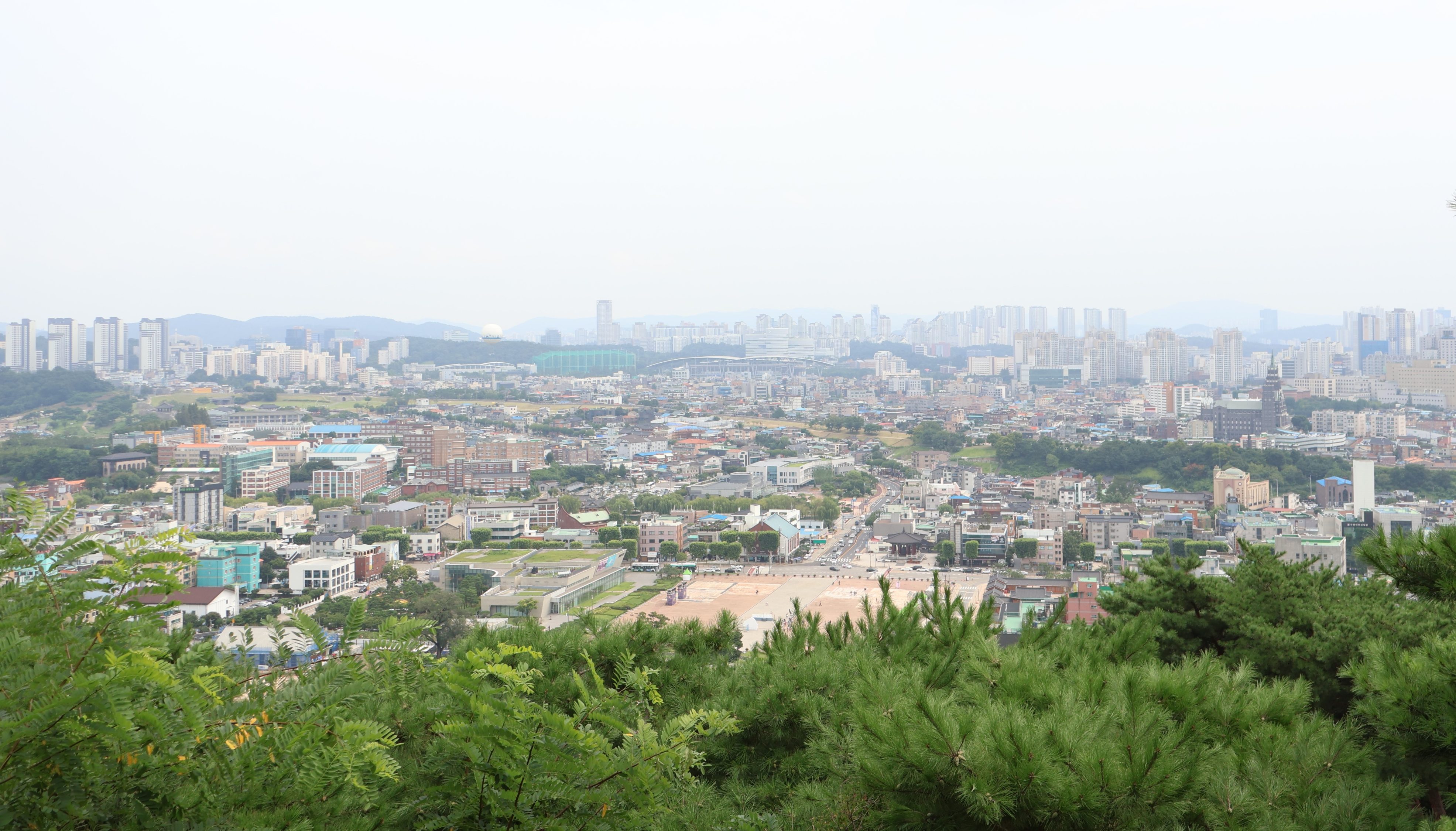
We start the descent to Hwaseong Haenggung Fortress. The descent through the forest is wonderful, except for the terrible humidity that makes you sweat profusely.
On the way we pass the Padalsan Daeseungwon temple belonging to the Mahayana Monastery. It was founded in 1954 under the name ‘Mahasa’.
This temple does not belong to any particular sect. It is a place of research and education on Buddhist thought. Its 19-metre high golden Buddha statue is visible from many parts of the city.

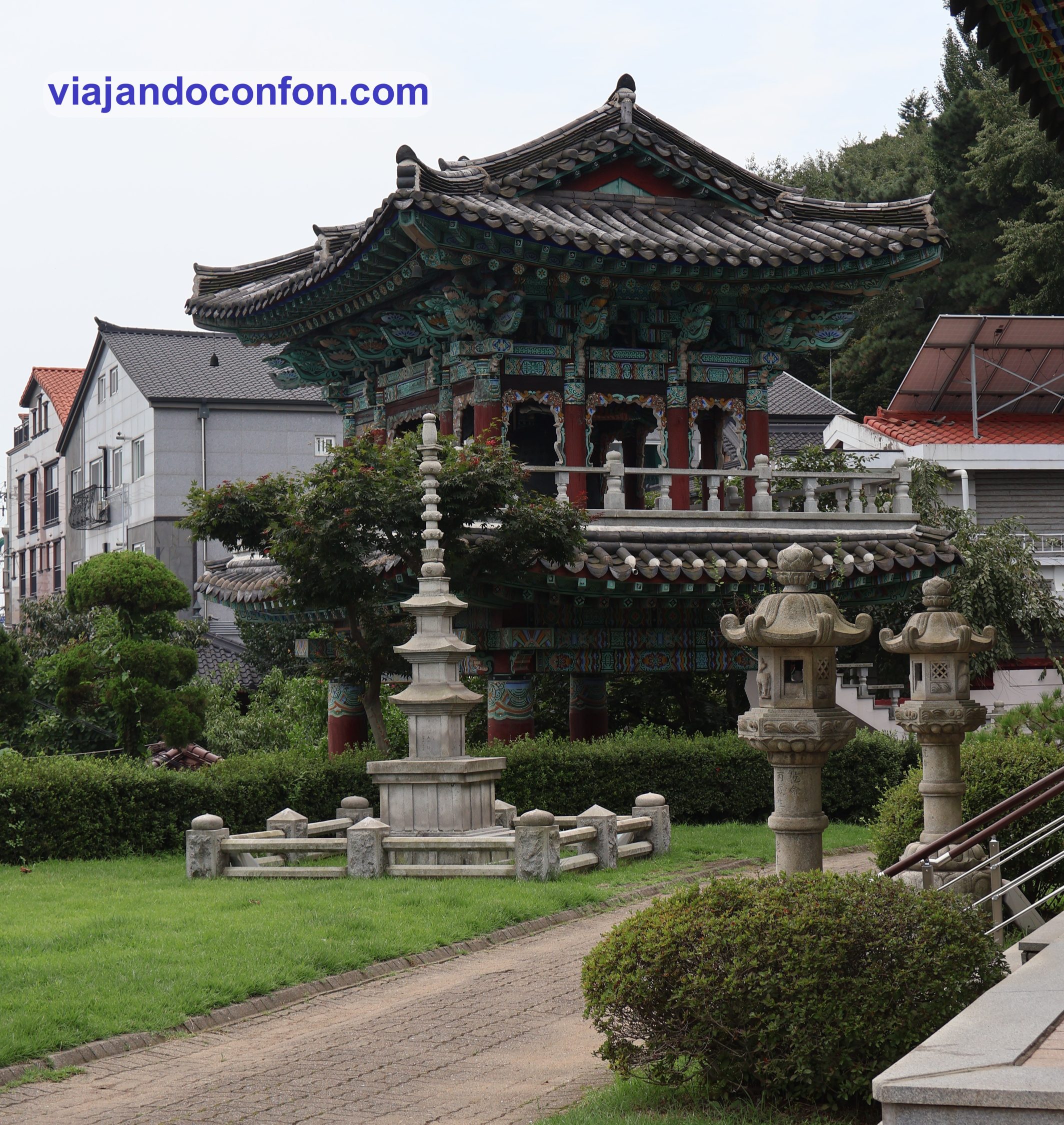
The place was a real haven of peace and quiet. We were the only tourists there.
We continued our descent towards the fortress. By the time we reached the bottom we were so overwhelmed by the humid heat that we decided to take a little rest while we had a cool drink. We did so at a local coffee shop chain called Tom N Toms Coffee. We had some lemonade, which was good but still syrupy.
After refreshing ourselves we went back to the tourist trail. First stop: Yeomingag. This bell was installed in front of Huwaseong Palace in 1796 by order of King Jeongjo. It was lost during the Japanese invasion and was restored in 2008.
On the night of 31 December, the New Year’s Eve chimes are rung here.

Now we move on to the jewel of the city: the Hwaseong Haenggung Palace. It was built in 1789, year 13 of the reign of King Jeongjo of the Joseon dynasty.
Its original function was as a government office. It was also used as a temporary palace where the king stayed when he travelled to Suwon.
King Jeongjo elevated the status of Suwon by promoting it to Hwaseong Yusubu, and built a new one in 1795 to celebrate the 60th birthday of his mother, Lady Hyegyeonggung Hong. It was completed in 1796 with a total of 600 rooms.

We arrive at the ticket office. We queue up and buy our ticket, which cost us 3,000₩ (2€).
The first thing we come across is the Sinpungru Pavilion. It is the main gate of the palace and was built when the government office building was constructed. It was originally called Jinnamru but was changed to the current name in 1795.
In the building there is a large drum on the upper floor, which the soldiers used to monitor the surroundings and send signals.

We pass through the gate and find ourselves in an esplanade. To the right are some buildings of the original government offices.
On the left is a 600-year-old zelkova tree. This tree was already here before the palace was built. Note that it is propped up and riveted…

Next to the tree is the entrance to the butler’s office. This is where the meetings between the officials of Suwon and the neighbouring areas were held. On the 1st and 15th of each month, the magistrate of Suwon held a ceremony at the guesthouse. It was called Uhwagwan, and a deep reverence was paid to the royal capital.
Today, there is an exhibition of royal robes from the period.
Bongsudang, the main hall, is located in the centre of the well-protected enclosure. It was used as the throne room when the king visited and as the magistrate’s office at other times.

In 1795, King Jeongjo held a royal banquet here for his mother’s 60th birthday. During this banquet, he called the hall ‘Bongsudang (壽堂)’, which means ‘longevity prayer hall’.

Adjoining and connected to Bongsudang is Jangnakdang. It was built in 1794 to be used as a hall for King Jeongjo’s mother during her 60th birthday banquet in 1795. Its name ‘Jangnakdang Long (樂堂)’, means ‘hall of lasting happiness’.

To its left, in the next courtyard, is the Bongnaedang. Built in 1789, it was one of the first buildings to be constructed in the palace. Initially it was used as the king’s dormitory, but after Jangnakdang Hall was built in 1794, it was used by the local magistrates.
The name ‘Bongnaedang (福內堂)’, chosen by King Jeongjo, means ‘hall that radiates happiness from within’.
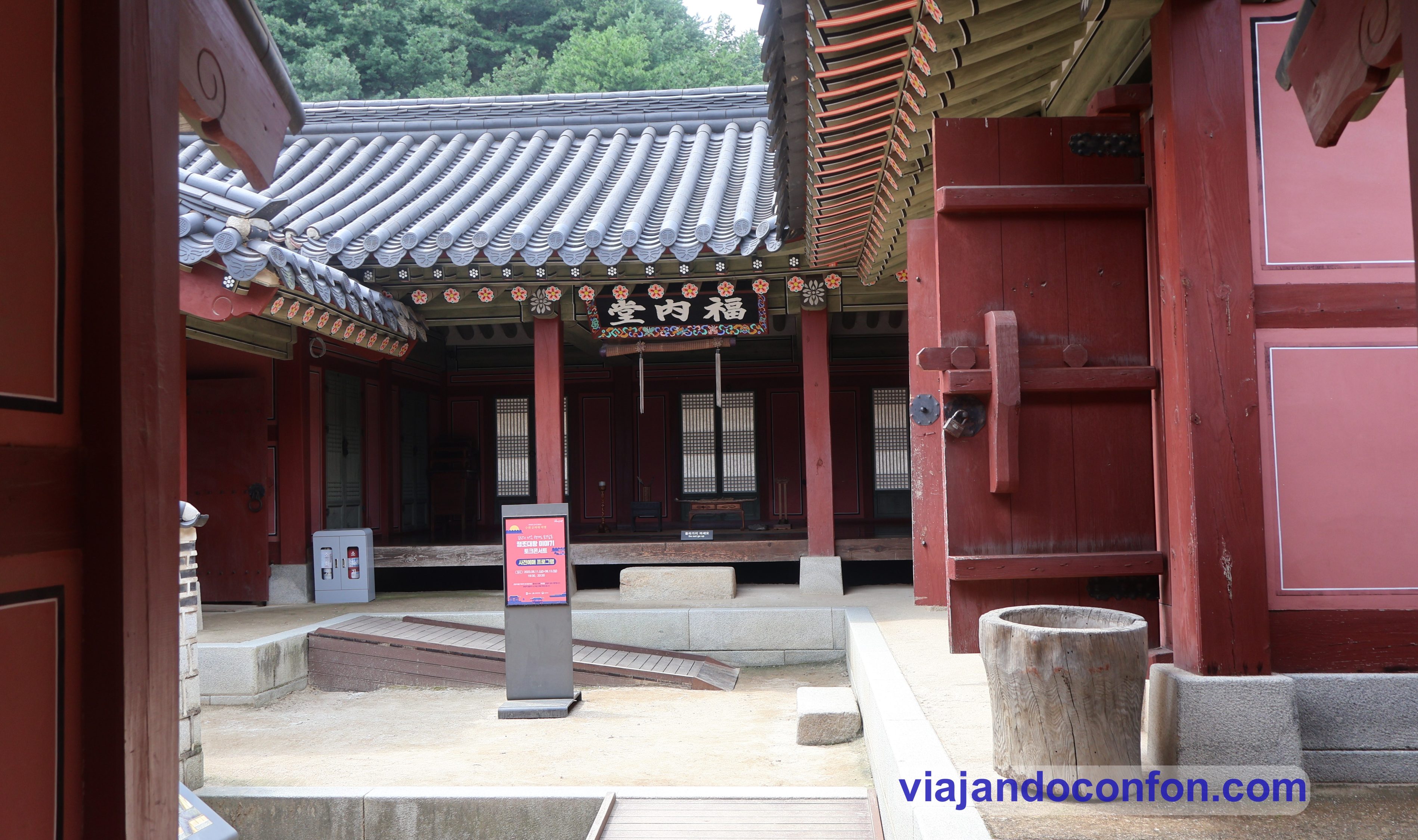
We leave Bongnaedang through the back gate. There we come to a staircase with steps at least half a metre high, leading up to the guard post. We reach it by turning off to the right.
It was used to inform people inside the temporary palace about emergencies. It is one of the three remaining guard posts in the palace. Although it is a reconstruction from 2006. The original one was destroyed in the early 20th century.

On the left hand side is the Mirohanjeong Pavilion. It was built in 1790 and was originally called ‘Yungmyeonjeong (六面亭)’. This translates as six-sided pavilion… guess why.
In 1795, King Jeongjo changed its name to ‘Mirohanjeong (未老閑亭)’, which means ‘a pavilion for relaxing in old age’. The king intended to abdicate and retire to the temporary palace from 1804. Unfortunately he died in 1800.
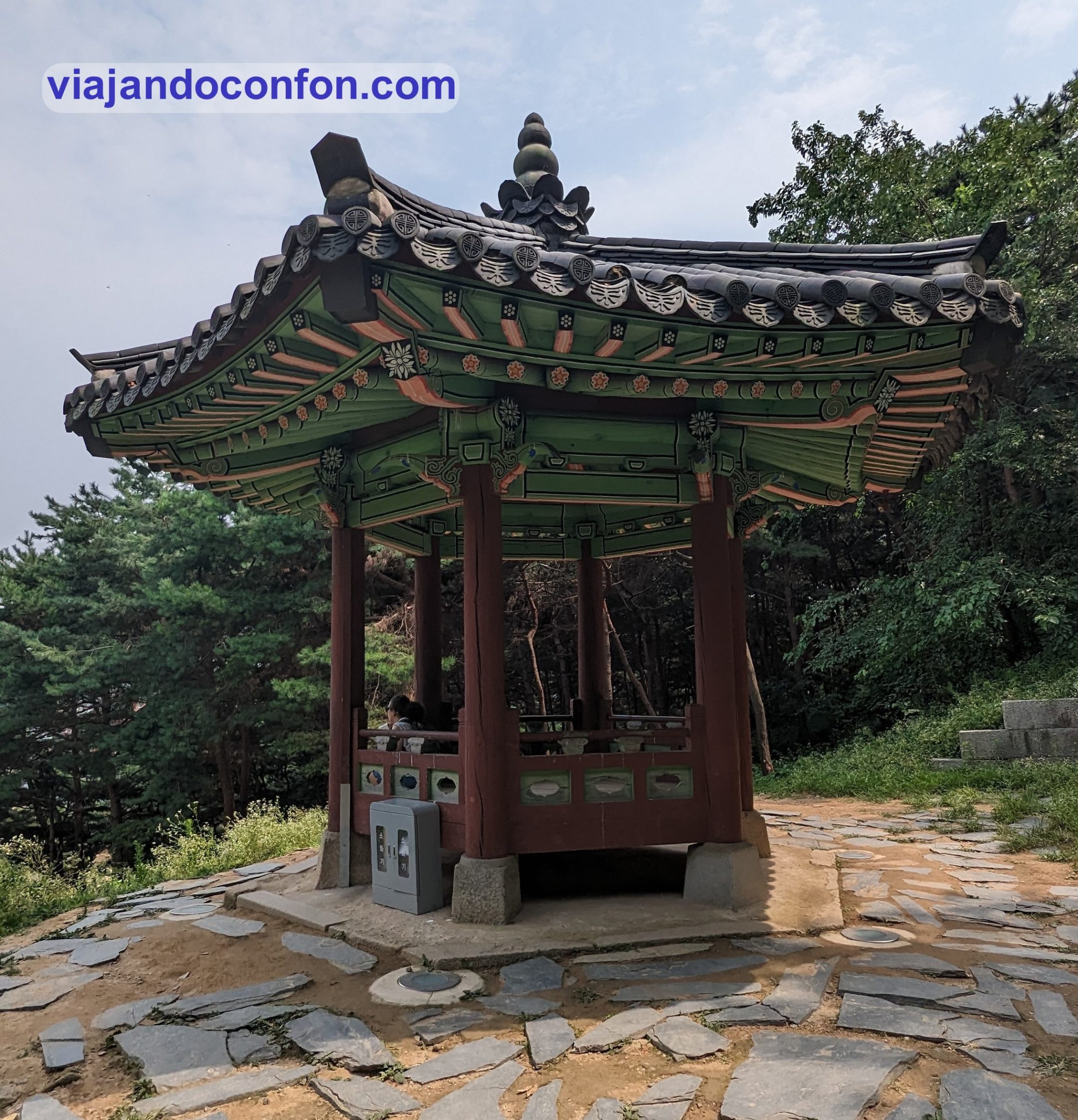
From here we can see beautiful views of Suwon and the palace.

This is the end of our visit to Hwaseong Haenggung. But not Suwon. Although we were starting to feel like eating. But first we preferred to finish with the city. We went straight to Hwaseomun Gate.
Hwaseomun is the west gate of Hwaseong Fortress and that is the meaning of its name. Although the gate is actually located to the northwest of the fortress. One of the four gates of Hwaseong Fortress, it was built in 1796.
Along with the adjacent Northwest Watchtower, it is considered one of the most iconic scenes of Hwaseong Fortress.
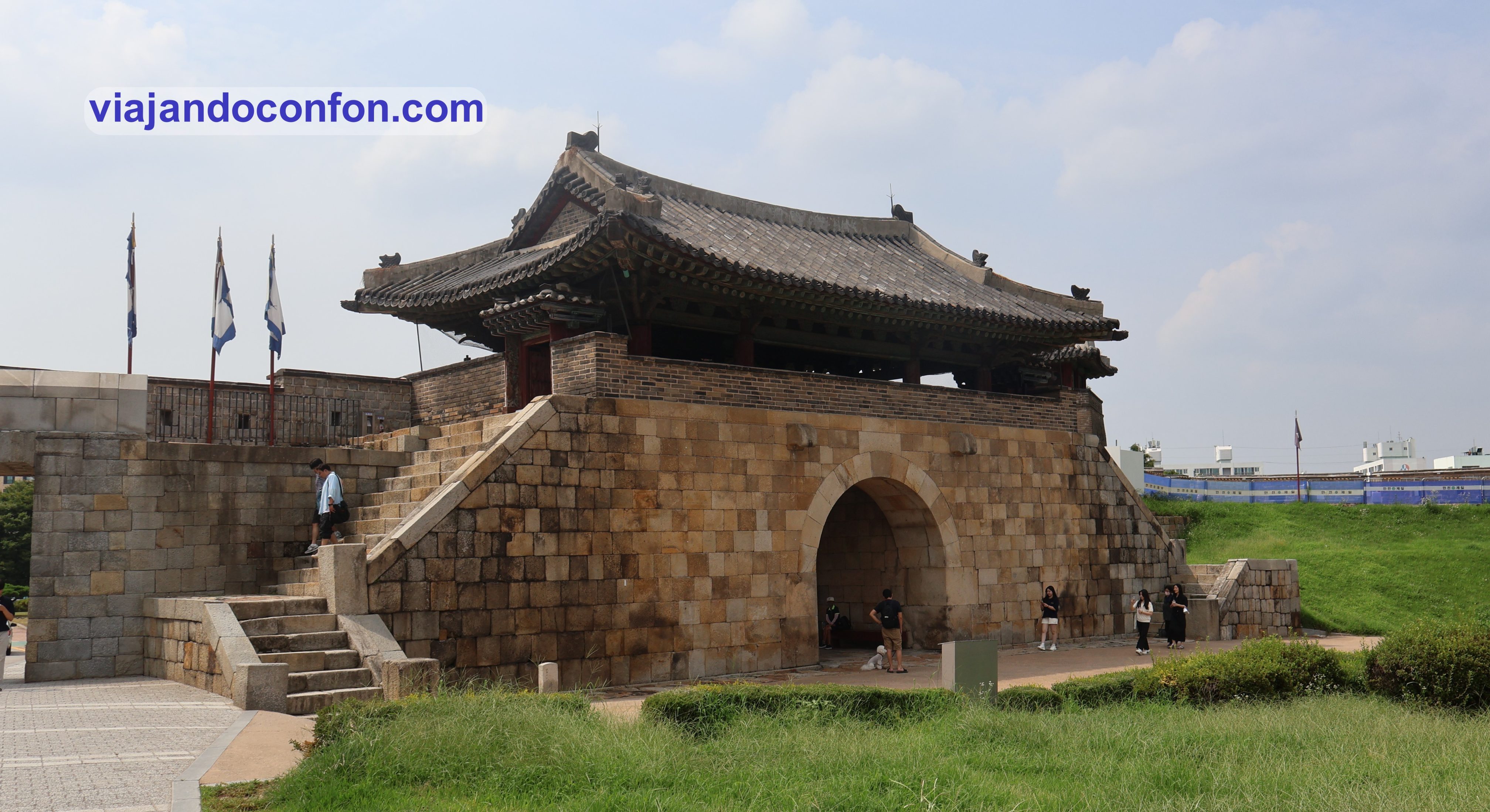
Now it’s time to eat. We retrace our steps looking for a place that looks tasty. In the end, after a lot of walking around, we enter a fried chicken place called Maehyang Whole Chicken.
We ordered a portion of chicken for one person and two soft drinks. When the chicken arrived, IT WAS A WHOLE CHICKEN!!!! We had our doubts as to whether we had been served for two until the bill arrived. Well no, it was a single portion, what a barbarity.
It was really tasty and the whole thing cost us 19.000₩… 13€… THE TWO OF US. Exaggeratedly cheap. We were very amused that they also gave you plastic gloves to avoid staining your hands.

Now our visit to Suwon is over. We get ready to take the bus to the station. The bus took forever to pass and it was packed to the rafters. To push and padentro.
We arrived at the station just in time for the underground departure to Seoul.
Seoul
We got off at City Hall station. Nearby is the Cathedral of St. Mary the Virgin and St. Nicholas. This is the cathedral of the Anglican Diocese of Seoul.
In 1890 the first Bishop Charles John Corfe bought a hanok and land for the church on this site. He called this hanok Janglim Cathedral. In 1892 it was replaced by another hanok and its consecration took place.
After the purchase of adjacent land, the present cathedral was built in 1922.
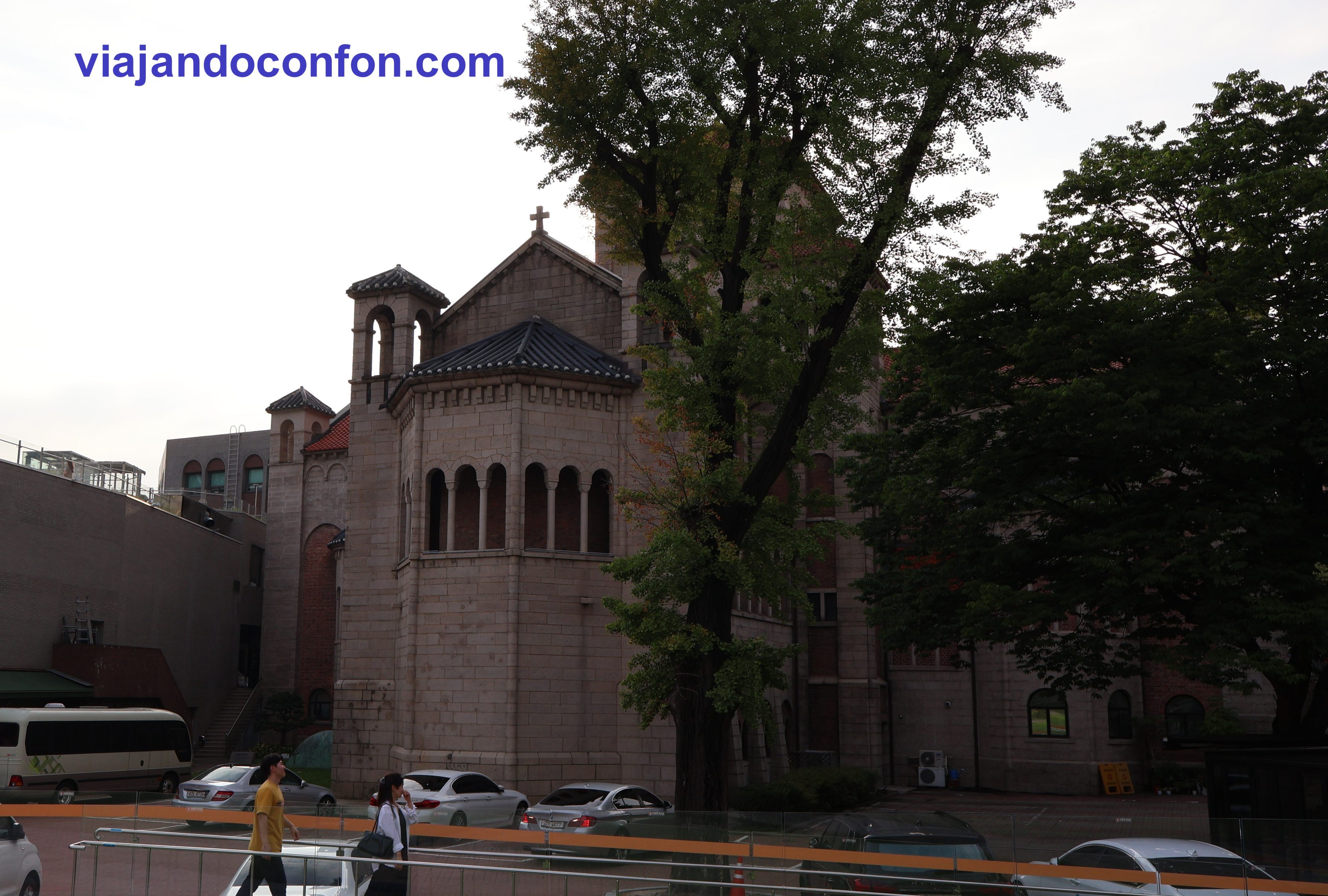
Directly opposite is the town hall building. It consists of two buildings. The original was built in 1925 during the Japanese occupation. It served as the city hall from the liberation of Korea in 1945 until 2008. It now houses the Seoul Metropolitan Library.
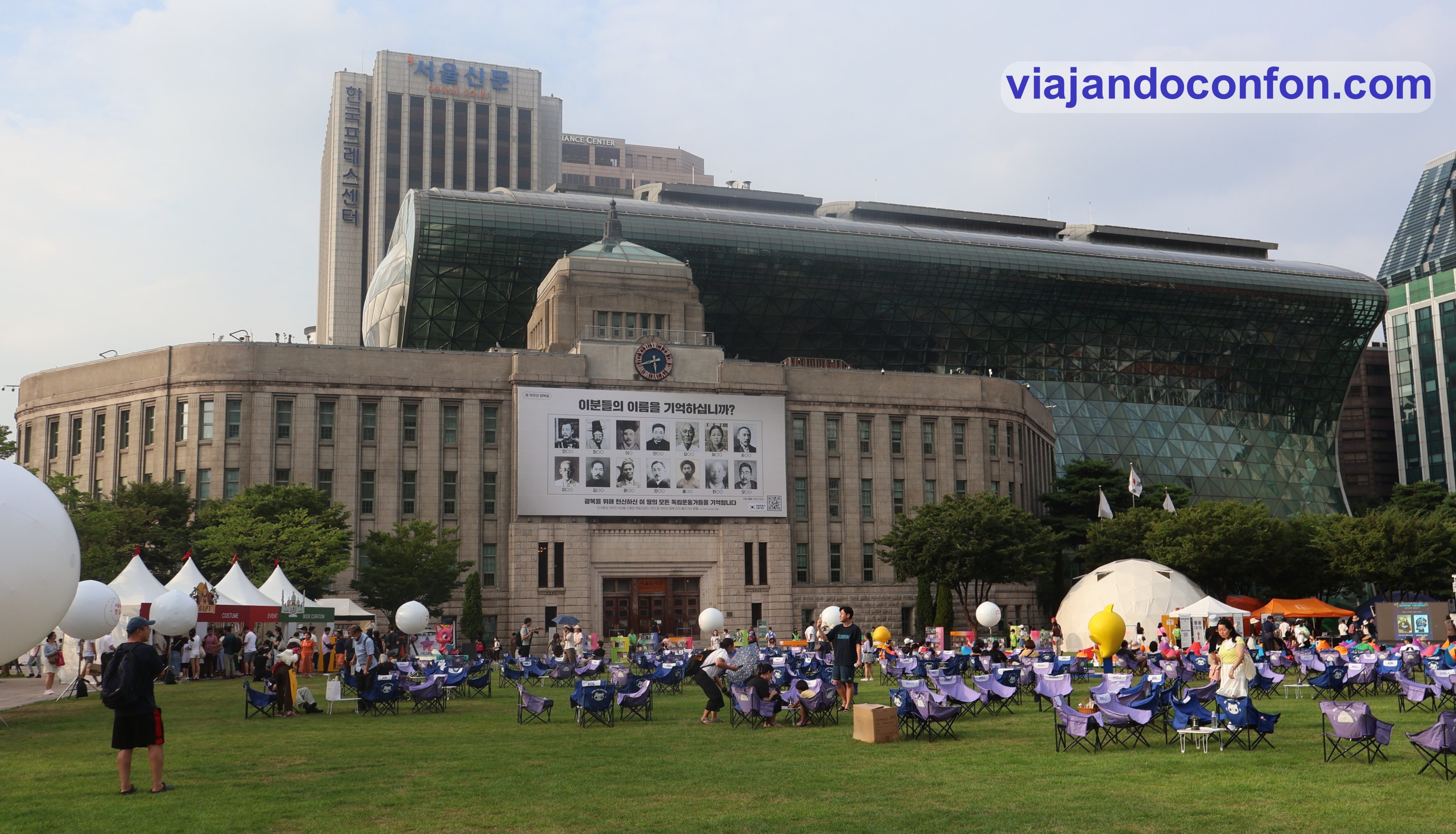
Behind it is the current modern building, which was opened in 2012.
At that time, the Jamboree 2023 was being held in South Korea. It was a kind of world scout convention. It was supposed to be held in Saemangeum, in the centre of the country. Because of the typhoon that hit Korea these days they had to be evacuated and brought to Seoul.
That meant that everywhere you went there were huge groups of kids, including the hotel where we stayed. To give you an idea, there were more than 400 kids just Spaniards.
In the town hall square they were organising events and it was packed with kids and stalls related to the Jamboree.
In one corner of the square there was also a stand commemorating the victims of the stampede on 29 October 2022 during the Halloween celebration in Seoul. On that day 152 people died.
From here we went to the Cheonggyecheon stream.
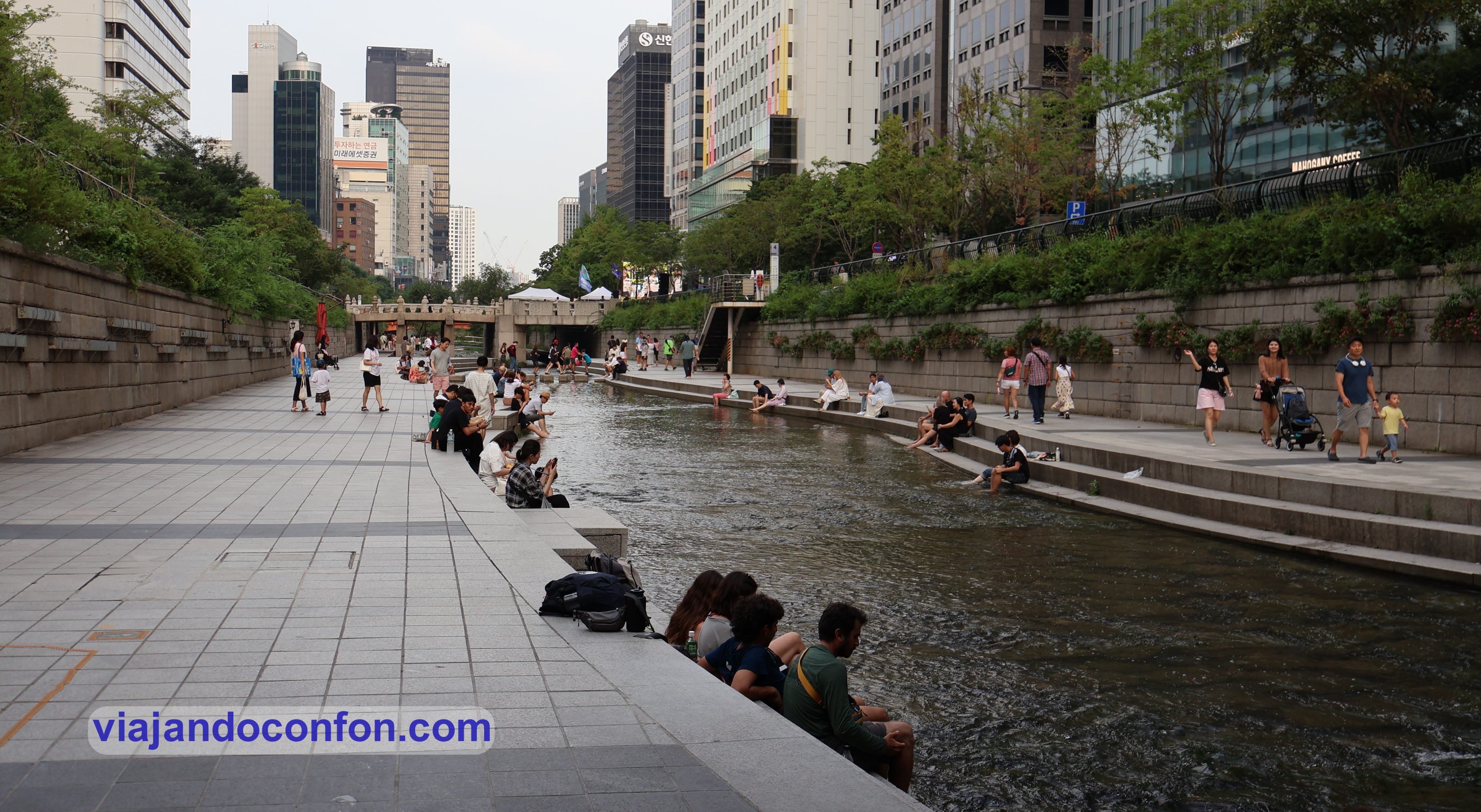
Cheonggyecheon Creek originates from Baekdongcheon Creek in the Inwansang Mountain Valley northwest of Gyeongbokgung Palace. It runs through the centre of Seoul and is almost 11 km long.
During the Japanese occupation, it was planned to cover the stream, but it was not realised. However, the project was realised between 1958 and 1978.
In 2003, the Metropolitan Government proposed a project to restore the area. In 2005, the restoration work was completed and about 5 km of the creek was repaired, leaving it as it is today.
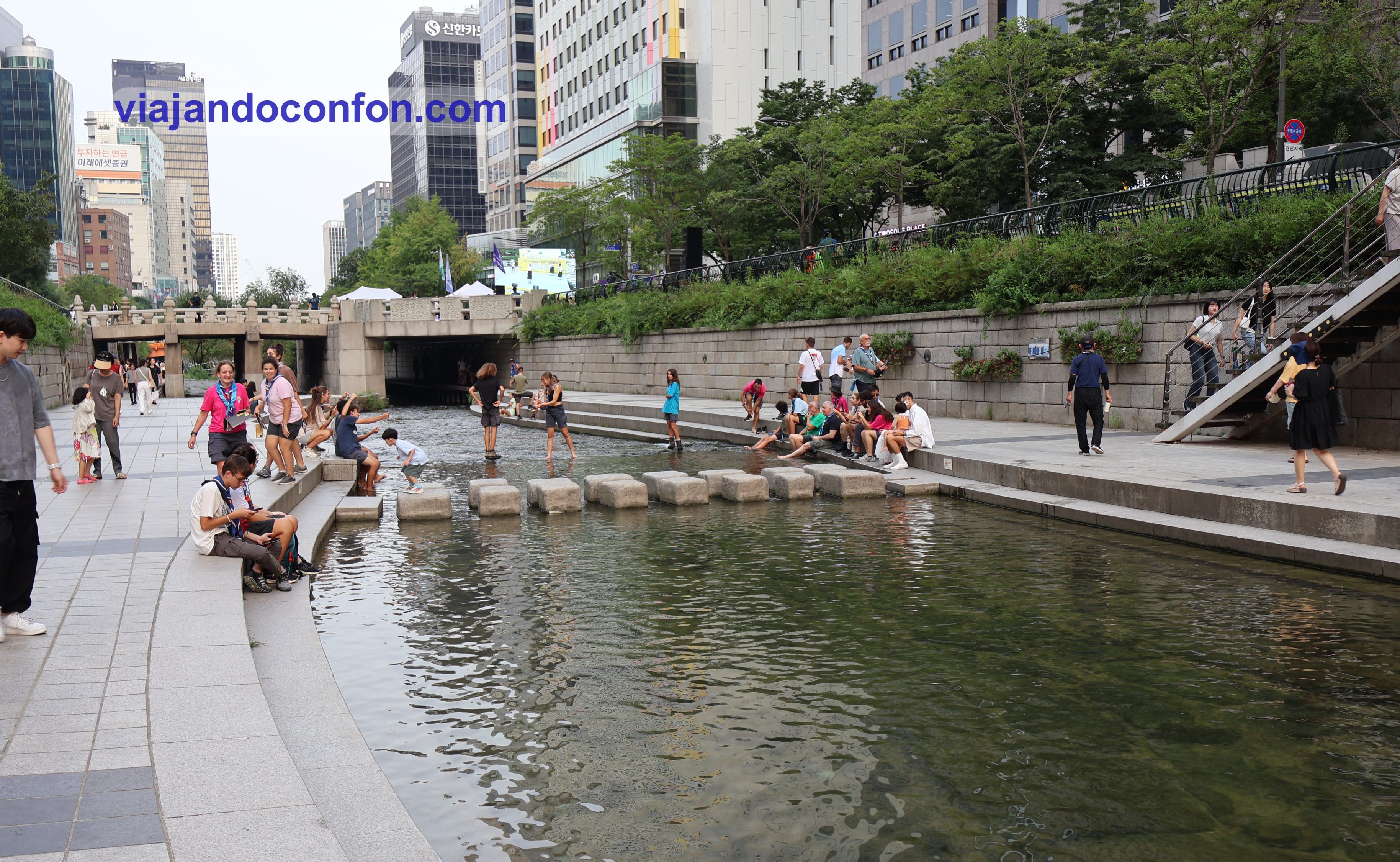
Here we decided to sit down for a while and soak our feet in the water to cool off a bit. If it wasn’t forbidden, I think I would have jumped in head first.
One custom that we found very funny was that many women walked down the street with their fringes in curlers. You don’t see it in Spain, nor in the many countries we visited.
One example:

Here we could hear the music of a nearby concert with what sounded like traditional songs.
After a well-deserved rest, we headed to nearby Gwanghwamun Square. It is the nerve centre of Seoul. You will pass this place a thousand times.
In 1395, King Taejo established the city of Hanyang. In front of the palace, numerous government buildings were built, forming Yukjo Street. Some of these buildings were seriously damaged during the Japanese invasion in 1592.
During the Japanese occupation in the early 20th century, Yukjo Street was renamed Gwanghwamuntong Street. In 1926, the Joseon General Government built the Korean General Government building here and extended the street.
The current square was renovated in 2009.
The first thing we come across, at the southern end of the square, is the statue of Admiral Yi Sun Shin. He was a Korean admiral and general who successfully defended his homeland from Japanese raids in 1592. He is also credited with the invention of the turtle ship, although he only modified an existing vessel.

In the centre of the square is the statue of King Sejong the Great who reigned from 1397 to 1450. Among his many achievements was the creation of the Hangul alphabet, today’s Korean alphabet. Until that time only the Chinese alphabet was used. Changing it brought culture closer to the Korean people.
He also contributed to the development of agriculture and science, the systematisation of medical techniques, music and law, and the expansion of the national territory.

At the back of the statue is the entrance to King Sejong’s exhibition hall. There is an exhibition on the achievements of Sejong the Great.
King Sejong is considered the most admired figure by Koreans and his image appears on 10,000₩ banknotes.
At the northern end of the square is the Gwanghwamun Gate, the entrance to Gyeongbokgung Palace. But let’s not get ahead of ourselves. We will talk about it later.
Those days there was some kind of event going on in the square. There were many food stalls, craft stalls and even a swimming pool. The pool was full to the brim.
The best thing was that there was a row of fans on display there, I don’t know why. But it was a good way to cool off…
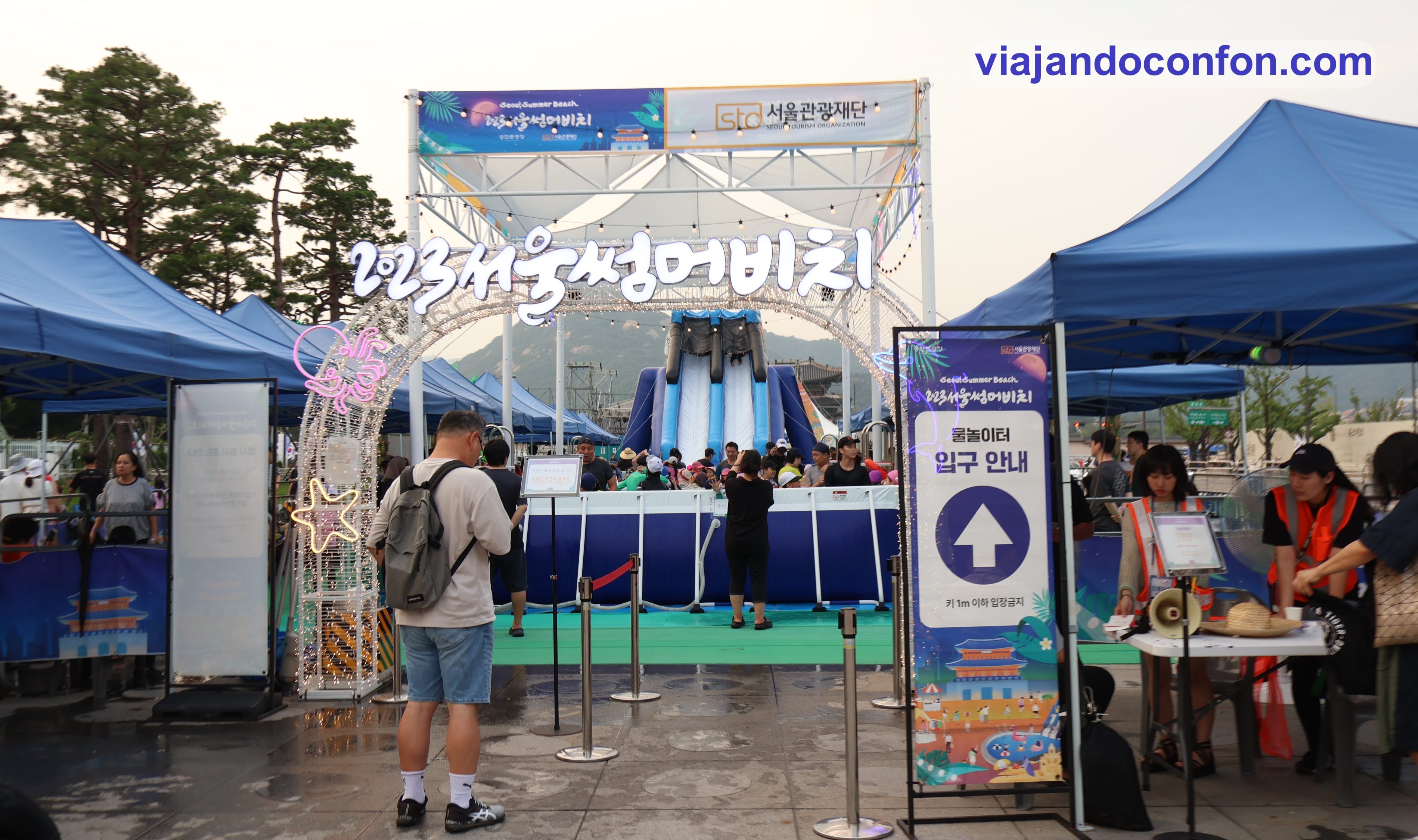
On one side of the square there is also a monument to the 40th anniversary of the enthronement of King Gojong, the penultimate emperor of Korea.

Across the road to the north of the square is the National Museum of Korean Contemporary History. It was opened in 2012 and is an institution affiliated with the Ministry of Culture, Sports and Tourism of the Republic of Korea, which oversees matters related to the collection, preservation, research, exhibition, education and exchange of modern and contemporary Korean history.

From here we took a walk back to the hotel. On the way we passed Dongshipjagak. It is a guard post that was located in the old wall, now disappeared and belongs to the Gyeongbokgung palace.
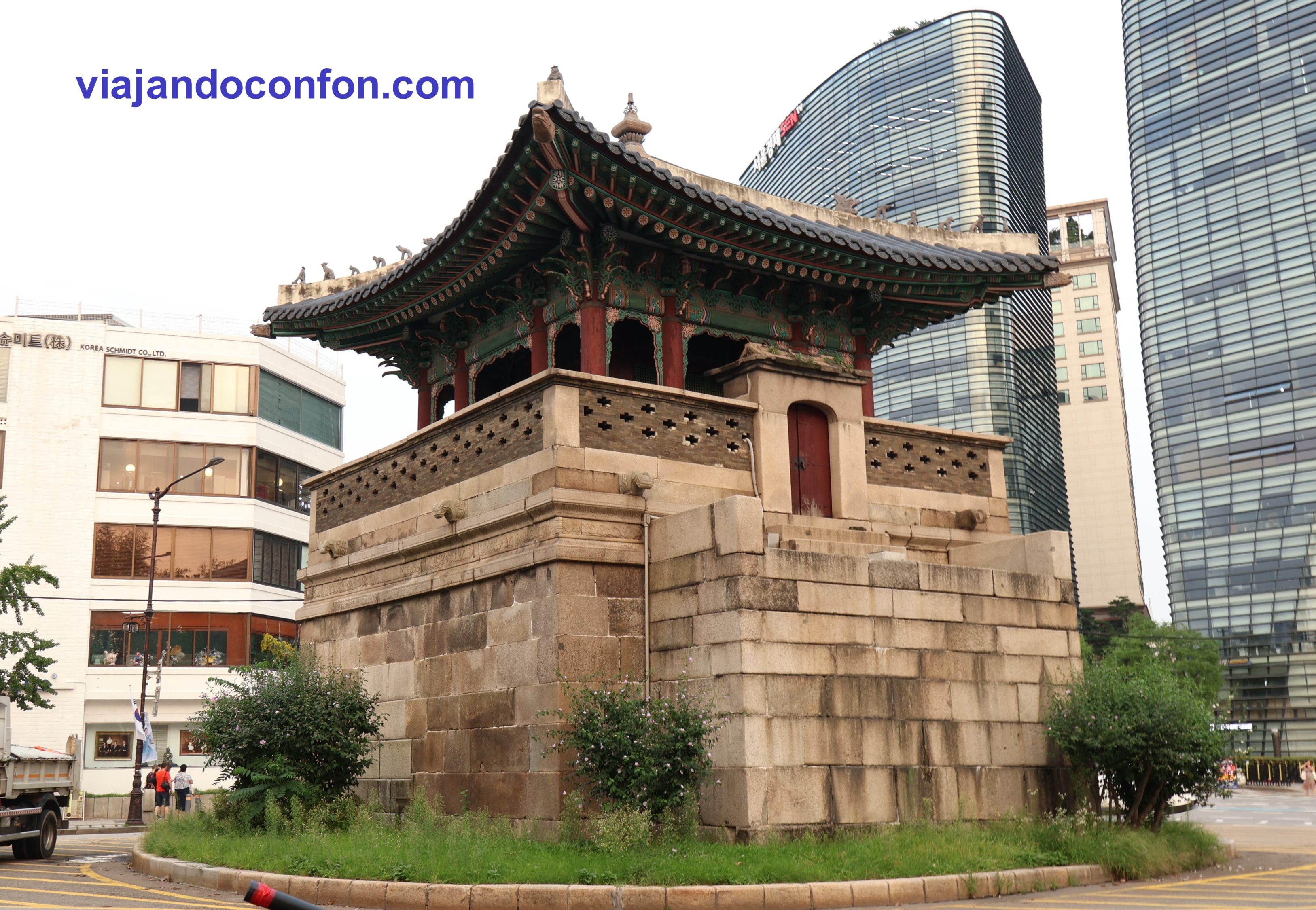
Nearby is the Beobryeonsa Temple. It was built in 1973 and is dedicated to its founder, Bodhisattva Beopryunhwa. It is a fairly modern building, although its upper part has the appearance of a traditional hanok.

Now we are. We go to the hotel. We buy some dinner at the supermarket and go to sleep.
August 14th
Today we have to get up early again. We pack our bags because today we move, for one night only, to the city of Sokcho, on the east coast of South Korea.
But that’s in the afternoon. Now we visit a bit more of Seoul.
After a light breakfast with things we had bought at the supermarket the night before, we head to the spectacular Gyeongbokgung Palace.
The palace was inaugurated in 1395 three years after King Taejo founded the Joseon dynasty. It was built when the capital was moved from Gaeseong to Hanyang (present-day Seoul). Its name means “Palace Greatly Blessed by Heaven”.
The first thing you come across is the Gwanghwamun Gate, the main gate of the complex.

The king used the central arch, while the crown prince and officials entered through the openings on either side. A bell in the gate pavilion announced the time of day.
During the bombings of the Korean War (1950-1953) the wooden pavilion was destroyed and the stone wall severely damaged. It was rebuilt in 1968 as a concrete structure, but restored to its original form as a wooden and granite structure in 2010.

Entering through the gate you come to a huge esplanade where the ticket booths are located. The price is 3,000₩ (€2.10) and is included in the Royal Palace Pass. It’s also free if you’re in traditional dress. In fact, there is an exclusive line for these people.
In any case, attending the concourse and the changing of the guard is completely free.
It is on this vast esplanade that the changing of the guard takes place every day (several times). But before that, on a small outdoor esplanade, outside the Hyeopsaengmun gate, a military training simulation is held. The Sumungun military training. That’s where we went.
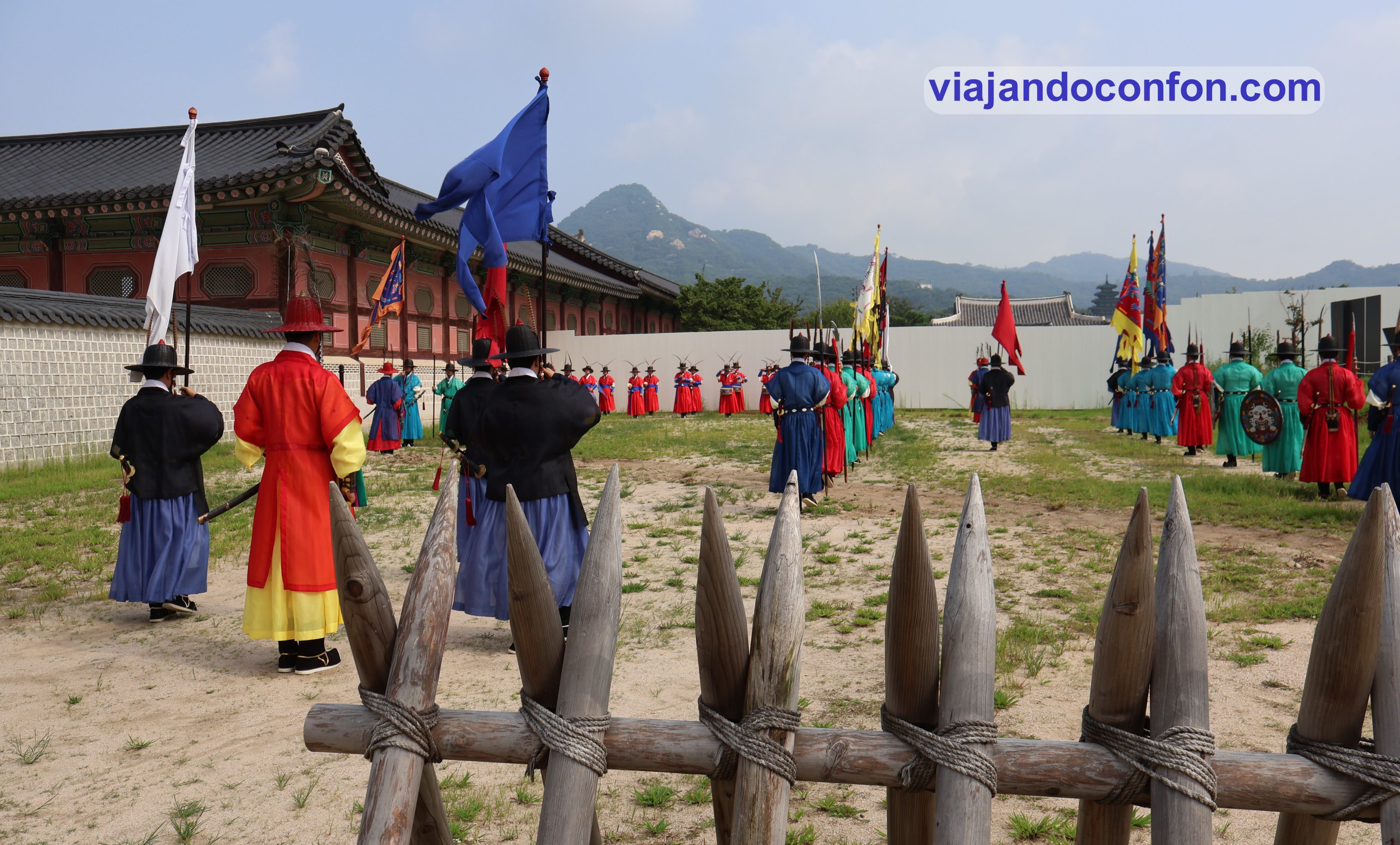
As soon as it was over, we returned to the esplanade, where the changing of the guard was about to begin. We positioned ourselves well and enjoyed the spectacle.


Once the show was over (it lasted about 20 minutes), we were ready to enter the palace. But after the changing of the guard, there were about a million people trying to get in at once.
We walked around a bit while the entrance was clearing up a bit and off we went. The entrance is through the Heungnyemun Gate.
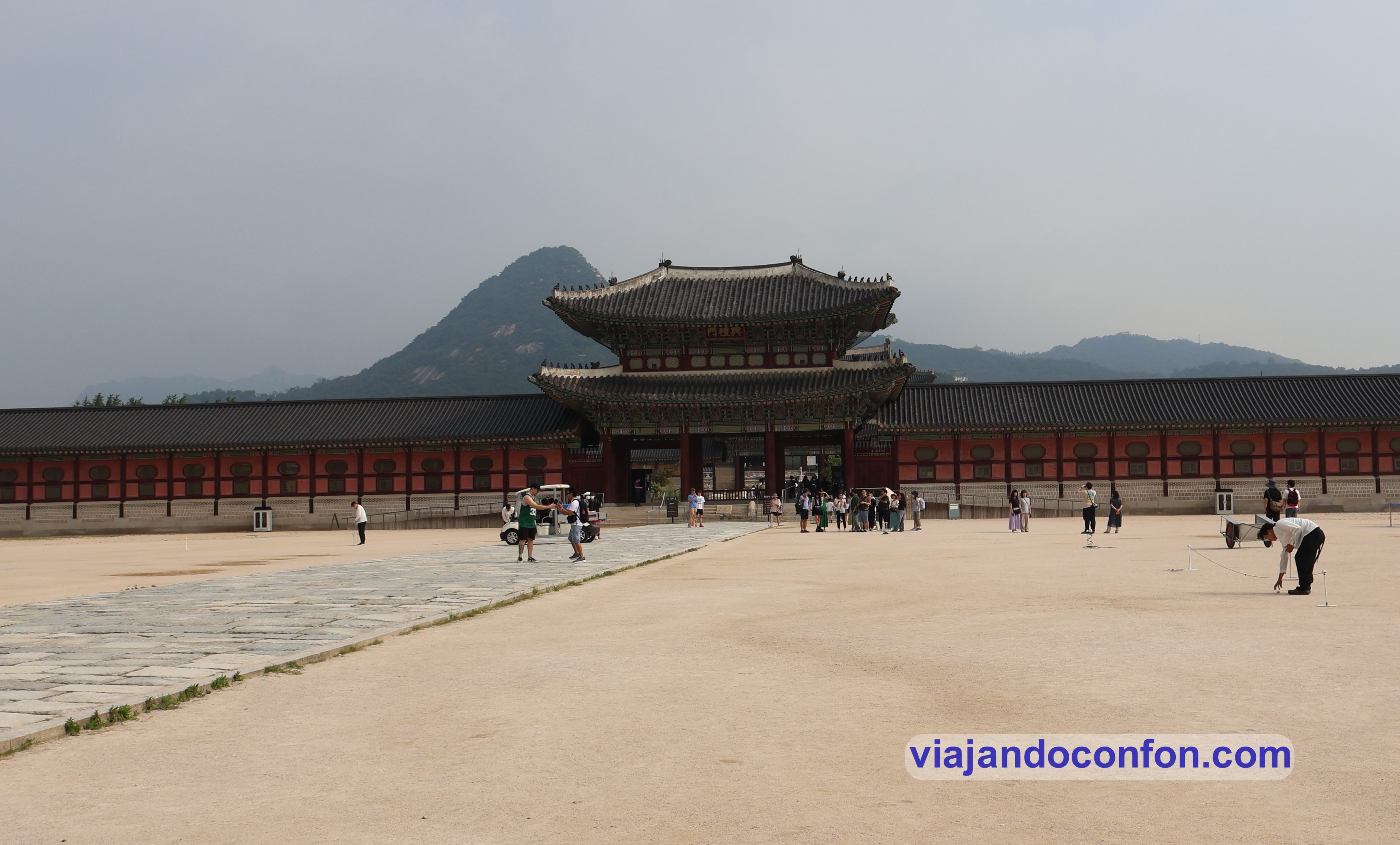
We pass through the gate and enter another esplanade. This is crossed by the Geumcheon Stream, which is designed to flow through the palace from west to east after descending from Mt Baegak.
The stream is crossed by Yeongjegyo Bridge. In the background is Geunjeongmun Gate.
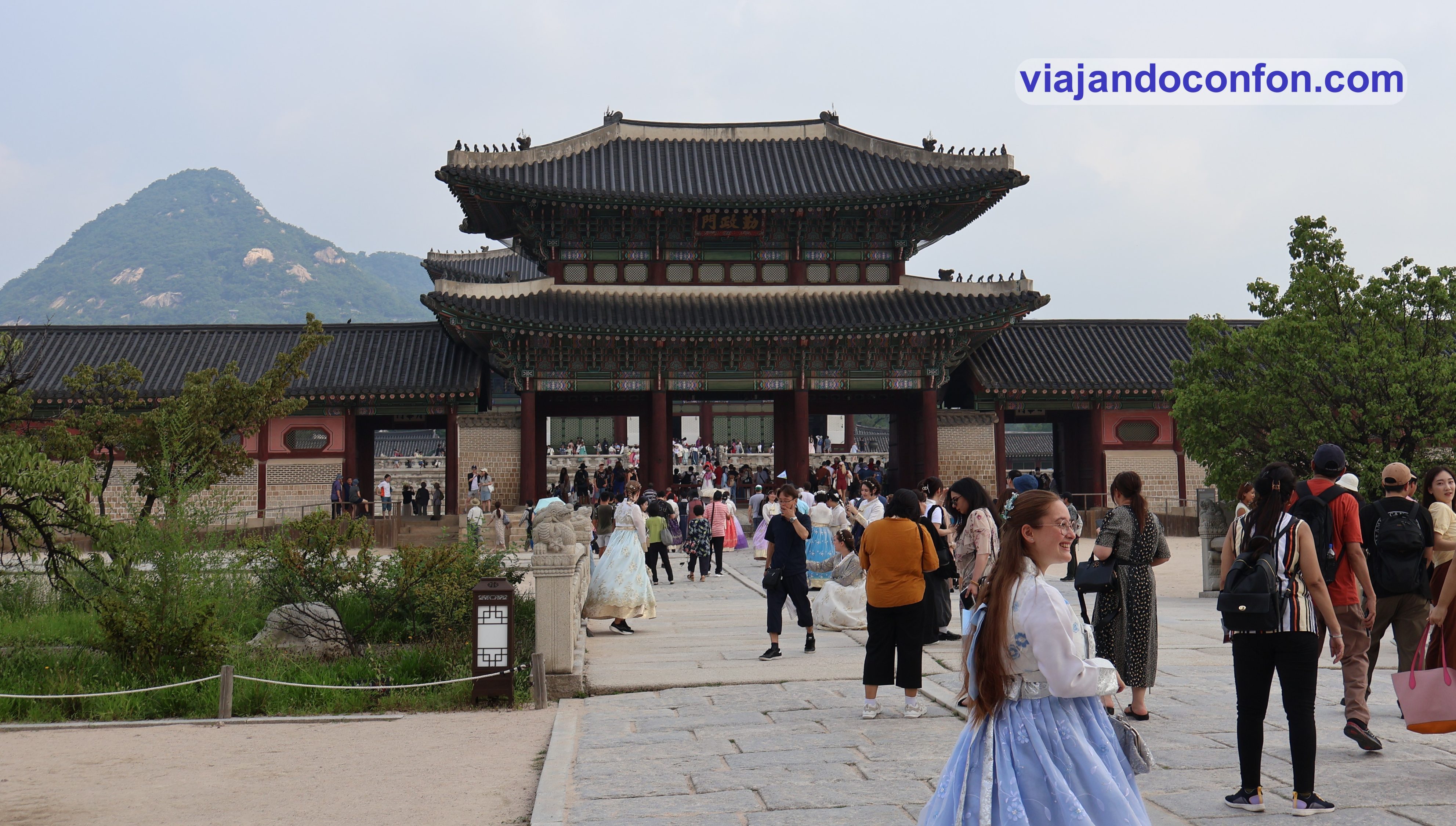
Beyond the gate is Geunjeongjeon. This is the central palace building where the subjects greeted the king on New Year’s Day, held national ceremonies and received foreign envoys.
It was built in 1395, although the present building is a reconstruction from 1867.

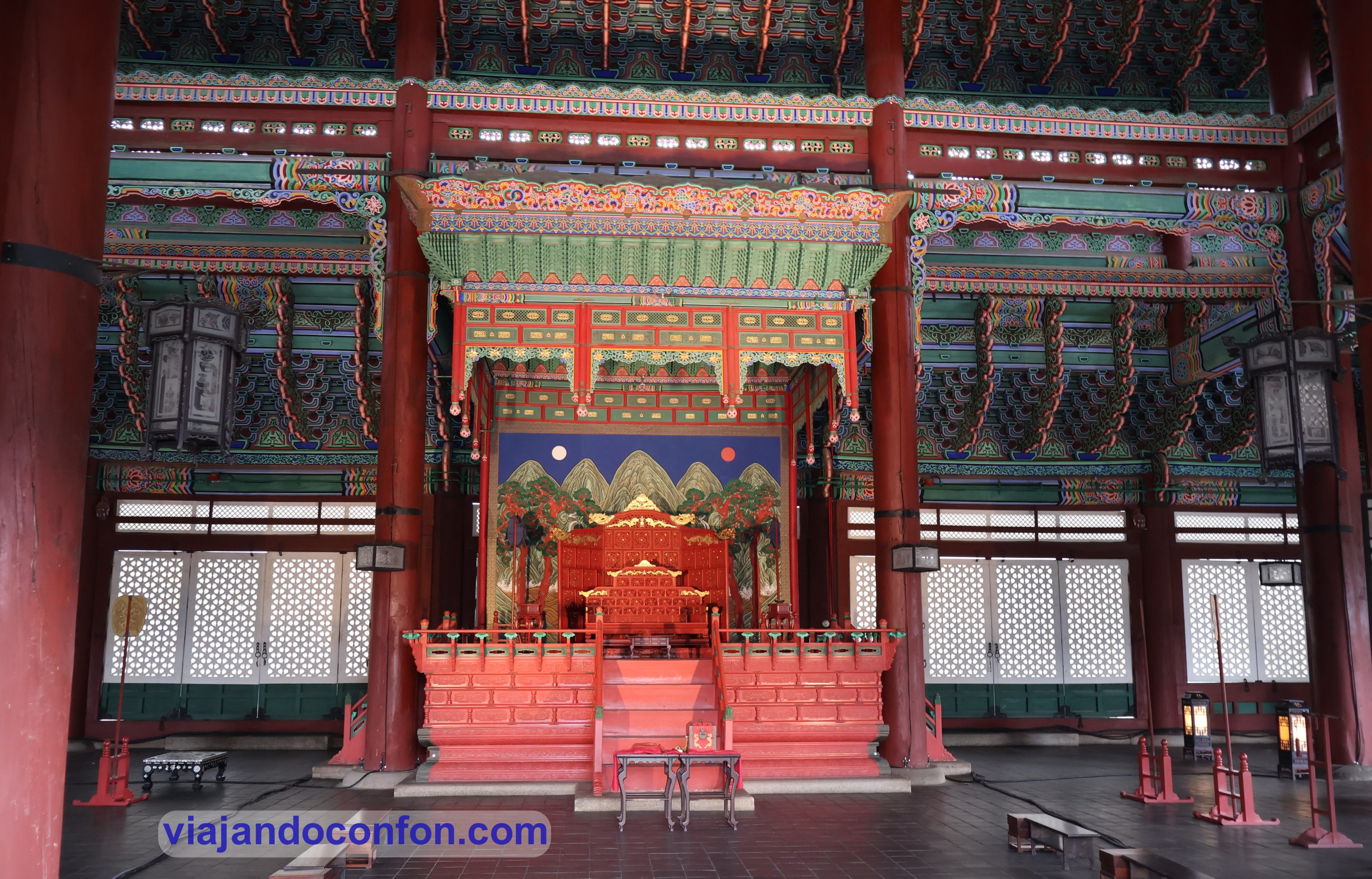
We leave through a small gate to the west of the Geunjeongjeon forecourt and go to the Sujeongjeon Pavilion.
It is located in the grounds of the former Gwolnaegaksa Temple and was the seat of civil affairs, including the establishment of the Hangul. It was also an institution that conducted academic research during the reign of King Sejong and advised and suggested important policies to the king.
Sujeongjeon is the only surviving building of Gwolnaegaksa Temple.

Behind it is Gyeonghoeru. It is set within a large pond and was a place where banquets were held when auspicious events occurred or envoys visited the country.

We re-enter the palace grounds and move on to Sajeongjeon. This was where the king worked on state affairs, including morning council meetings, administrative reports and discussions, and policy formulation with government officials.
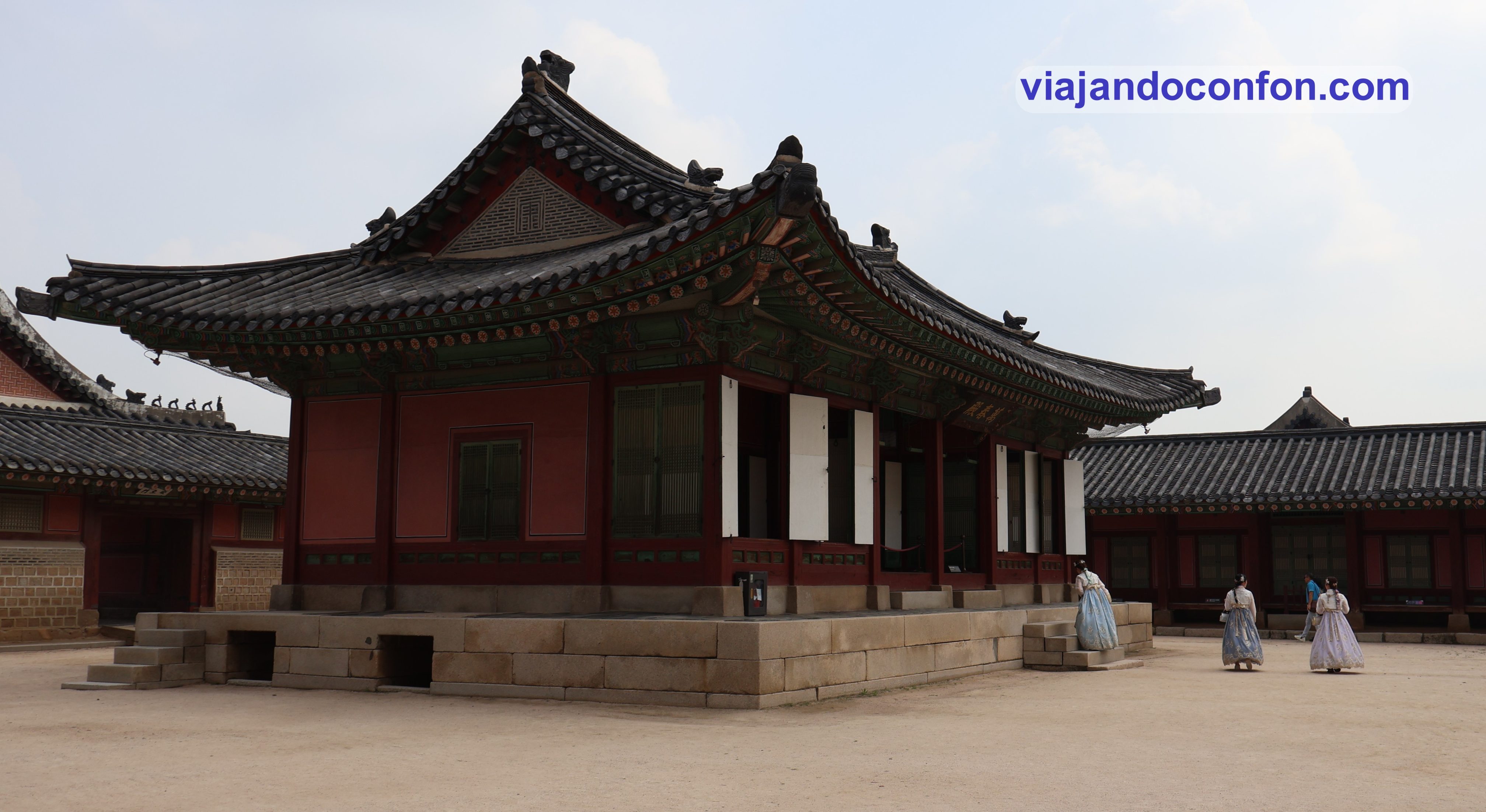
Behind, through another gate is Gyotaejeon, the queen’s quarters. To one side is Jagyeongjeon, the King’s mother’s quarters.

We visited a lot more buildings but they were all closed. We went out from the north onto a large esplanade. Here we found the Jipgyeongdang Hall. This was where the king’s concubines stayed.
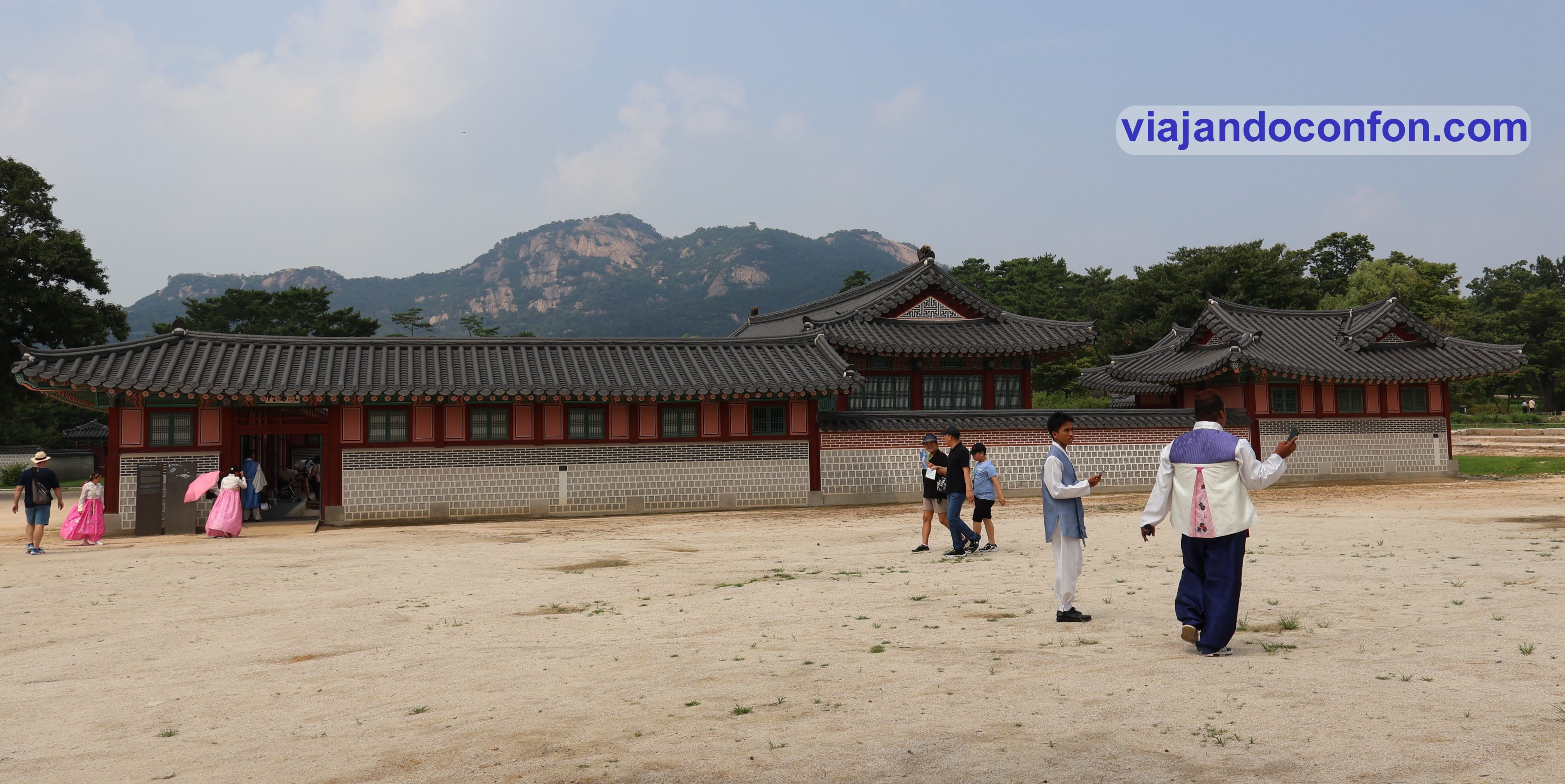
Behind it is the beautiful Hyangwonjeong Pavilion in the centre of a large pond.
In 1873, King Gojong built Geoncheongung Palace in the northern part of Gyeongbokgung to assert his political independence from his father, Prince Regent Heungseon. This northern palace included rooms for the king and several dormitories.
It was here that a tragic chapter in Korean history was recorded in 1895, when Empress Myeongseong was assassinated by the Japanese.
Originally, the Chwirojeong Pavilion stood on the islet in the centre of the pond and was replaced by a hexagonal pavilion called Hyangwonjeong when Geoncheonggung was built.
It makes for a beautiful landscape.

At the northwestern end of the compound are Jibokjae and Hyeopgildang.
After Gyeongbokgung Palace was severely damaged by fire in 1876, King Gojong moved temporarily to Changdeokgung Palace.
He returned here in 1888 and spent his time at Geoncheonggung. Jibokjae (Jade Gathering Hall) and Hyeopgildang Pavilion were moved from Changdeokgung Palace to positions west of Geoncheonggung.
These buildings were used as a library and reception hall to receive foreign envoys.

This is the end of our visit to the spectacular Gyeongbokgung Palace. All that remains is to exit through Sinmumun Gate.

We leave the palace and, crossing the street, we come across Cheong Wa Dae or The Blue House. This is the former executive office and official residence of the president of South Korea from 1948 to 2022.
Cheong Wa Dae is a complex of multiple buildings constructed largely in the traditional Korean architectural style with some modern architectural elements and facilities.
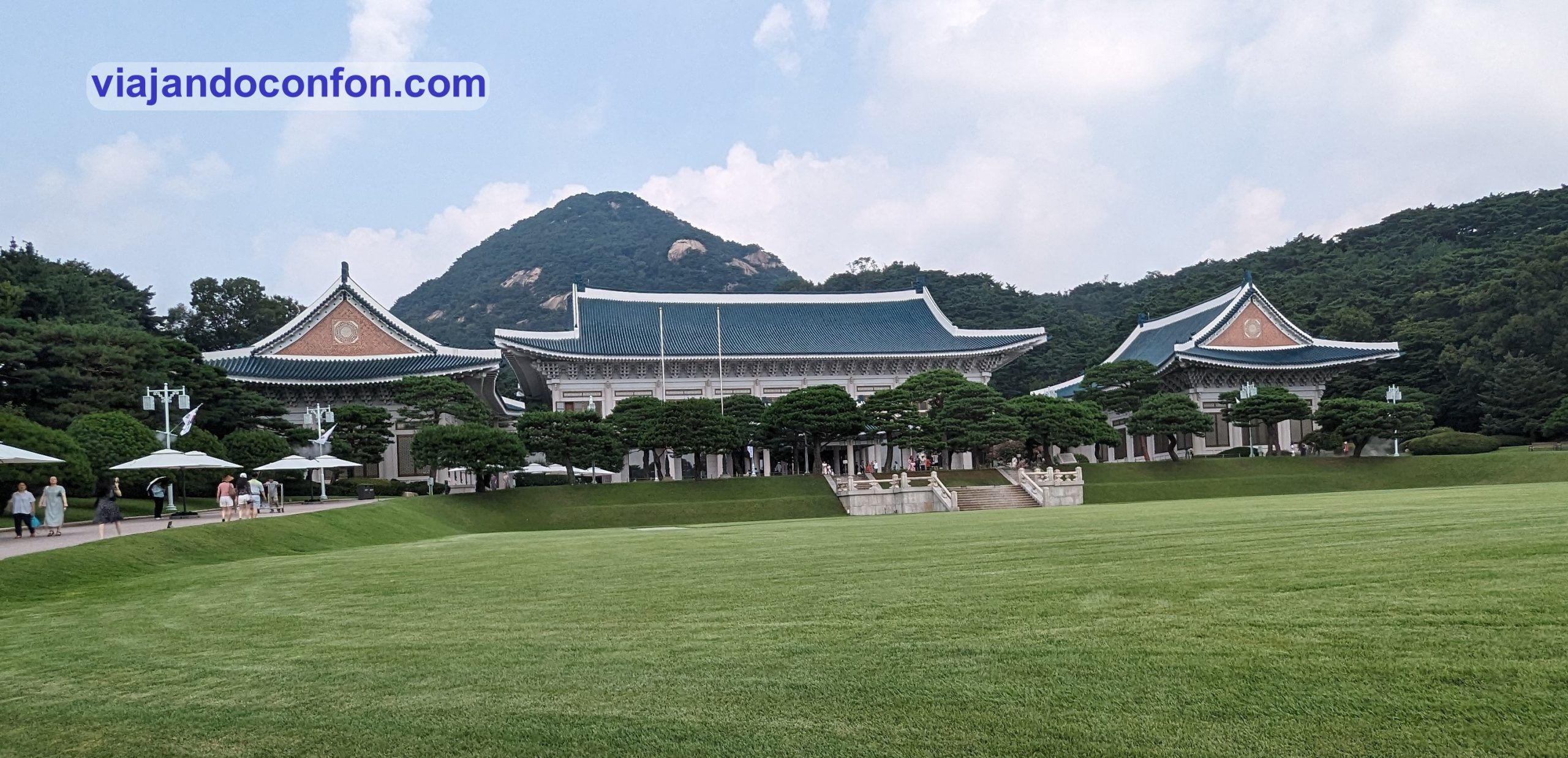
It was formerly the site of the Joseon dynasty’s royal garden dating back to 1426. The complex burned down in 1592 during the Japanese occupation and remained abandoned for 270 years.
In 1865, Prince Regent Heungseon began reconstruction in the second year of King Gojong’s reign.
During the Japanese occupation in the early 20th century it was used to hold the Joseon Exposition from 1937 to 1939 and later served as a park before the official residence of the Japanese governor-general was built on the site.
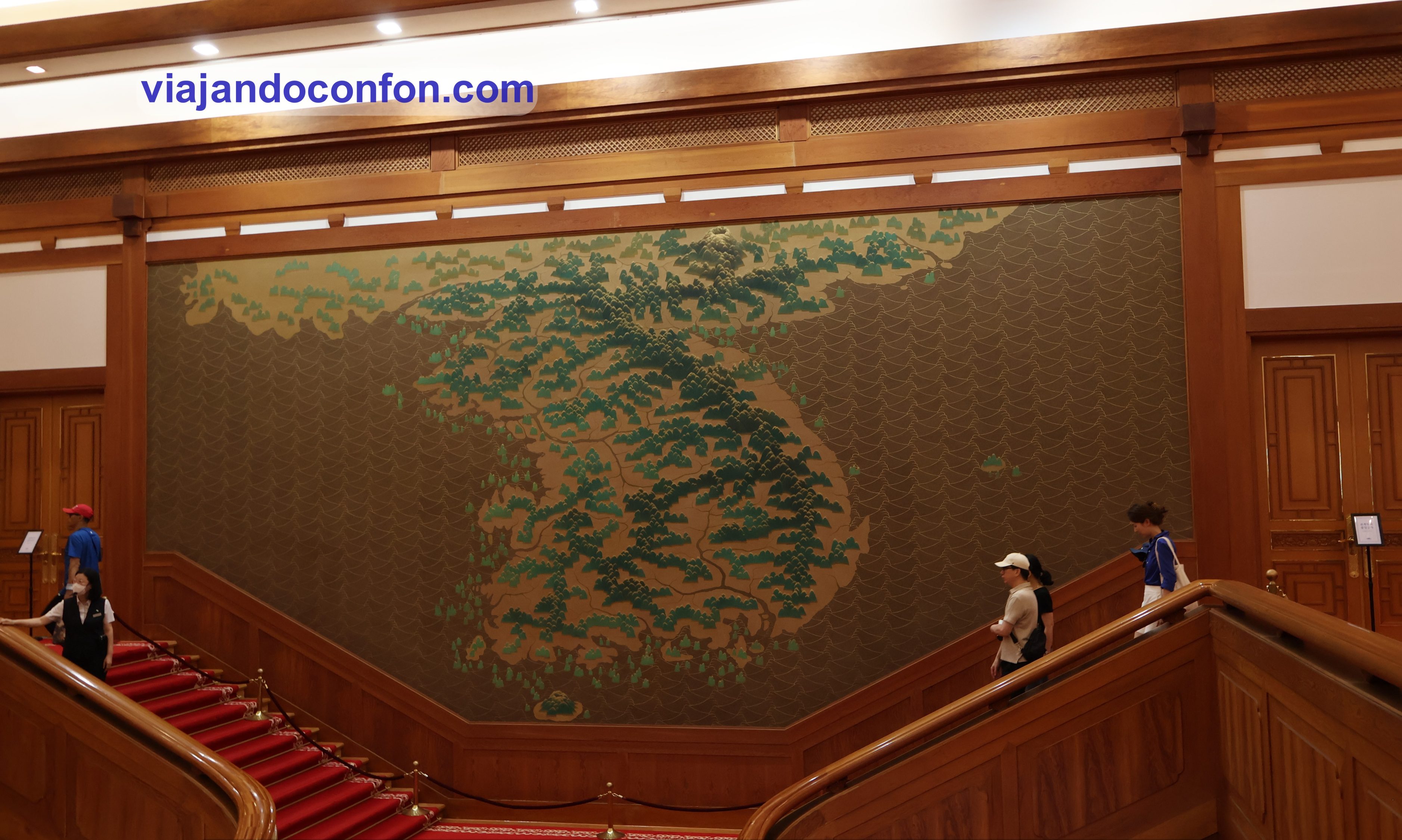
After registering our passports at the entrance and passing a strict security check, we enter the grounds. The gardens are beautiful.
We go through another security check into the building and visit the offices and various rooms, which include a collection of objects used by the different presidents and the president of South Korea, portraits of everyone and photos of the first ladies… and even a security guard sleeping in a chair. The poor guy must have had a bad night.
By the way, admission is free.
From here we took a nice, hot walk to the National Folk Museum of Korea. It was founded in 1946 and is a museum representing Korean daily life and culture. It is visited by more than two million people every year.
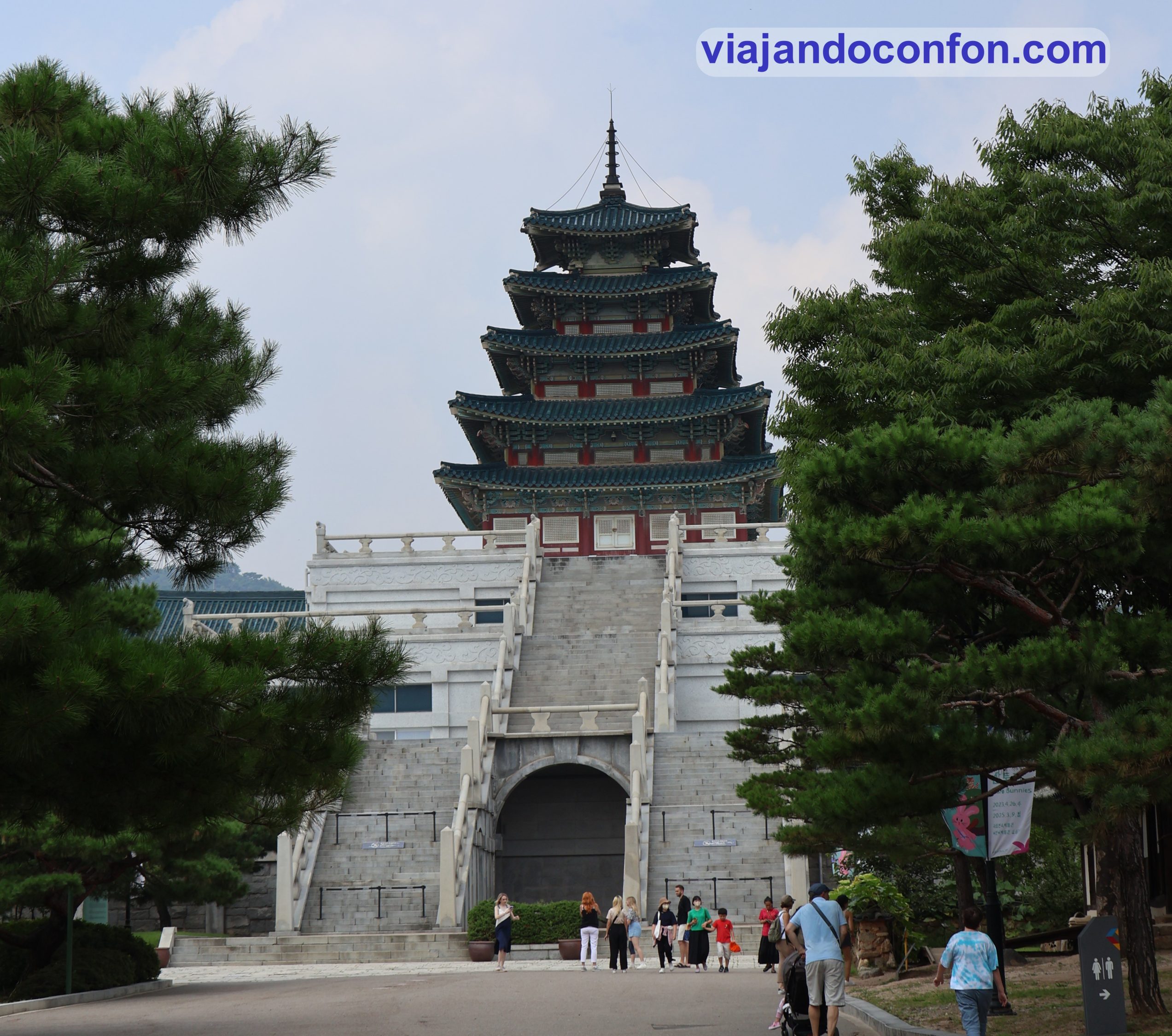
The beautiful building alone is worth a visit. You can also see many exhibits in the gardens.
It was getting late in the afternoon and the rain was beginning to take its toll. As we had to take a bus to transfer the camp, we decided not to complicate our lives. We ate at the same Korean barbecue restaurant as a couple of days ago. It was close to the hotel, too.
Today it was very crowded but the service was just as good and the food just as spectacular.
After lunch we picked up our stuff at the hotel and went to the Express Bus Terminal. Our new destination is the city of Sokcho, on the east coast of South Korea.
At 15.40 we take the bus. It is about 3 hours to our destination, but that is information for the next entry.
Discover the best activities and tours in Seoul with Civitatis:
Back to Asia, this time we visit South Korea.
On the way to South Korea: Stopover in Helsinki
To travel to Seoul, we chose the Finnish airline FinnAir. It was the best value for money but it was really a mistake. With the closure of Russian and Ukrainian airspace due to the invasion of Ukraine, the flight made a big detour, taking 12 hours one way and 14 hours return.
The plane was quite comfortable but another negative aspect was the food. 2 meagre meals for such a long flight. On the way out we were hungry as hell.

We learned our lesson and on the way back we didn’t take a few sandwiches and a bunch of junk with us. On the way back, there was a gap of more than 8 hours between the two meals. Very, very bad.
August 8th
At 20.15 in the evening we took off on time from Malaga airport. Four and a half hours later we landed in Finland. It was 1.45 in the morning there.
The stopover is long: 16 hours. That’s why I decided to book a hotel near the airport. The Holiday Inn Vantaa Airport. It cost us 119€. The hotel was simple and comfortable but quite old.
Find your ideal hotel in Helsinki at the best price on Agoda:
But there was an unforgivable issue with the hotel. Before I booked it, through the chat on their website, I asked if there would be any problem with the free transfer they offer at the time the flight landed. I was told there would be no problem.
Two days before arrival, I contacted them again to remind them of the time. It turned out that the last transfer trip was at 1.10am. So they screwed me. 19€ taxi fare to get there and the taxi driver’s annoyance at such a short journey.
August 9th
We get up at about 10 am and have breakfast with some biscuits that we had brought along. We put on our swimming costumes and went in search of the Finnish sauna that I had seen in photos of the hotel.
Well, that’s another lie. There is no sauna. We go back to the room, pack our things and check out.
We go to the shopping centre which is a 10-minute walk from the hotel for a stroll. We took the opportunity to have an early lunch.
We ate in an American themed place from the 50’s called Classic American Diner. Very good burgers at a good price for Finland. It cost us 45.38€.
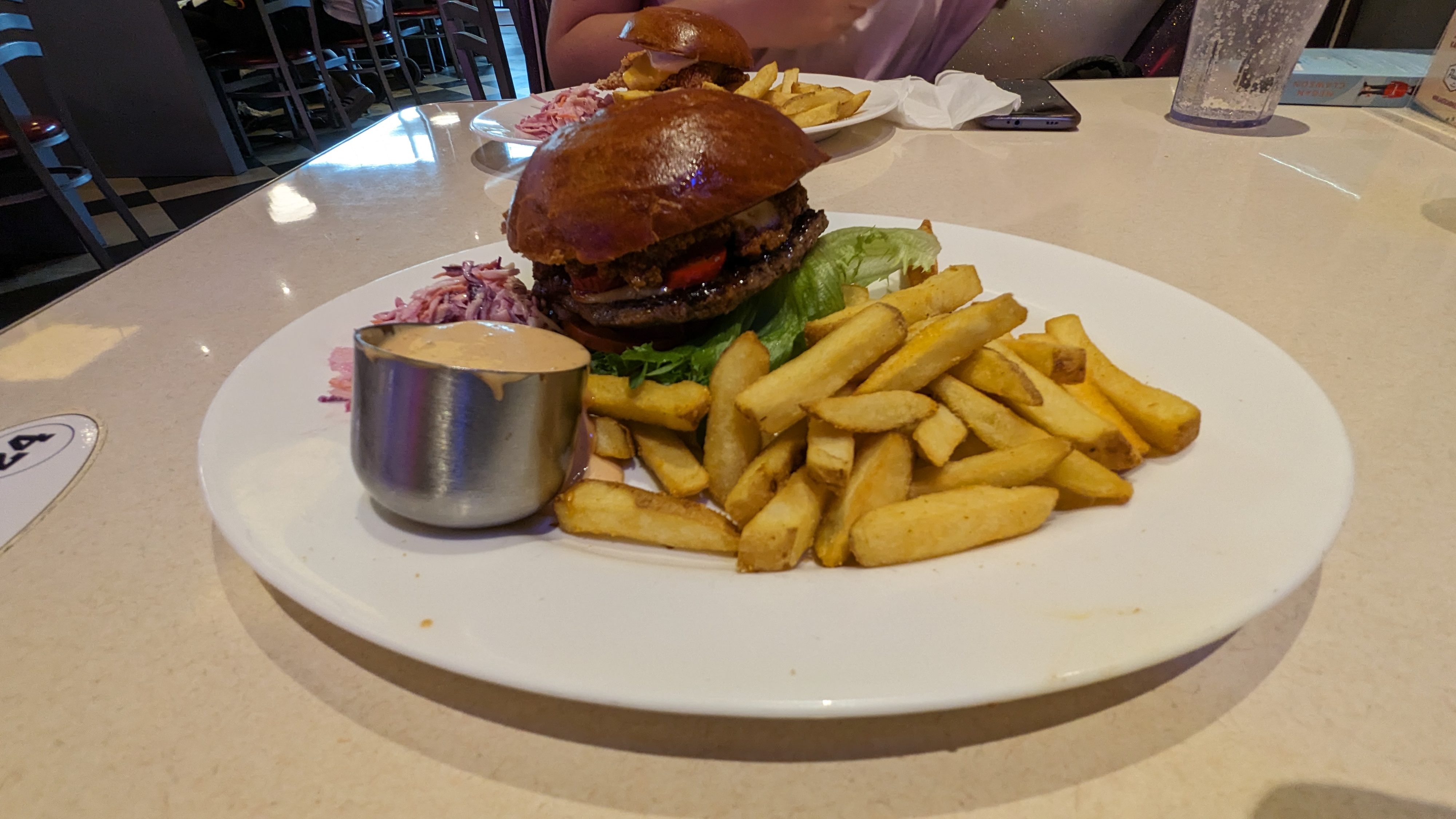
After lunch we return to the hotel to take the transfer to the airport.
At 17.30 the flight to Seoul leaves on time. We have 12 hours and 50 minutes to get to the South Korean capital.
August 10th
Around 11 am we finally landed at Incheon International Airport. Exhausted and hungry, we get off the plane, go through immigration and pick up our bags. It takes forever for them to come out.
We go straight to take the AREX express train. It takes 40 minutes to travel the 60 km from the airport to Seoul station. The ticket costs 9,500 won (6.60€).

We left the station on our way to the hotel and… Seoul greeted us with rain. We were in the middle of a typhoon in South Korea and it was going to last for a couple of days.
Buy your Arex Express ticket conveniently at the following link:
Curiosity number 1 as soon as we arrived in Korea. At the central train station on the way to the underground, we found conveyor belts for the suitcases to overcome the flights of stairs. Very convenient.
If you prefer more comfort, you can hire an efficient transfer service:
With all the rain and the exhausting plane ride, we decided to take a break and have something to eat at the hotel. We chose the Ibis Ambassador Seoul Insadong. 2 stars for 80€ a night.
It was to be a busy stay, which we will explain later. We were given a room on the 10th and last floor. In line with all the Ibis in the world and with a good view of Insadong Hanok Village.
Find your ideal hotel in Seoul at the best price on Agoda:
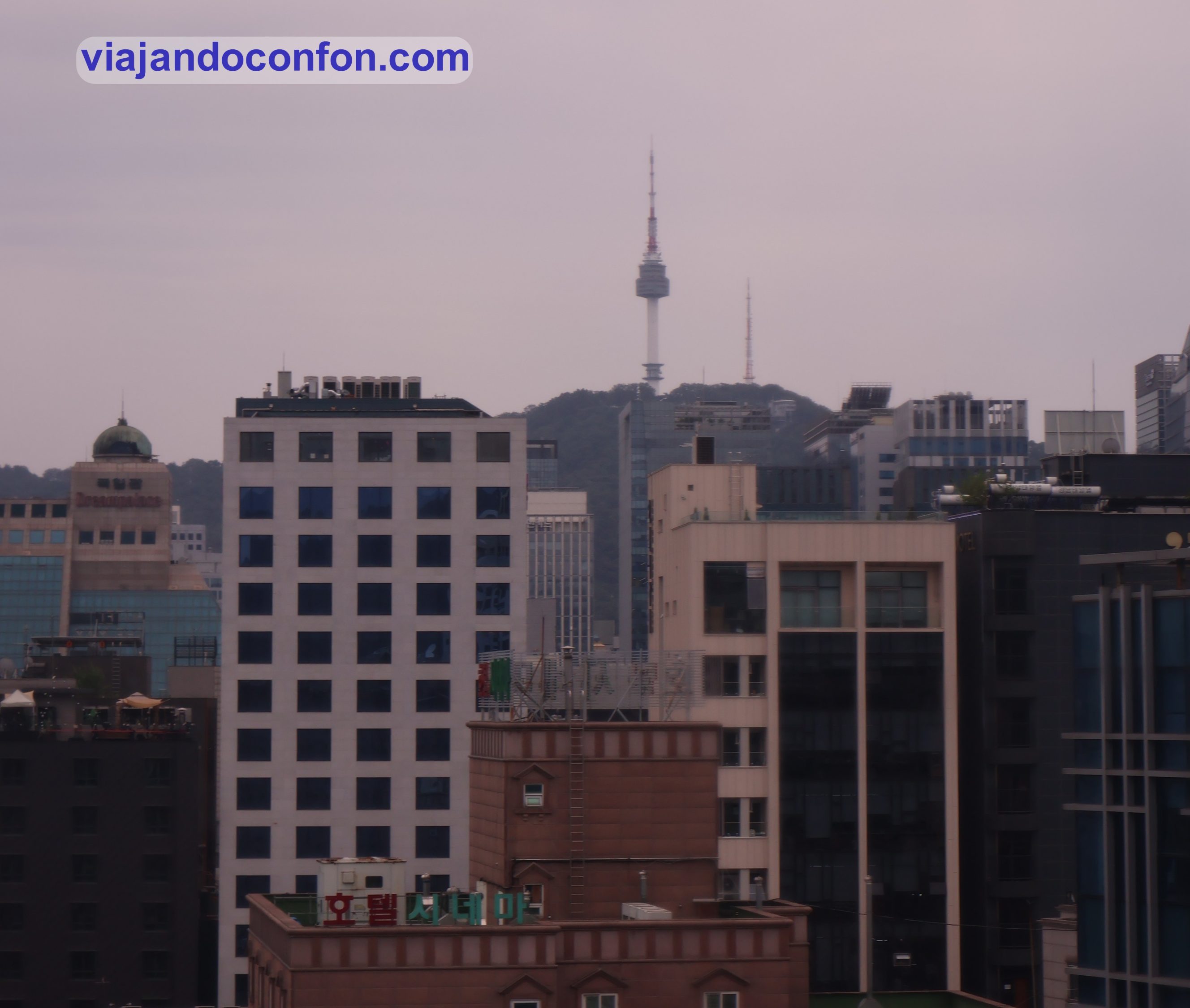

After a short break, we set out for a short walk to get a feel for the city. We went to Gwanghwamun Square, the nerve centre of the South Korean capital.
Unfortunately, the typhoon took a toll on our small umbrellas and we had to buy bigger and stronger ones. Even so, the tiredness and the water took its toll on us. We decided to buy some dinner in a combini and went to rest.
Tomorrow is another day.
11th August
We get up early to make the most of the day. I look out of the window and… it’s still raining. We have some breakfast that we had bought at the supermarket and we set off.
We set off for the nearby Changdokkung Palace Complex.

Fortunately the rain respected us from time to time. At times it rained heavily, at others a little, and at some (very short) moments it stopped raining.
We went to the office next to the palace to get our tickets. We bought the Royal Palace Pass. It costs 10,000₩ (7€) and gives us access to five palaces and temples, including the Secret Garden. The pass is valid for 3 months from the date of purchase.

The individual price of the Palace is 3,000₩ (€2) and if you want to visit the Secret Garden (a must) you must add a supplement of 5,000₩ (€3.50). As you can see, these two tickets almost cover the total price of the Royal Palace Pass.
Changdeokgung Palace was a favourite of the kings of the Joseon Dynasty (1392-1910) because of its spacious and beautiful back garden.
It was built as a secondary palace for the Joseon in 1405. After its destruction during the Japanese invasion (1592-1598), it was rebuilt in 1610 and served as the main palace for about 270 years.

Injeongjeon Hall is the throne room, which was used for more formal state events such as ministerial audiences, coronation ceremonies and receptions for foreign envoys.

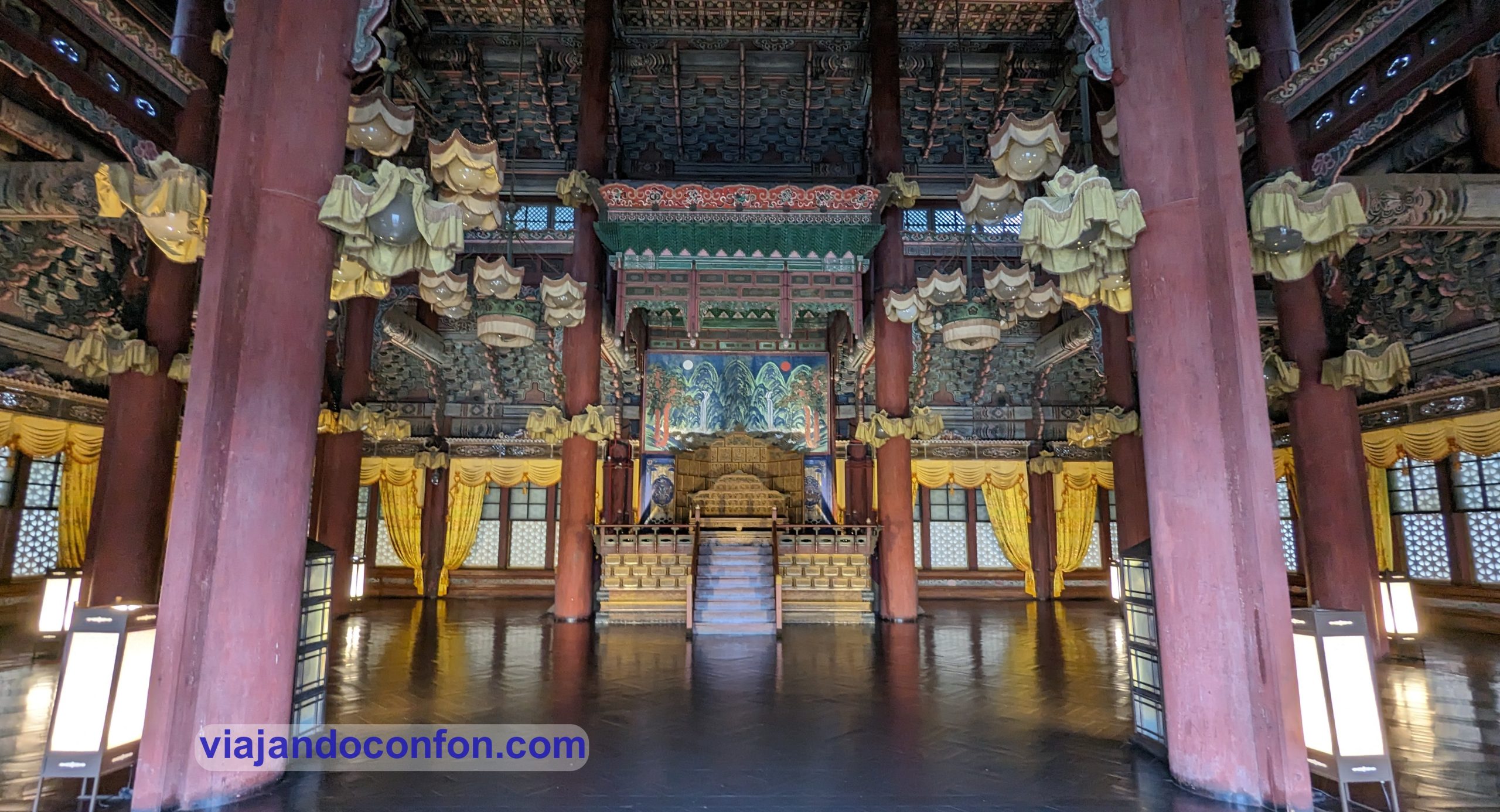
Seonjeongjeon Hall is the ruler’s council hall and the only remaining structure in Changdeokgung Palace with a blue-glazed tile roof.
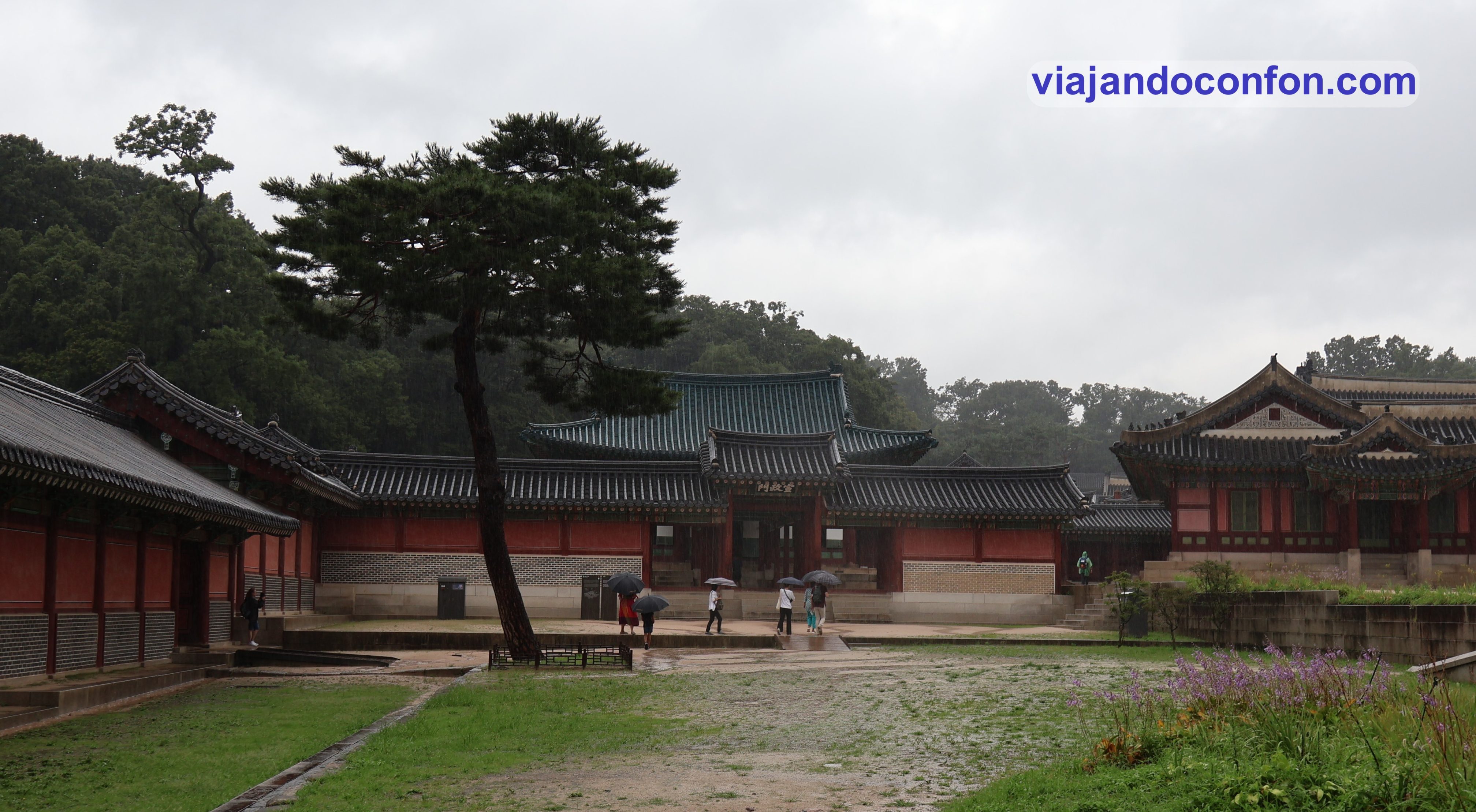
The king’s residence is Huijeongdang Hall, while the queen’s residence is Daejojeon Hall, Huijeongdang Hall was more than a royal bedroom; the king also worked there informally.
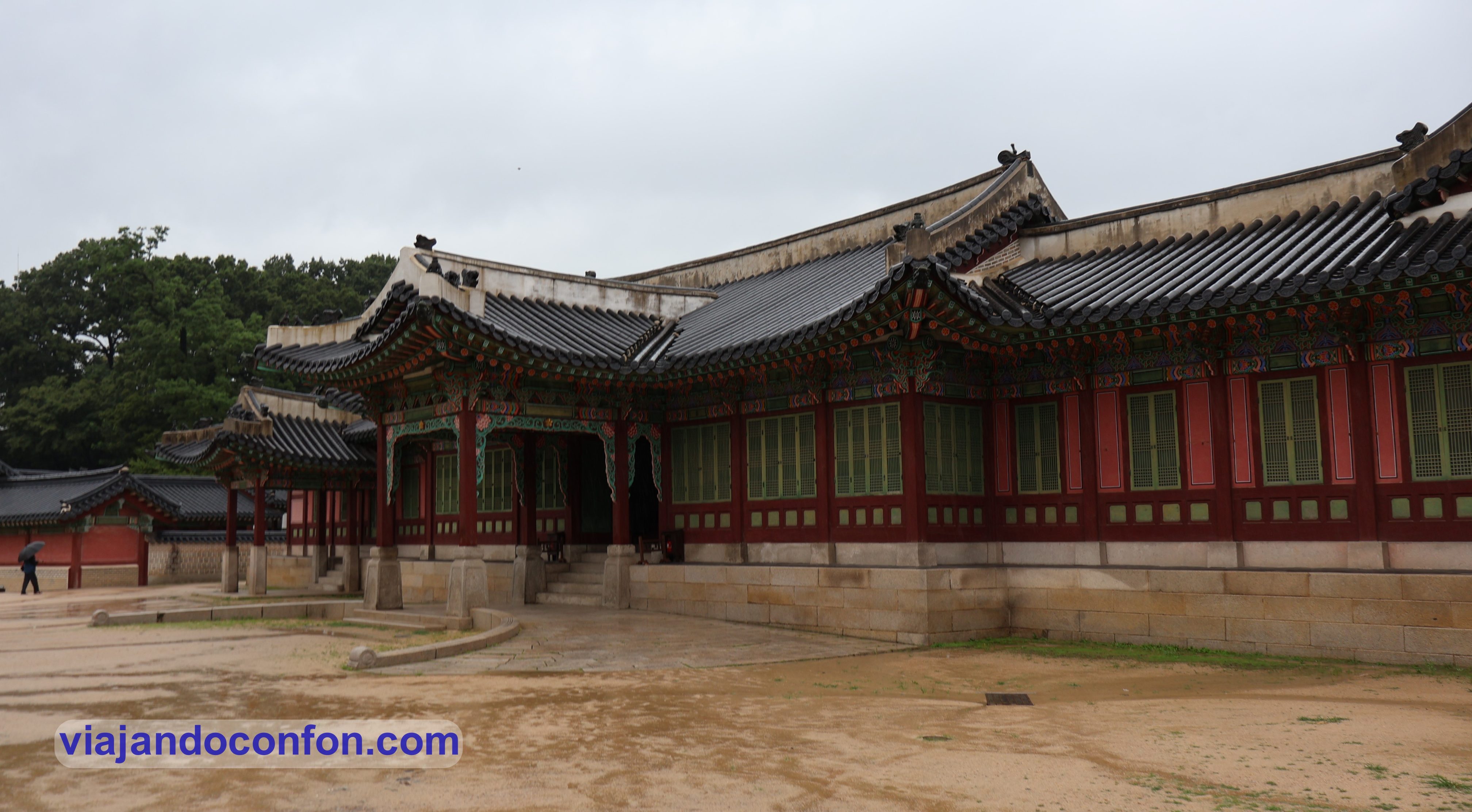
After visiting this first part of the complex, we went to the meeting point to visit the Secret Garden. Currently the garden can only be visited by guided tours. We had an appointment at 10 o’clock.
The Secret Garden was intended as a place for kings and members of the royal family to relax. But it was also a place for various outdoor activities.
The early Joseon kings participated in military exercises here, and archery competitions were held here. There were also banquets for the queen dowager, prominent relatives of the king and high-ranking ministers.
The Secret Garden occupies almost 60% of the total area of Changdeokgung Palace, and in the old days even tigers occasionally made an appearance.
The spectacular scenery of the Buyongji Pond area is striking. This was not there in the early days of the palace. It was built in 1707. It survived the Japanese colonial period and the Korean War without being demolished.
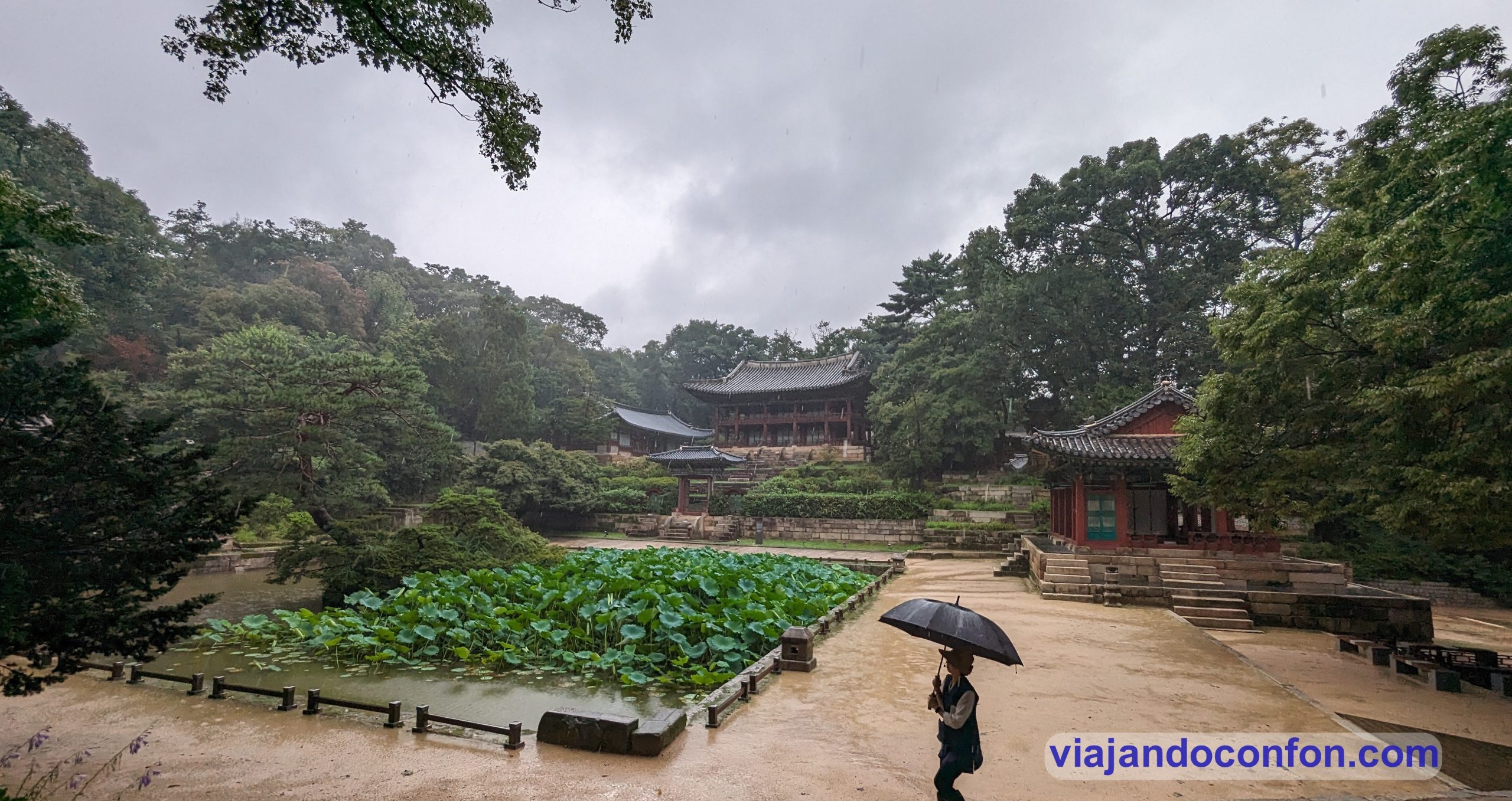

We leave the impressive gardens and head for Nakseonjae Hall.
Nakseonjae Hall is the place where King Heonjong, 24th king of Joseon, built for the concubine he really loved. It was built in 1847.
It is located in the area between Changdeokgung Palace and Changgyeonggung Palace and includes the Seokbokheon and Sugangjae Halls, as well as stone staircases decorated with interestingly shaped stones and flowering trees on the gently sloping hills behind the buildings.
After the 1884 coup, Nakseonjae was used as the king’s office for a time.
The last crown prince of the Joseon dynasty, Yi Eun, lived here from 1963 to 1970. His wife, Yi Bangja, also lived here from 1966 to 1989.
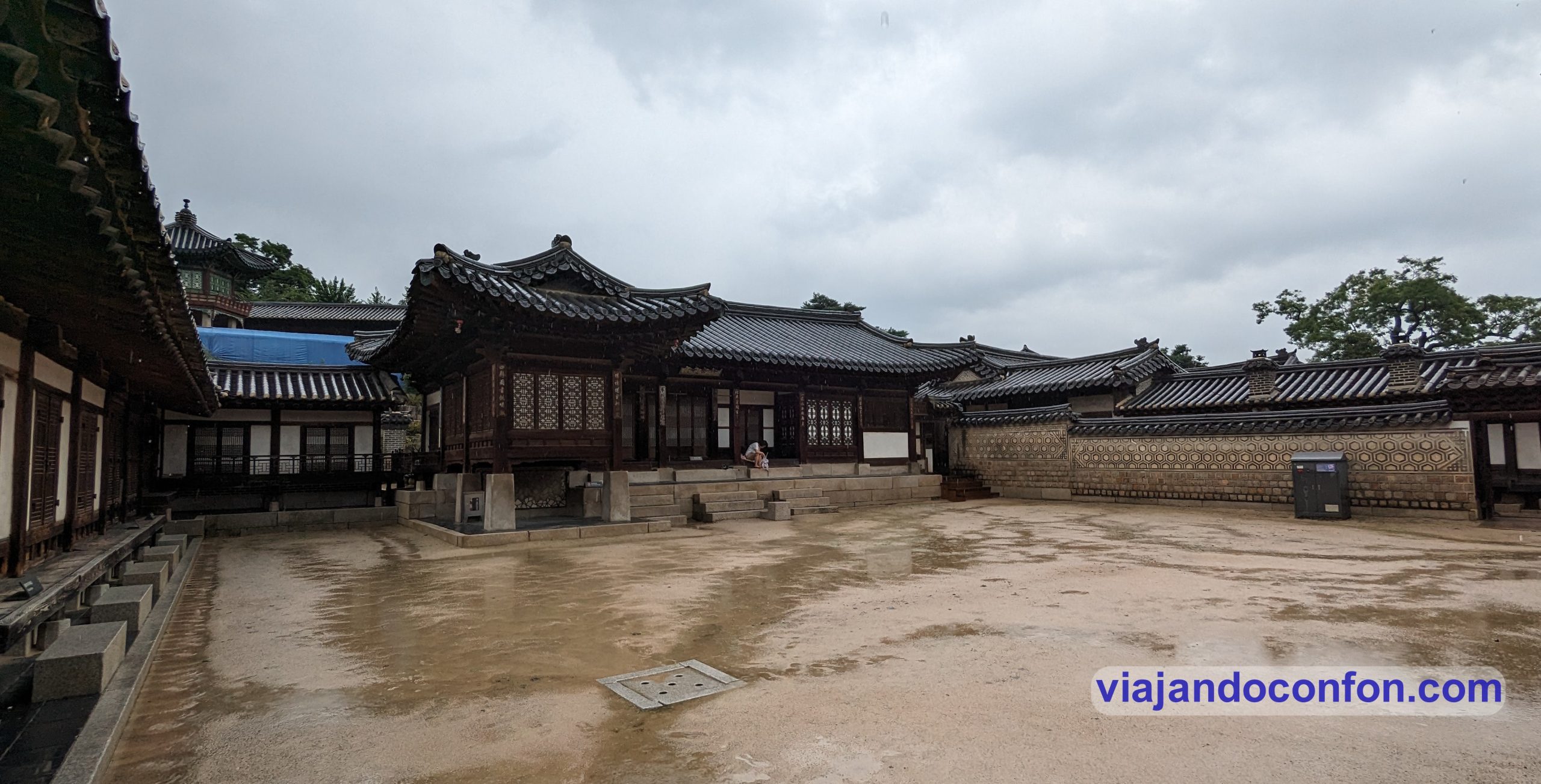
Right next door is the entrance to Changgyeonggung Palace. You can enter from Changdeokgung Palace, or from Changgyeonggung-ro Street on the other side of the complex. The entrance fee is 1,000₩ (€0.70) but is included in the Royal Palace Pass.
The palace was built in the mid-15th century by King Sejong for his father, Taejong. It was originally called ‘Suganggung’, but was renovated and enlarged in 1483 by King Seongjong, at which time it received its present name.

Many of the buildings were destroyed during the Japanese occupation in 1592. It was rebuilt by successive Joseon kings, but was again largely destroyed by the Japanese in the early 20th century.

During the Japanese colonial period, the Japanese built a zoo, botanical garden and museum here.
After independence in 1945 and the destruction of the Korean War of 1950-1953, the zoo was replenished by donations from wealthy Koreans and gifts from foreign zoos. In 1983, the zoo and botanical garden were moved to the present-day Seoul Great Park.

The spectacular Honghwamun Gate, the main gate of the palace, is particularly noteworthy. First built in 1484, it was burned down during the Japanese invasion of 1592. It was rebuilt in 1616.
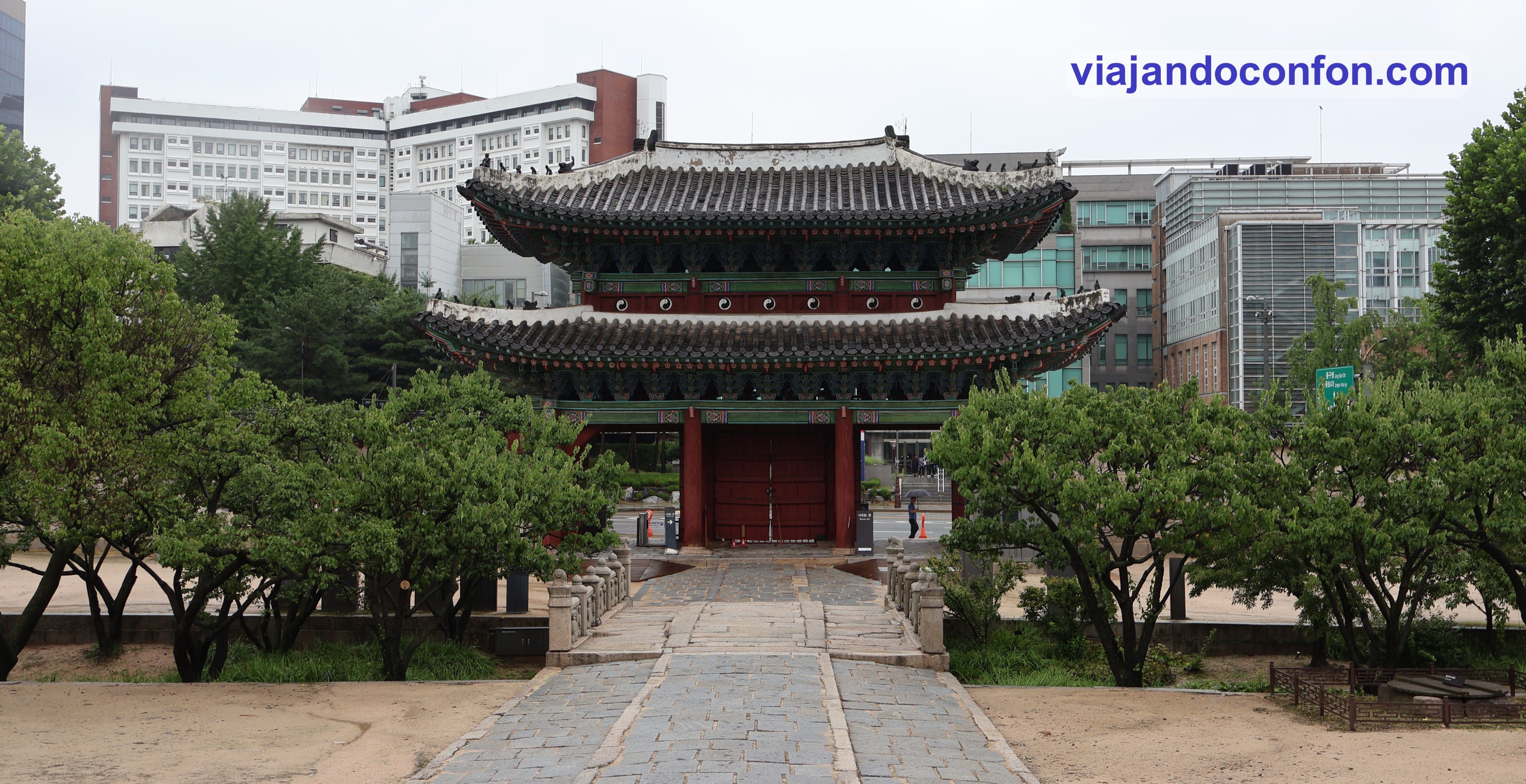
Without wasting a second and taking advantage of the fact that the rain was giving us a little respite, we went for a stroll along the Insadong-ro shopping street.
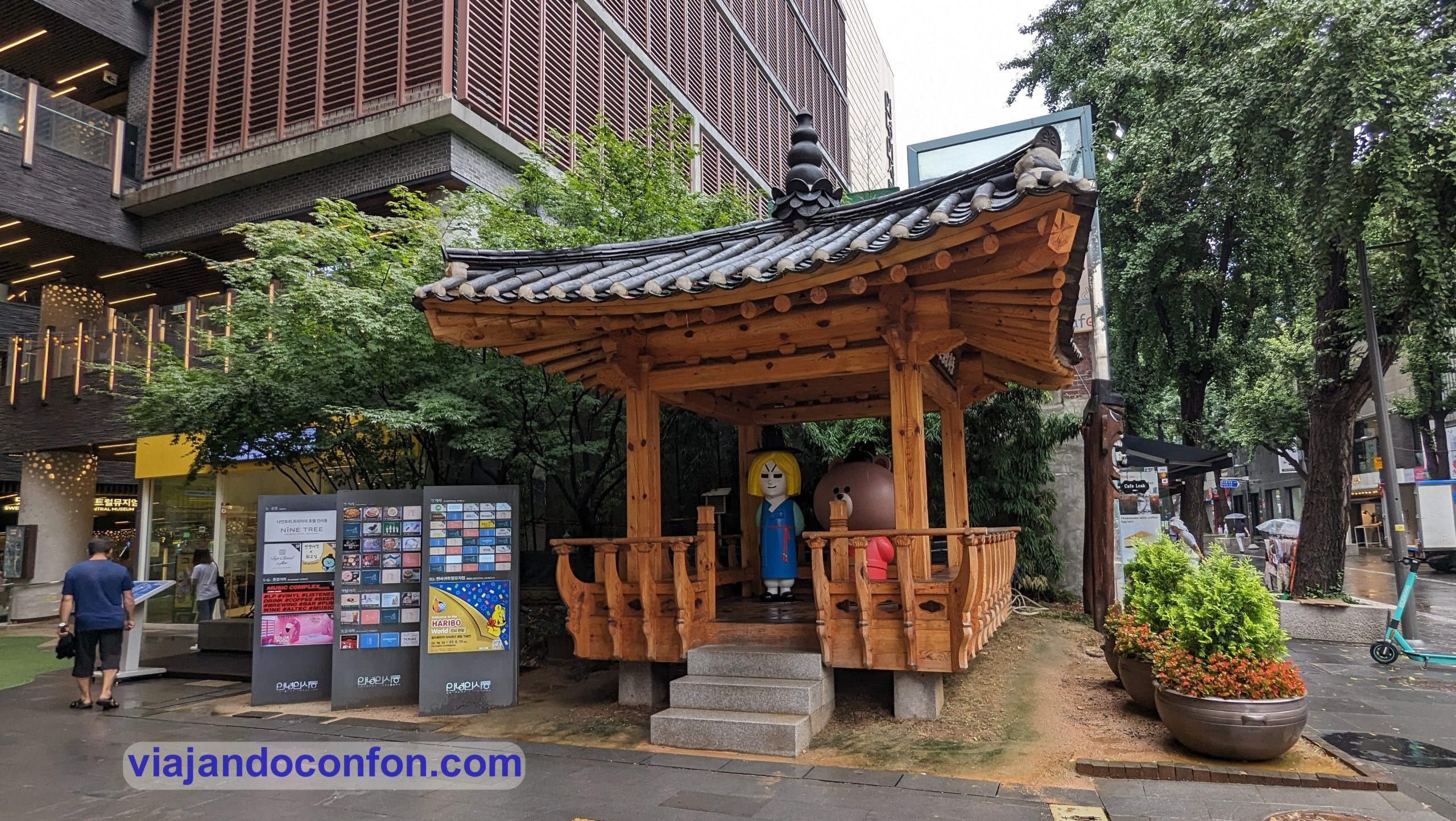
Nearby is Jogyesa Temple, the head temple of the Jogye order.
It was built in 1910 and was named Gakhwangsa Temple, after monks who longed for independence from Korean Buddhism.
The name was changed to “Taegosa” during the period of Japanese rule, and then to the current name in 1954.
As soon as we entered, we found a spectacular lotus plantation in front of the main pavilion. It was a real marvel.

Practically in the centre of the enclosure there is an ancient white pine tree, listed as Natural Monument no. 9.

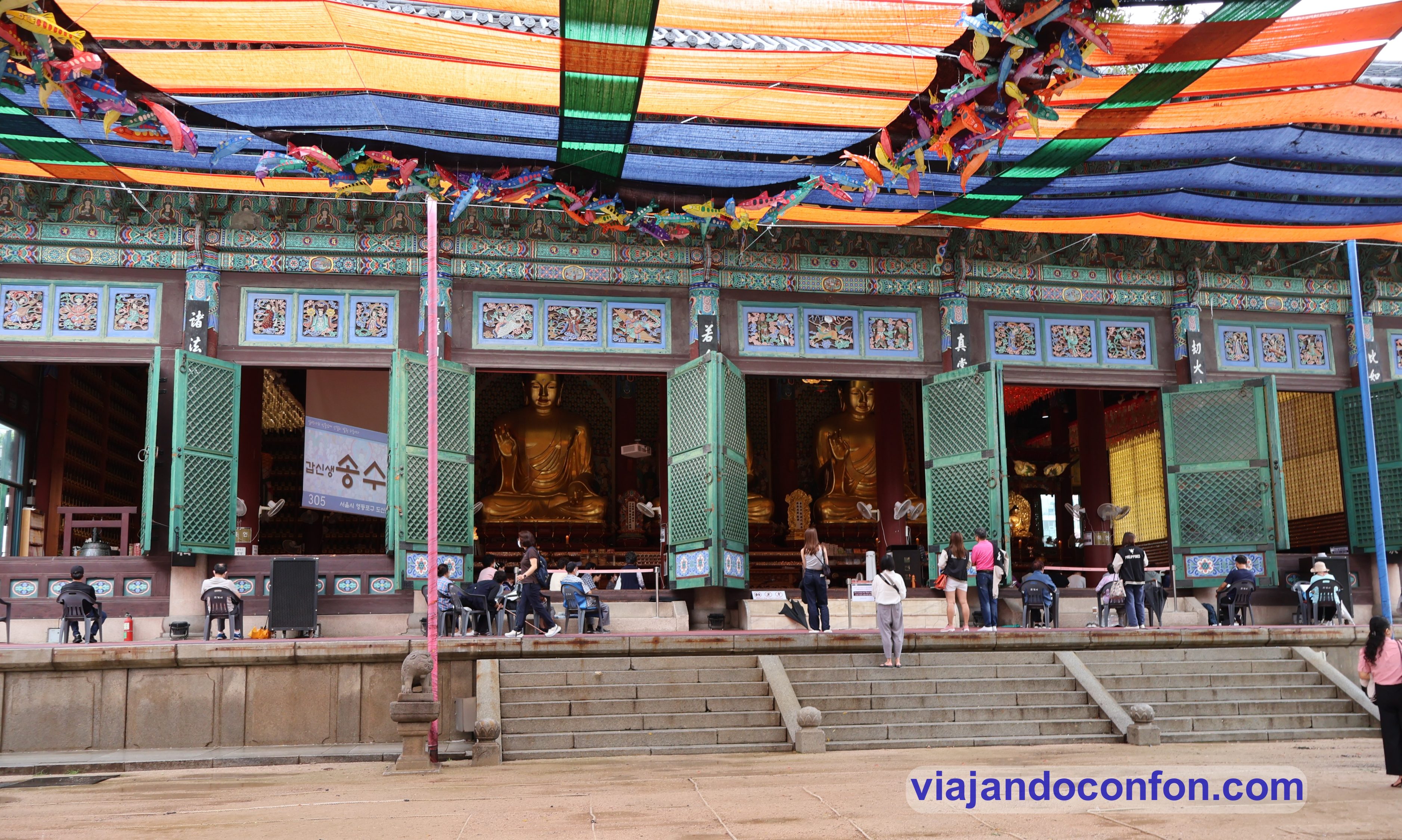
In the main courtyard of the temple is the 7-storey stone pagoda, built in 1930. Inside the pagoda are the ashes of Buddha, which were brought here in 1914 by a Sinhalese monk.
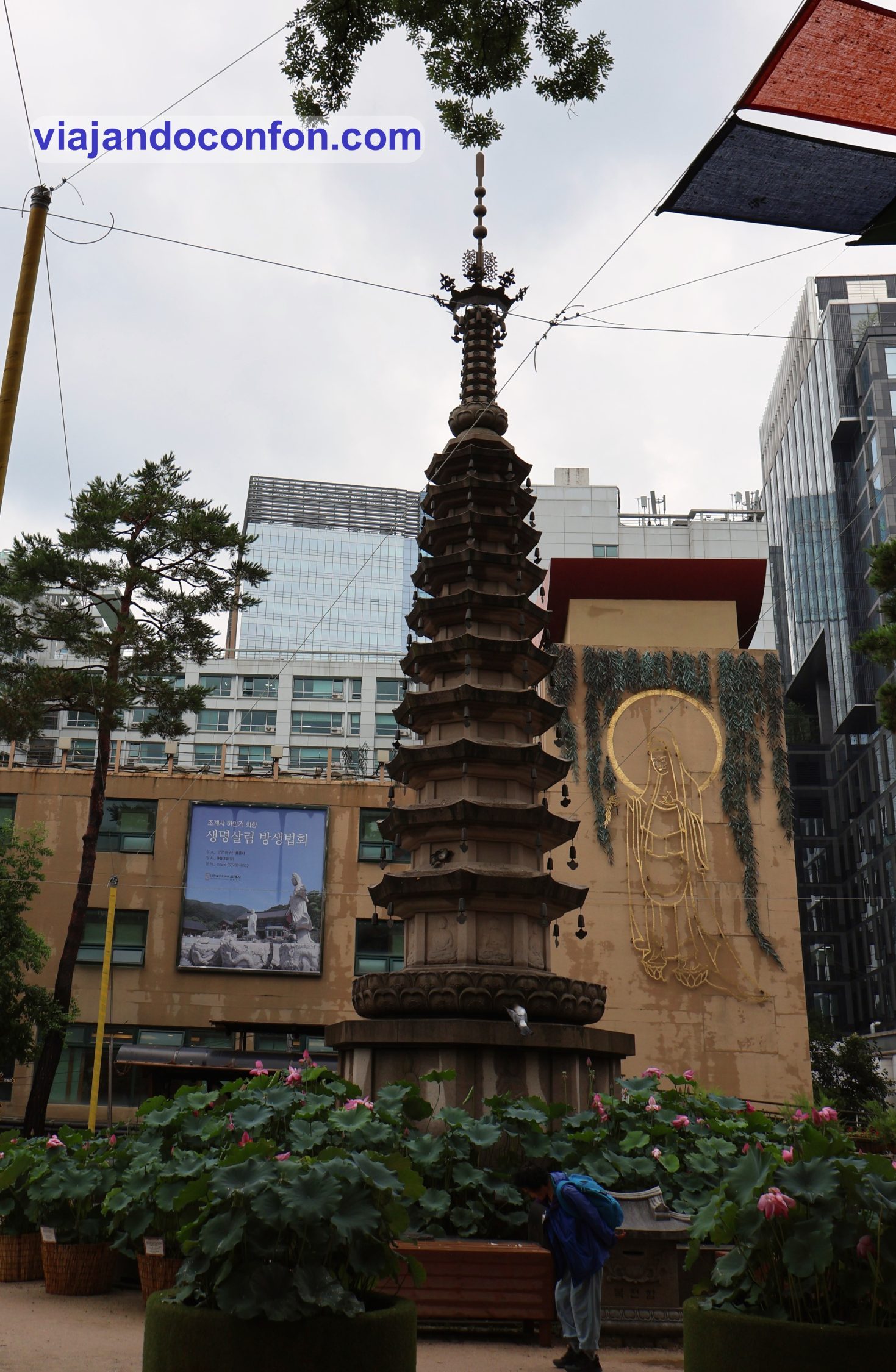
After the visit to the temple we went in search of a place to eat. We went to a place called 김 네 대마루... On google maps it is listed as Good Restaurant. Specialising in Korean barbecue.
It is the most expensive meal we had in the whole country but it was so good that we repeated a few days later. The price was 65.000₩ (45€).

After lunch, we continued sightseeing. There was no time to waste.
The next visit is the Unhyeongung Palace. It was built as the residence of King Gojong, the 26th king of the Joseon dynasty before he assumed the throne at the age of 12.
During Gojong’s tenure, the regent Heungseon ruled the country for about 10 years, after taking control of state affairs from his son.

In 1864, during the first year of King Gojong, the Nokrakdang and Noandang Halls were built. Five years later, in 1869, the Irodang and Yeongnodang Halls were built.
To facilitate entry and exit from Changdeokgung Palace, Gyeonggeunmun and Gonggeunmun gates were built exclusively for Gojong and the regent Heungseon. However, they are no longer standing.
The palace was purchased in 1993 by the city of Seoul and was reopened in 1996 after extensive restoration.
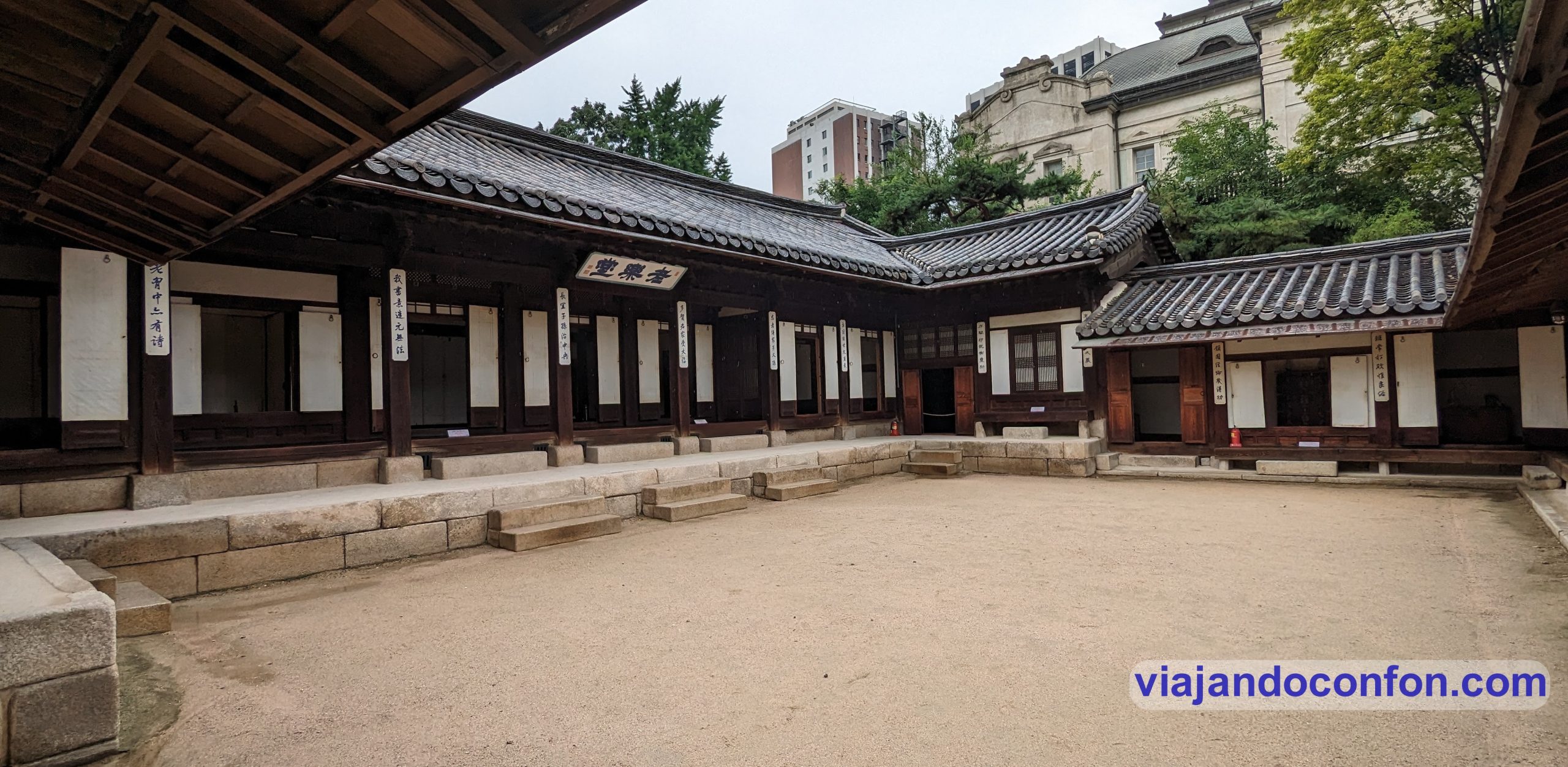
In the various buildings there is an exhibition of how life was lived in the time when the palace was occupied.
By the way, the entrance is free of charge.
After the visit to the palace, we went to the hotel for a rest and a shower. With the heat and the tremendous humidity, we were sweating profusely.
After a very short and well-deserved rest, we went on our way to the Heunginjimun Gate. It was built in 1396 during the reign of King Taejo, the first king of the Joseon dynasty. It is the eastern gate of the city’s defensive wall.

The gate has been destroyed and rebuilt several times. The present gate dates from 1869 and has the appearance of the original gate. Its name, Heunginjimun, means “Gate of Increasing Benevolence”. It is also known as Dongdaemun Gate (Great East Gate).
Nearby is the DDP, Dongdaemun Design Plaza. The futuristic building was built in 2009 to a design by the Anglo-Iraqi architect Zaha Hadid.

It was opened in 2014 and is a multi-purpose building that hosts exhibitions, fashion shows and all kinds of cultural events.
When we were there, it was full of old televisions. There was also a room called the Media Art Gallery with giant screens that took up almost the entire room. These share splendid moments drawn by SeouLight, a global festival of media facades.
They were really just showing strange images with a rather soothing music.

There is also a shop and a large space simulating a modern garden with some tables and pouffes where we sat down to rest.
At the back of the room there were some kind of conical stools that, when you sat down, you spun around as if you were going to tip over. It was really fun. We made videos, but they were embarrassing, so we kept them to ourselves…


Outside the building, on the side down a small slope on the north-eastern side of the building, is Igansumun, the water gate.
Igansumun was the water gate of the Namsomundongcheon stream originating from Namsan Mountain, which flowed from Hanyangdoseong, the city wall of Seoul in the Joseon Dynasty.
In addition to releasing the flow of water, it had a defensive function and was guarded by soldiers who guarded the gate.
It was buried during the Japanese occupation and was found and restored in 2009 during the construction of the Dongdaemun Historical and Cultural Park.

In a square below the building, next to the entrance of the underground station are the ruins of the former Dongdaemun Stadium.
This was the site of Hadogam (Lower Military Directorate), one of the outposts of Hullyeondogam (Military Training Command) during the Joseon dynasty.
During the Japanese occupation the area became Hullyeonwon Park and in 1925 the Gyeongseong Baseball Stadium was built. After Korea’s liberation from Japanese rule, the stadium was renamed Seoul Stadium and later Dongdaemun Stadium.
After the demolition of the stadium in 2003, the remains of Hullyeondogam and the water gate were discovered. Some of the remains were moved to other parts of the park and some were preserved here.

Night is falling so we decided to visit the Deoksugung Palace, which is recommended to visit at night. It is the palace that closes later, at 9 pm.
We left the subway at the City Hall exit and when we arrived at the entrance of the complex a Joseon-era performance was taking place.

Deoksugung is one of the “Five Great Palaces” built by the kings of the Joseon dynasty. It was inhabited by the Joseon until the beginning of the Japanese occupation in 1910. Today only 1/3 of the original structures remain.
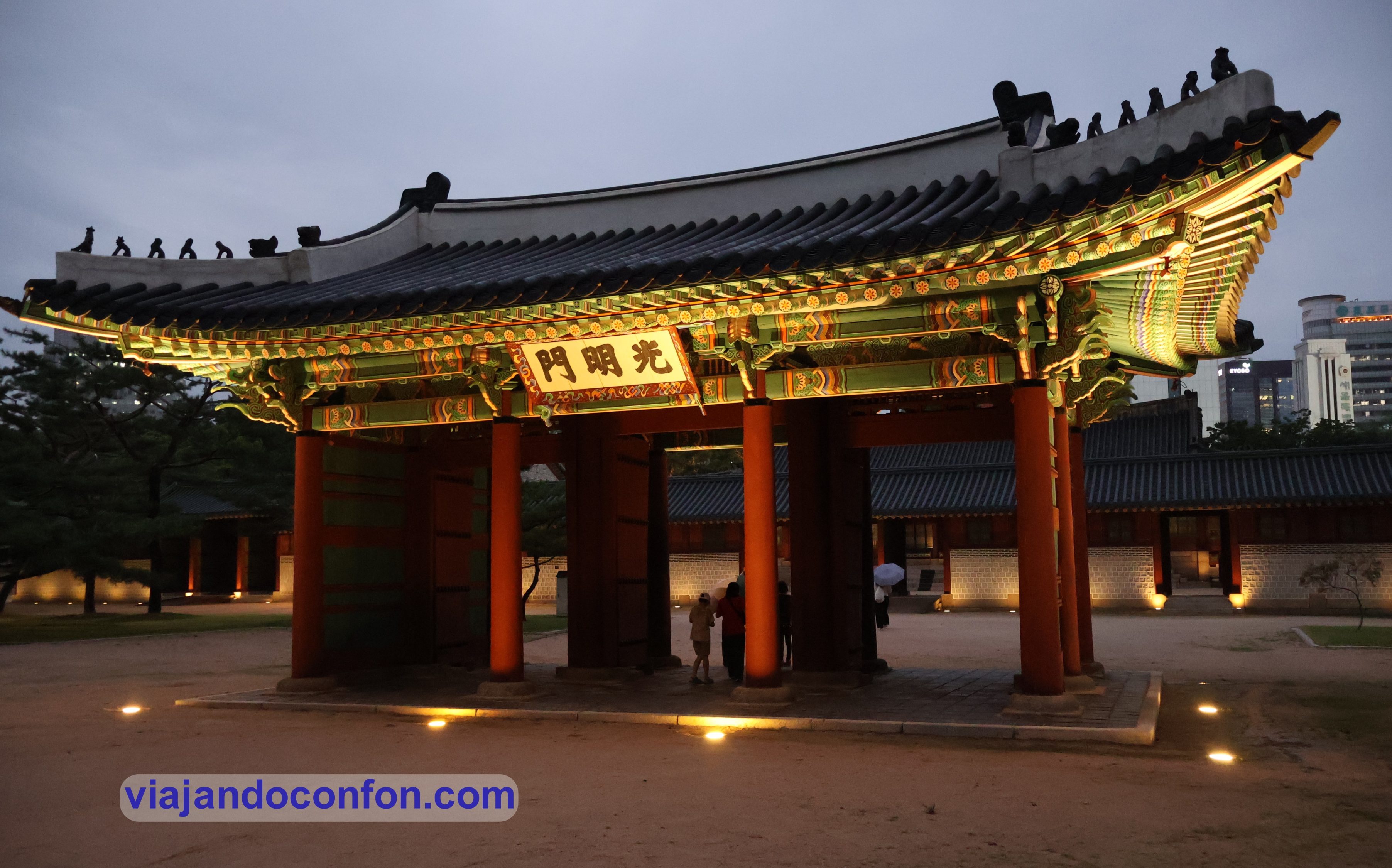
It was originally the residence of Grand Prince Wolsan, the elder brother of King Seongjong. Deoksugung became a royal residence when the Japanese burned the remaining palaces during their occupation in 1592.
King Gwanghaegun was crowned in this palace in 1608 and renamed it Gyeongun-gung in 1611. After the reconstruction of Changdeokgung, it was converted back into an auxiliary palace in 1618 and renamed Seogung.
In 1907, the palace was renamed Deoksugung, in reference to the emperor’s wish for longevity. Emperor Gojong died in Hamnyeongjeon.
After the last Japanese occupation in 1910, the complex was converted into a park and many buildings were destroyed. Today only 1/3 of the original elements of the complex remain.
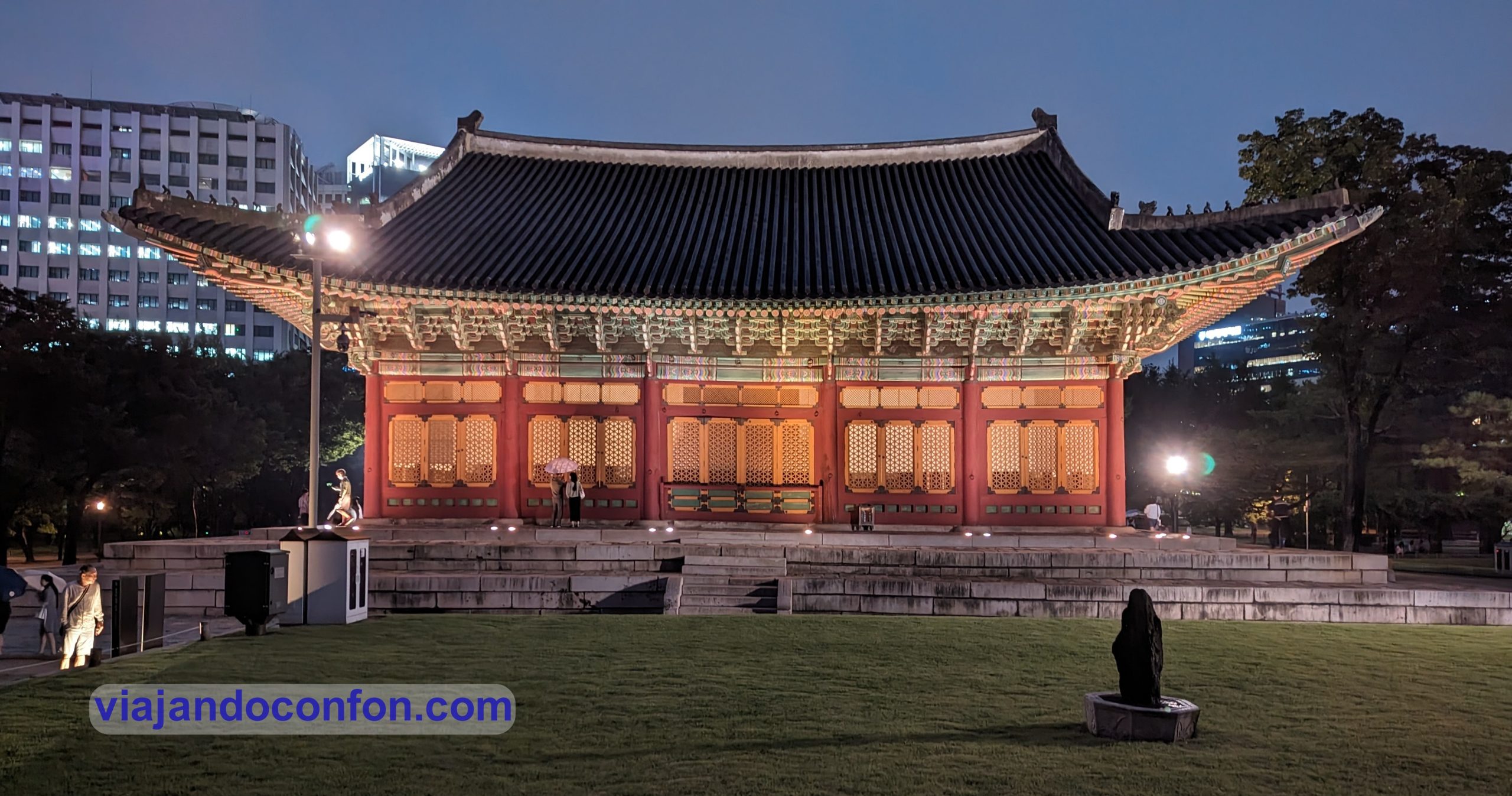
At the northwest end of the complex is the National Museum of Art, built in stone in a Western architectural style. It was built in 1910 in the neoclassical style by British architect J. R. Harding.

Entrance to the palace costs 1,000₩ (0.70€) and is included in the Royal Palace Pass.
This is the end of the day (or so we thought). We took the metro to the hotel. On the platform, we noticed that there are emergency kits with water bottles and gas masks in every station. It is a bit disturbing.

We buy some dinner in a combini next to the hotel. The idea is to go to bed early as we have to get up at 5.30 to go to the DMZ.
While we are still having dinner, at about 10 p.m., we get a phone call from reception. We have to change rooms because in the morning work starts on the terrace and we might be disturbed. Really? At 10 o’clock at night you have to collect all the luggage to change rooms. It doesn’t seem halfway normal to me. The work had already been scheduled a week before (they gave it to us in writing). The best thing would have been to let us know when we arrived so that we wouldn’t have to unpack our luggage.
The new room, on the 3rd floor, was much worse. To make matters worse, there was an unpleasant trickle of brown water coming out of the wall of the shower and bathrooms.

We decided to go to bed and complain in the mor12 thning.
12th August
Up at 5.30. Still raining. We had some breakfast that we had bought the night before and went to reception to complain about the various faults in the room. They tell us that maintenance will come and take a look.
We take the metro to the meeting point for the DMZ tour.
The DMZ, the Korean Demilitarised Zone, is a strip of land that runs across the Korean Peninsula near the 38th parallel north, roughly dividing it in half.
It was established to serve as a buffer zone between the countries of North and South Korea under the provisions of the 1953 Korean Armistice Agreement. An agreement between North Korea, China and the United Nations Command.

The DMZ is 250 kilometres long and about 4 kilometres wide and is heavily guarded and mined. For a demilitarised zone, it is the most heavily militarised strip of land in the world.
Somewhat late (we were supposed to be picked up at 6.45) the bus appeared and we got on. It was full of Japanese people, doing a tour in Japanese with a guide. Our group (in English) consisted of the two of us and two couples of kids from Lithuania. One of them was Korean, though. We had another guide, Leo, a very nice young man, although he seemed a bit inexperienced.
After about an hour, we arrived at the first stopping point, Imjingak Park. Leo takes our passports and goes to the main building to check us in.

In this building there is an art exhibition inspired by the conflict, as well as some restaurants.
Outside the building there are also several monuments. For example, the Pyeonghwauijong Peace Bell. It was built in 2000 to pray for the peace of the human race and national unification in celebration of the new millennium.
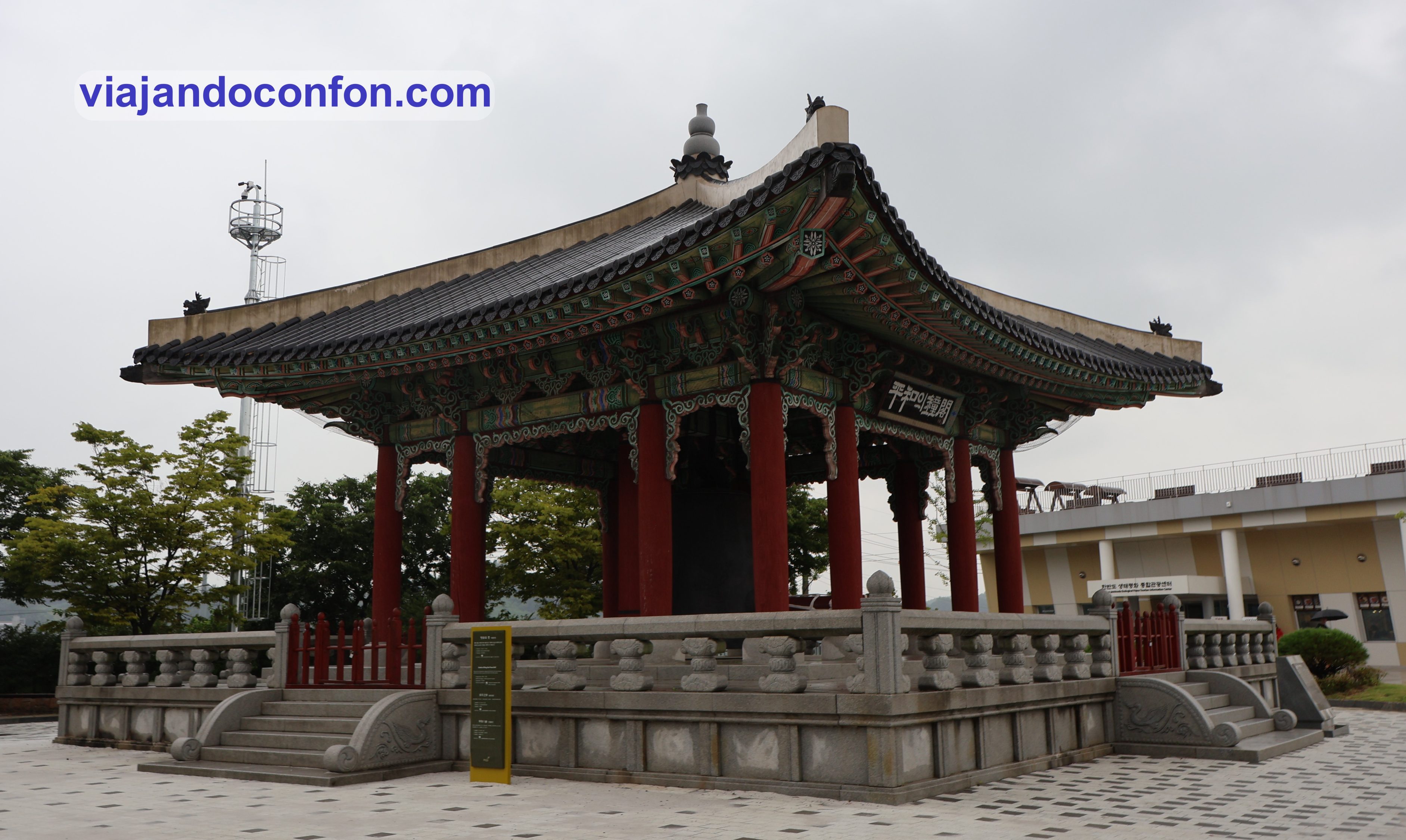
This is also the site of the Freedom Bridge. It was built to honour the souls of the displaced people who died while missing their families and hometowns they left behind in the North.
It was originally called Dokgae Bridge, but was renamed in 1953. It was when 12,773 South Korean and UN soldiers captured during the war returned across this bridge.
At the end of the bridge are hung many messages from family members separated by the war. It is said that these messages are carried by the wind to the north so that they can reach their intended recipients.

Also on display is an old steam locomotive that was attacked in the war and the Imjingang Bridge, a railway bridge that crosses the river to link the two Koreas.

After the visit and the relevant explanations, Leo leaves us for 20 minutes at our leisure and we return to the bus. Next stop: Dora observatory.
But first we have to go through an exhaustive military checkpoint. Several soldiers get on the bus and check one by one with our passports to make sure that we are on the list.
The Dora observatory is located on the top of Mount Dora. From here you can look across the border through binoculars and see into North Korean territory.
This is what we saw:
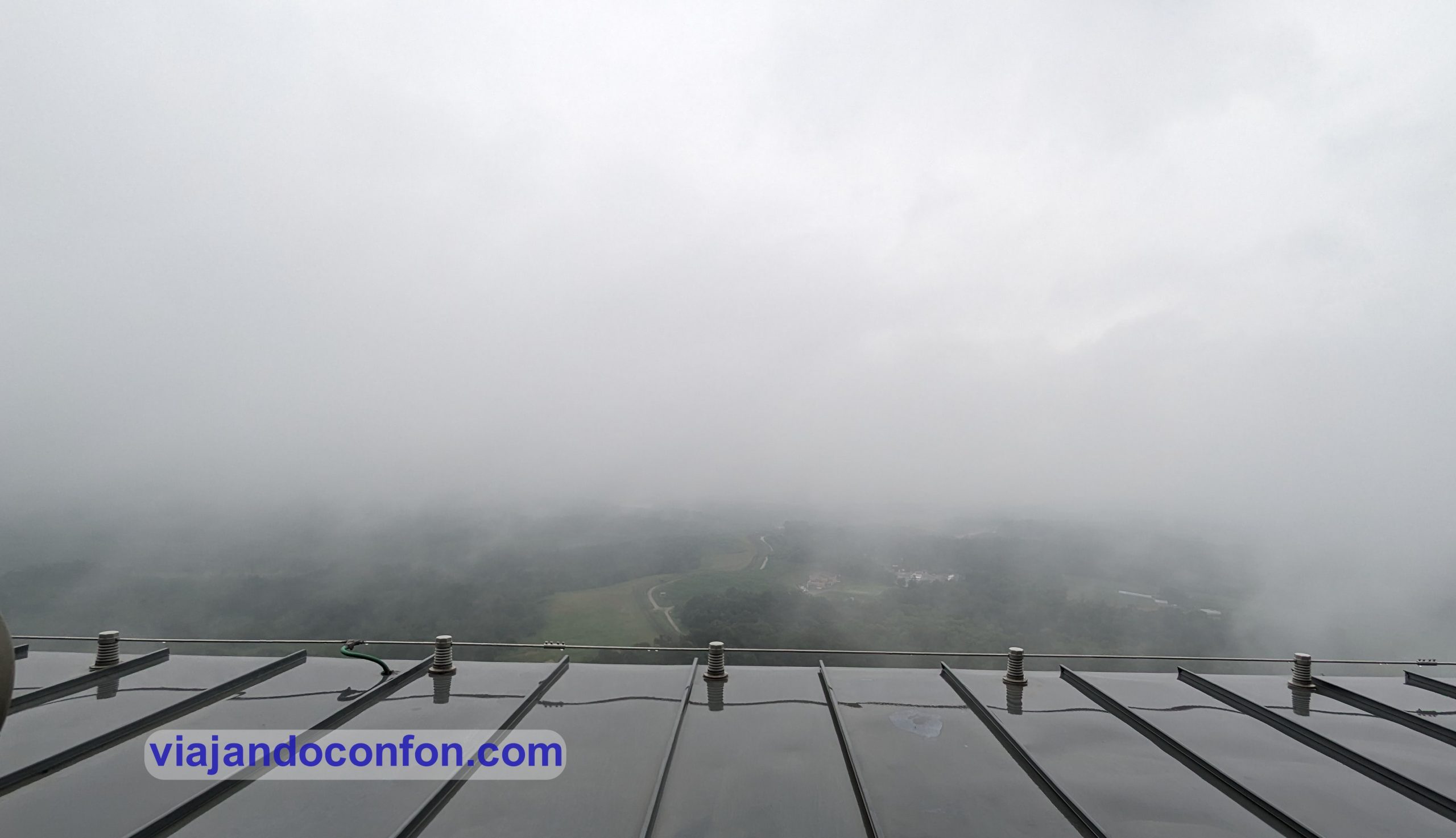
North Korea is beautiful at this time of the year… and so on.
With a bit of disappointment in our bodies we went to the next point: the Third Tunnel. It is a tunnel dug by the North Koreans for a supposed invasion of the South. Although the North Koreans say it is the other way around.
It was discovered in 1978 after a loud explosion was detected, apparently caused by diggers who had advanced 435 metres under the southern side of the Korean Demilitarised Zone. It took 4 months to locate it and dig the interception tunnel.
It is over 1,600 metres long and 1.95 metres high. It could move up to 30,000 soldiers per hour with light weapons. It is one of four tunnels discovered to date.

Here there is a small museum about the tunnels and a souvenir shop. The highlight is the descent to the tunnel. This is a very long climb of 250 metres with a 10% gradient. Descend into the tunnel and walk through it crouching down and wearing a hard hat, as you will be bumping into the ceiling.
You are not allowed to take photos. In fact, you are forced to leave all your things in lockers before going down. I have to say that you go through it to have the experience because… because in the end there is nothing. An armoured door with a couple of cameras.
The climb is hard, not the next thing. It is not recommended for the elderly, people with heart problems, pregnant women and people in very poor physical condition.

We finish climbing the hill exhausted and with our tongues hanging out. A few cold drinks and back to the bus. Next stop: the cafeteria and local products shop of all the excursions. I eat a black soya ice cream, typical of the area, which was delicious, and then back to the bus.
We go through the exhaustive military checkpoint again and straight to Seoul. I have to say that you can’t visit the DMZ on your own, only by scheduled tours.
You can take this interesting excursion to the DMZ with Civitatis:
We got off at the meeting point where we were picked up and looked for somewhere to eat. We went to a place called Gobong Samgyetang Gwanghwamun. They specialise in Samgyetan, which is like a kind of cream with a WHOLE CHICKEN INSIDE! stuffed with rice. It was really good even though it was an awful lot of food. It cost us 38.000₩ (26.72€).


With our stomachs very, very full, we took a rainy walk back to the hotel. On the way we passed Bosingak. It is a huge bell pavilion that gives its name to the avenue where it is located: Jongno. It literally means Bell Street.
It was originally built in 1395 but, after multiple destructions, the current one was built in 1895. The bell was installed in the palace during the Joseon rule and is now only rung at midnight on New Year’s Eve.

A little further on is Tapgol Park. Here we find several remarkable elements. The most remarkable of all is the Wongaksa Pagoda.
It is a 10-storey, 12-metre-high pagoda built in stone in 1467. It stands on the site of the former Wongaksa Temple. The temple was built in 1465 by King Sejo and was the head temple of the Jogye Order.
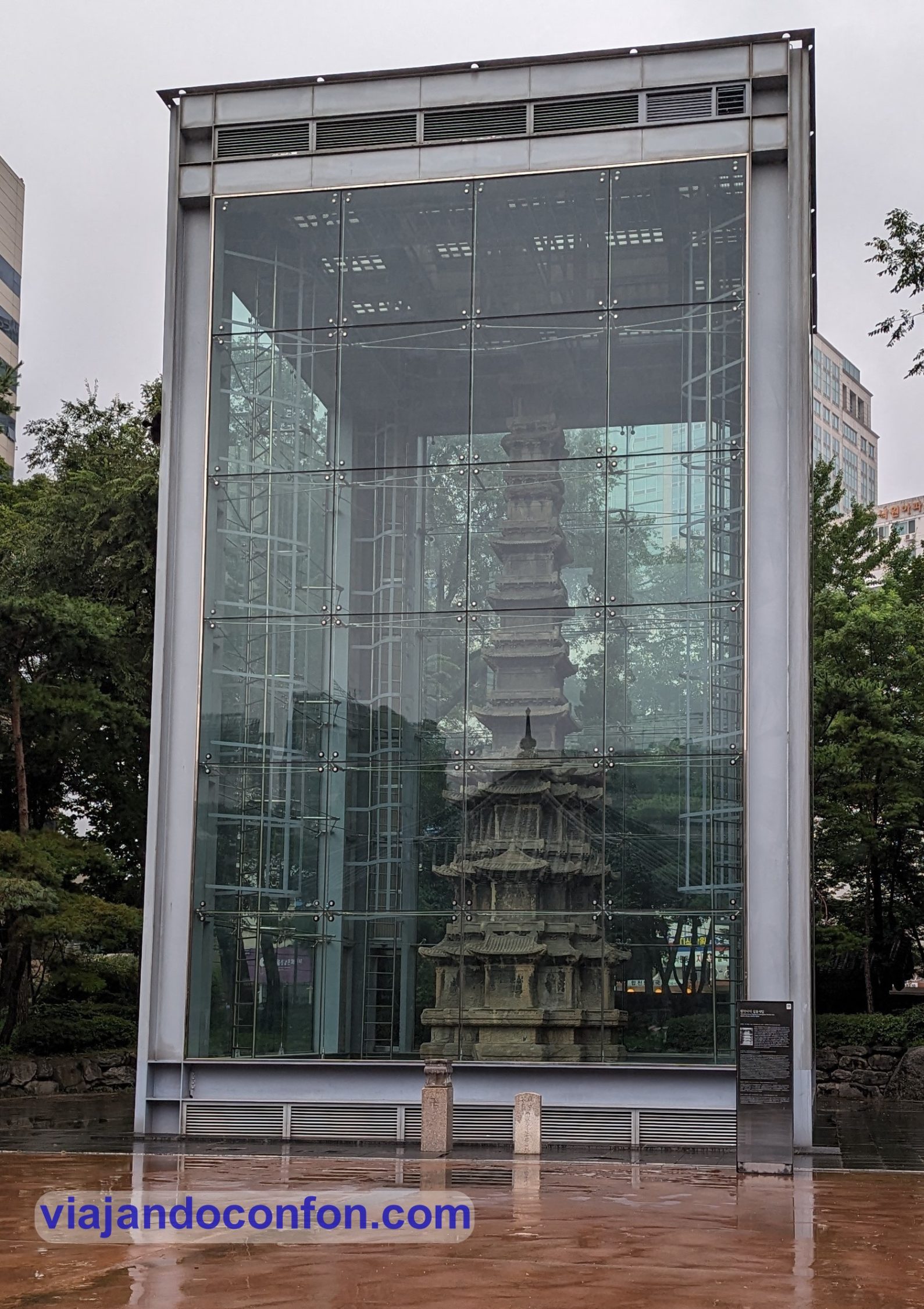
Records indicate that the pagoda originally had 13 stories. It was built to house the Sarira and the Wongakgyeong (Wongak Sutras), which had recently been translated at that time.
Another feature of the park, also belonging to the old temple, is the Wongaksa Monument built in 1471. It was erected to record the founding of the Wongaksa Temple.
On the front is an inscription composed by Kim Suon with calligraphy by Seong Im. On the reverse is an inscription composed by Seo Geo Jeong with calligraphy by Jeong Nam Jong.

Tapgol Park is historically important as the birthplace of the 1 March 1919 Movement. It was the first place where the Proclamation of Independence was read. There are several statues with bas-reliefs to attest to the fact.
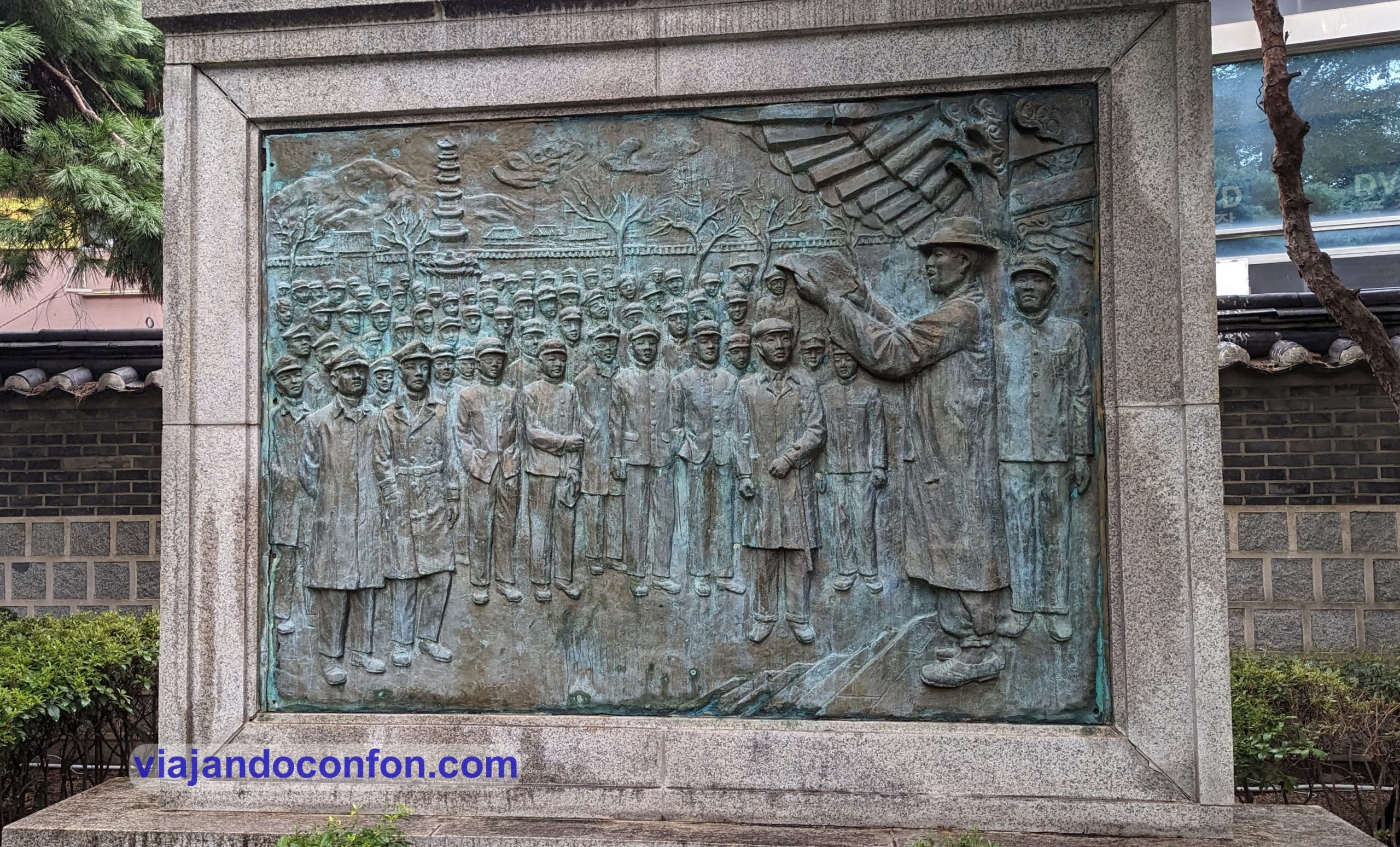
Now we go to the hotel to rest a bit and take a refreshing shower. But first, as soon as we arrived at reception they told us that they had not been able to fix the damage to the room and we had to change AGAIN. Luckily we had not had time to unpack.
This time, before changing, the receptionist went to make sure that everything was in order. While we were waiting we were invited for refreshments.
A while later the guy arrived and said that everything was in order. Floor 8 and much better than the previous room.
After the break, we took the underground to visit the Gangnam district, one of the most exclusive in Seoul. Yes, where the hit song Gangnam Style by Psy was released.
As we got off the underground and exited the station we came across the monument to the song. Two giant hands representing the song’s dance, with the song playing on a screen and always someone underneath making a fool of themselves.
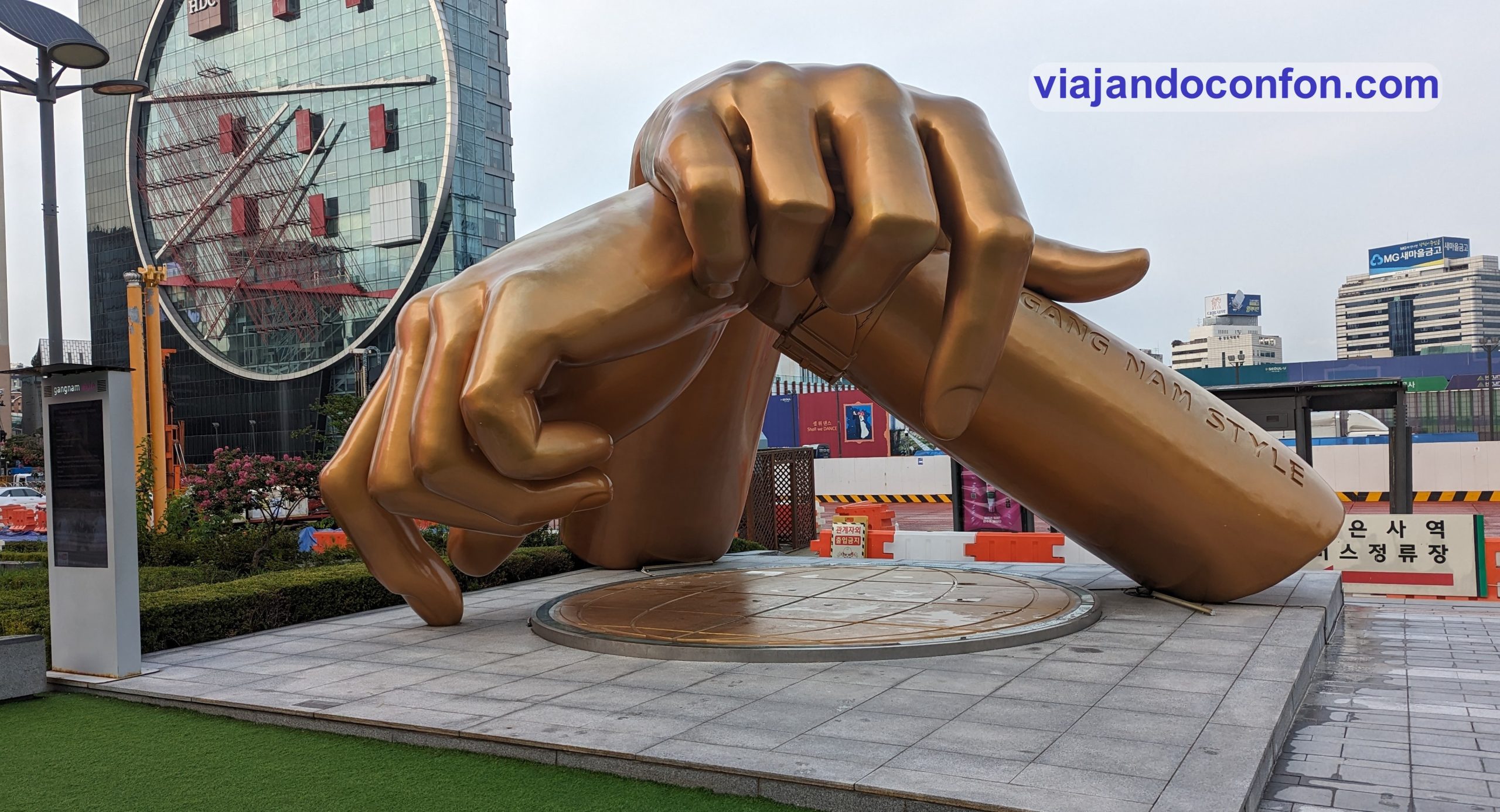
Ridiculous which, of course, we also did, but I’ll keep the photos and videos to myself. But if you want to see some, you can check out my instagram.
From here we can see the Lotte World Tower. The tallest skyscraper in South Korea with 555 meters and 123 floors. On its top floor is the 2nd highest observation deck in the world at 512 metres.
We are not going to go up for the moment, as it costs a lot of money and with the bad weather we are not going to see much of it.

Very close to the Gangnam Style statue is the Bongeunsa Temple. It was founded in 794 by the state preceptor Yeonhoe, then the highest ranking monk of Silla. Its name at that time was Gyeonseongsa.
During the Joseon dynasty, Buddhism in Korea was severely suppressed and the temple was destroyed.
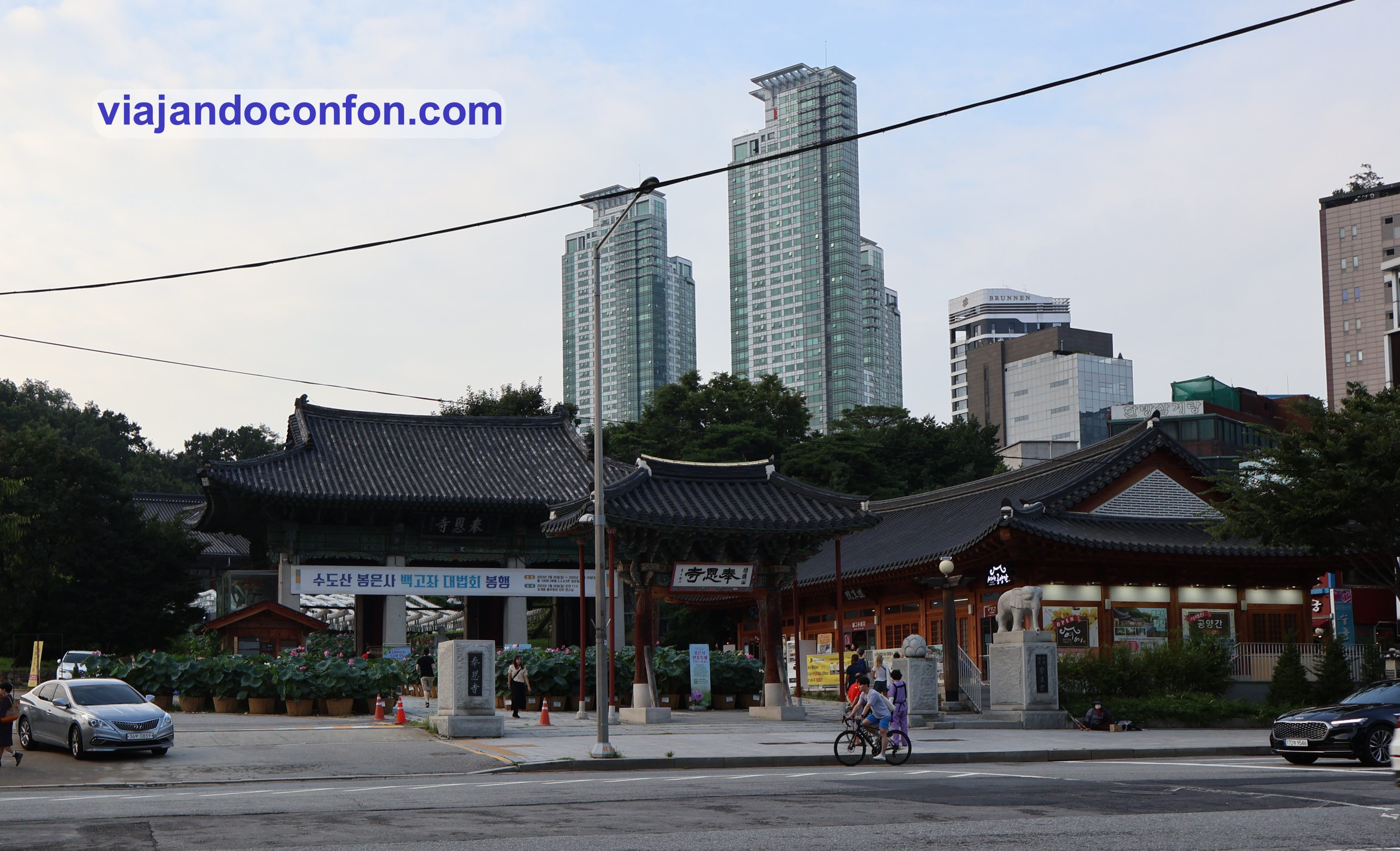
The temple became known as Bongeunsa when it was rebuilt in 1498 under the patronage of Queen Jeonghyeon, a Joseon queen.
The term Bongeunsa means the act of honouring the king, which can be understood here as a prayer for the eternal life of King Seongjong.
With the support of Queen Munjeong, who revived Buddhism in Korea in the mid-16th century, it became the head temple of the Korean Seon (Chan) Buddhist sect from 1551 to 1936.
The monk Bou was appointed head of the temple in 1548 by Queen Munjeong. He was assassinated soon after when anti-Buddhist factions regained dominance in Korea towards the end of Queen Munjeong’s rule.
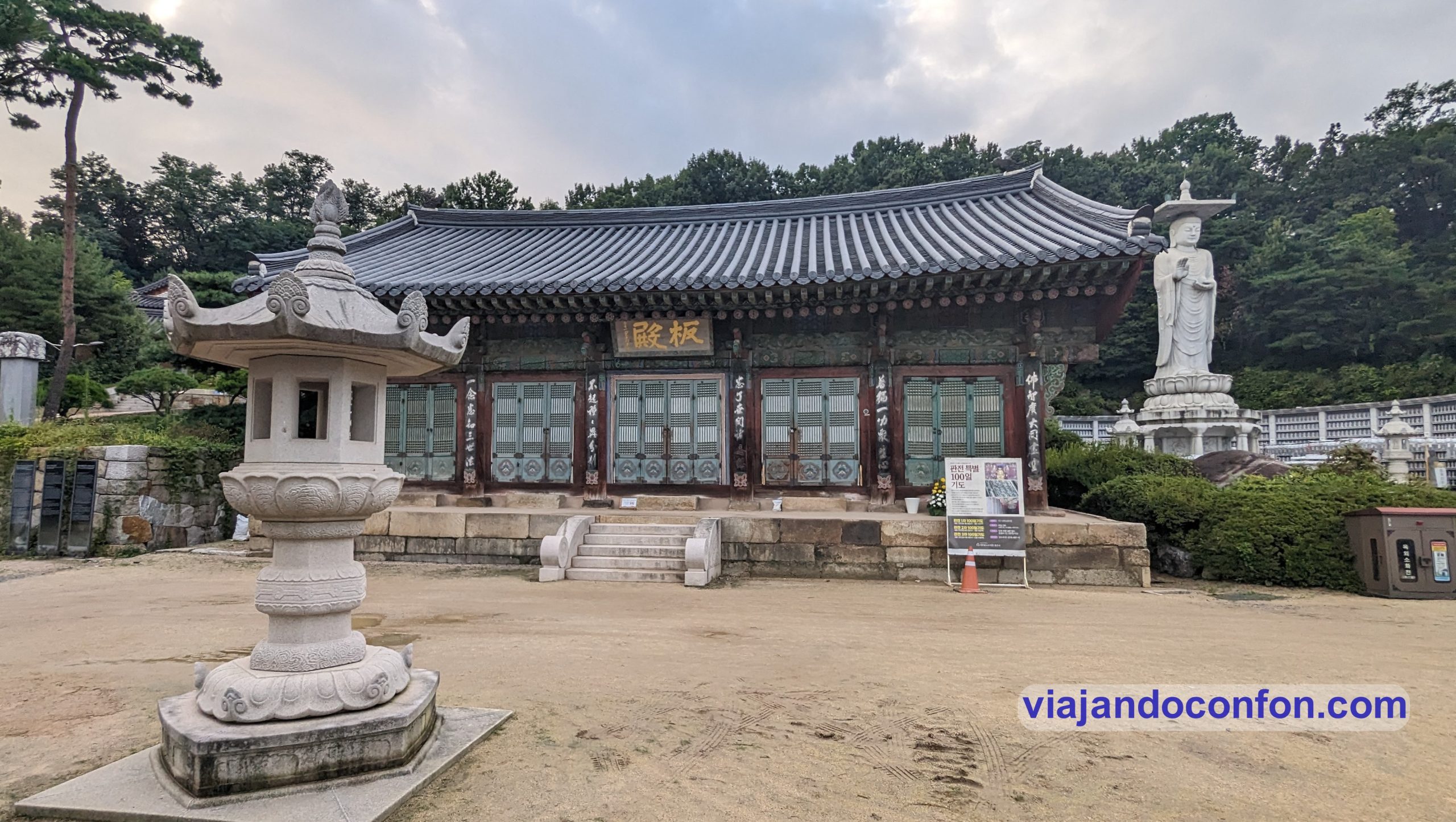
During the Japanese occupation in the 20th century, the temple became the seat of 80 smaller Buddhist temples around Seoul. After colonial rule, Bongeunsa became subordinate to the Jogye Order, the largest Buddhist sect in Korea.
A fire in 1939 destroyed most of the buildings and other parts of the temple were destroyed during the Korean War.
The temple houses the Bongeunsa Maytreya Buddha, the largest Buddha in Korea at 23 metres tall.

The truth is that the temple is a real haven of peace in the middle of bustling Seoul. What’s more, admission is free.
Overwhelmed by the tremendous humid heat, we decided to look for somewhere with air conditioning where we could have a cool drink. In the COEX shopping centre we found a natural juice place and there we sat down. It’s called Jamba and it’s not cheap, but it was really good. The two large juices cost us 12,800₩ (9€).
As we sat there, we were amazed by the staff. They arrived at the place, left their bags and mobile phones guarding the place and went to order at the cash desk. You do that in Spain and when you come back they’ve even taken the table with them.

In the course of the trip we discovered that South Korea is an extremely safe country, as was the case in Japan. We will give more examples of what struck us in due course.
Refreshed and with renewed strength we went to the Banpo Bridge. It is one of the most famous bridges crossing the Han River. Above all for the spectacle of lights and water by means of its 10,000 LED bulbs, with which it entered the Guinness Book of Records.
As it happened to us in Japan the two times we tried to see the lights of the Rainbow Bridge… they cheated us. No lights, no fountains, no nothing. A cow turd.
What there was was some kind of festival under the bridge. That night there was a guy juggling fire.
Tired of waiting, we went to the hotel. We bought some dinner on the way and went to bed early. It had been a long day and tomorrow we had to get up early again.
Discover the best activities and tours in Seoul with Civitatis:
We continue our second trip to Japan. On this occasion we visited Kumano Kodo – Gifu – Nagoya – Nakasendo and Tokyo.
July 24th
We got up early and at 8 in the morning we were already on the bus on the way to Daimonzaka. In front of the train station, take the 31 bus that goes to the Kumano Nachi Taisa Grand Shrine (熊野那智大社). The return ticket costs 1,000 yen (€7.50). About half an hour later we arrived at the stop on the Daimonzaka slope. There we began the path of ascension towards the temples.
The Daimonzaka slope (大門坂), is a beautiful path of just under 1km long and 267 steps that goes between gigantic cedars.
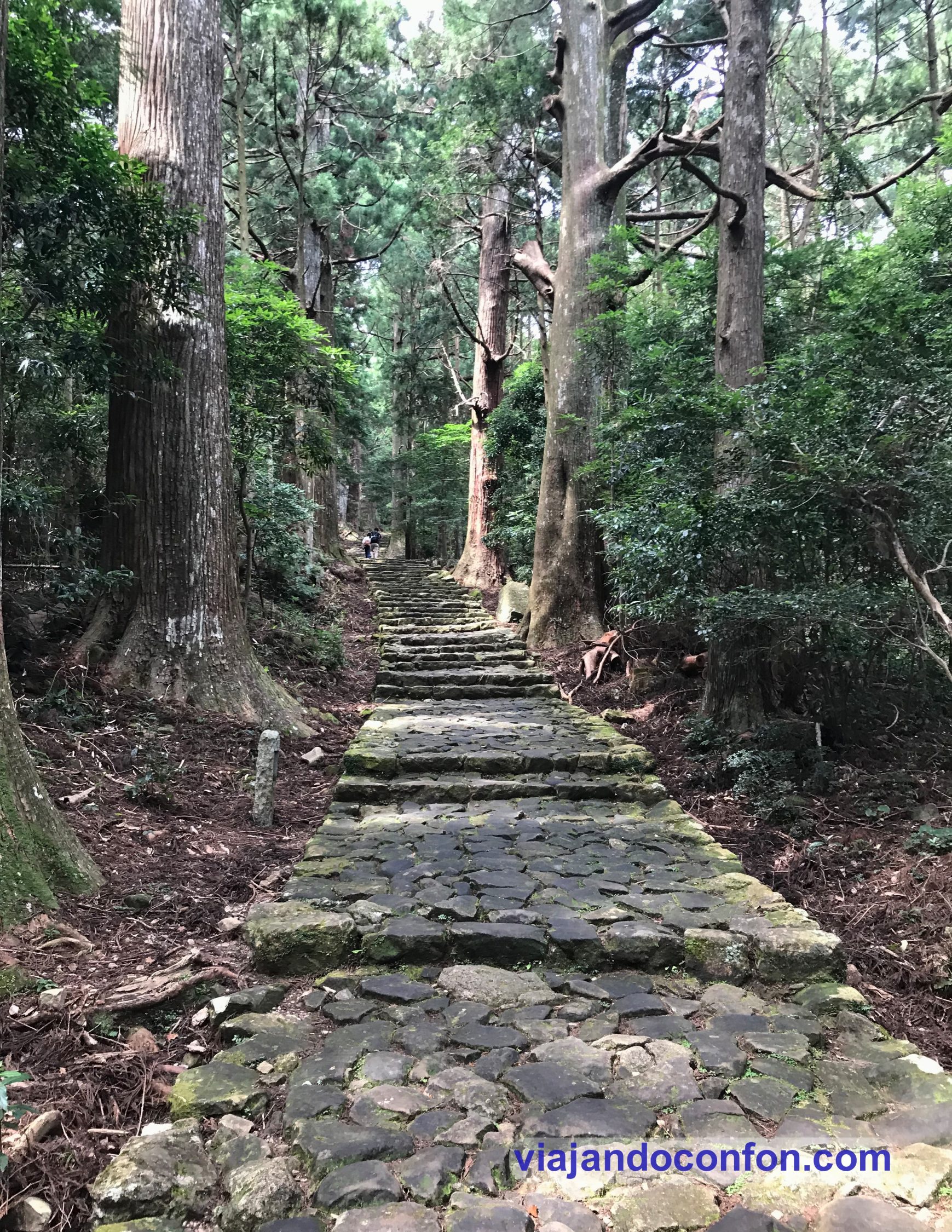
After the ascent in the humid heat of the area, we arrived at the Kumano Nachi Taisa Grand Shrine (熊野那智大社). It is the main sanctuary of the more than 4,000 Kumano Kodo. Unfortunately, we caught the temple under construction and it was completely covered, but it was possible to access it.
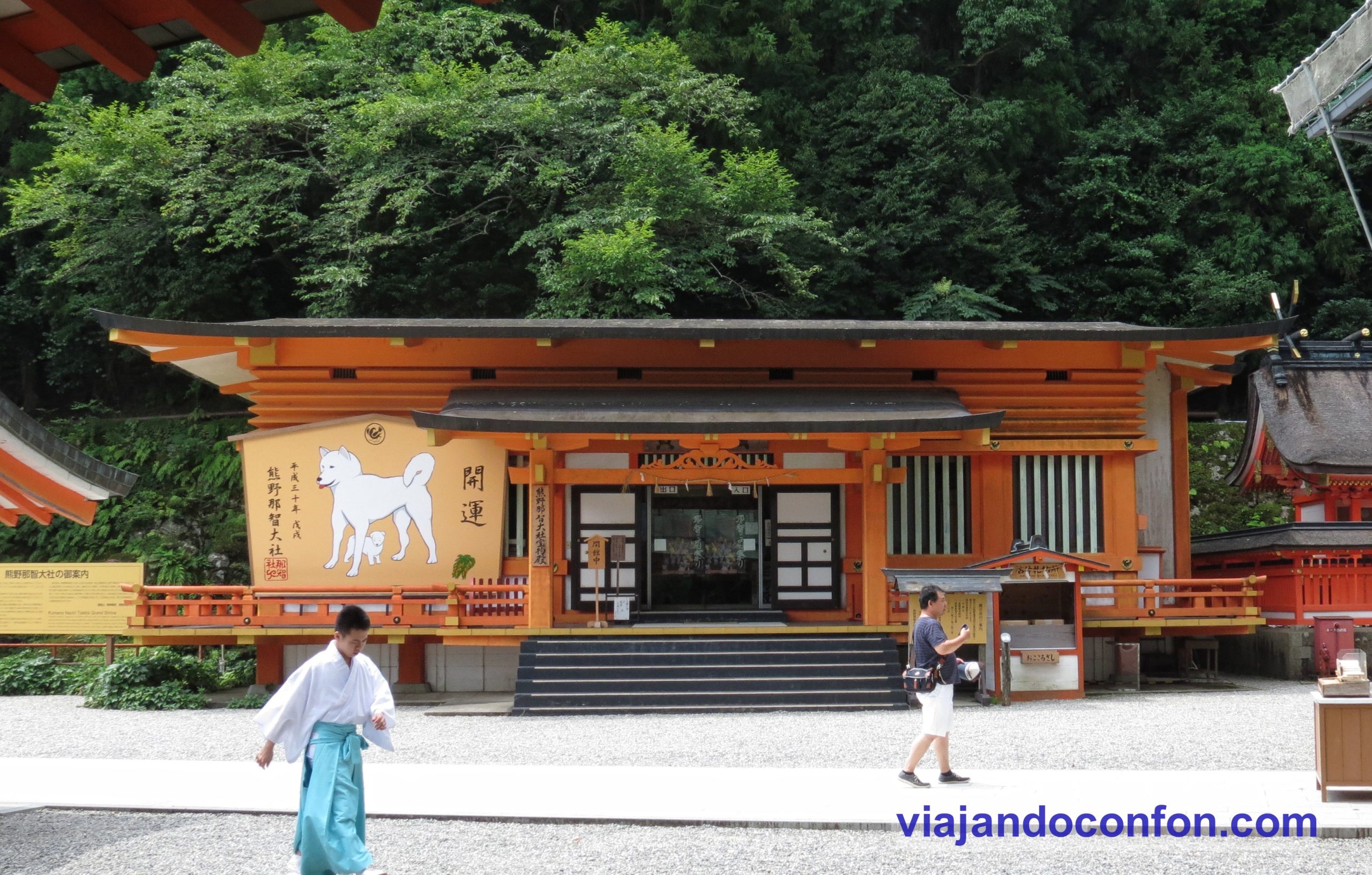
Here we find a viewpoint where we can observe spectacular views of the entire valley.


Right next door is Seiganto-ji Temple (青岸渡寺), a Buddhist temple of the Tendai school dating back to the 5th century. It is the oldest building in the Kumano Kodo.
As soon as we leave, we find the best-known image of the Kumano Kodo and one of the best-known in Japan: the Nachi waterfall behind a three-story red pagoda.

The pagoda of the Seiganto-ji temple (青岸渡寺) is a very recent construction dating from 1972. You can go up paying but we did not.

At the exit of the temple, we find some stairs that, between huge cedars and camphor trees, go down to the Hirō sanctuary (飛瀧神社), at the foot of the impressive 133-meter-high Nachi waterfall.
Altogether the view is truly impressive.


The only bad thing is that then you have to go up the stairs again.
Just after the stairs is the bus stop where we take the bus back to Kii-Katsuura, after having an ice cream to mitigate the heat.
Back in the city, we ate at a small restaurant that the hotel owner recommended to us called めはり寿司二代目 (Mehari zushi nidaime). She is run by a very serious man, who only speaks Japanese, but has a menu in English. For 1,400 yen (€10) he gave us a varied menu with a tuna sashimi from the area that was delicious.

As soon as we finished eating, we ran to the train station and there we took the Limited Express Kuroshio at 4:15 p.m. and at 4:38 p.m. we got off at Shingu to visit the great shrine of Kumano Hayatama Taisha (熊野速玉大社). Unfortunately it closed at 5:00 p.m. and we caught it closing. Even so, we were able to walk around the enclosure and the truth is that the race we gave ourselves was worth it.

Taking advantage of the fact that we had gone to Shingu, we took a walk through the city to the castle ruins, from which there are beautiful views of the city on one side and the Kumano river on the other.

Descending from the castle we approached the small temple of Asuka, one of the auxiliary temples of the great sanctuary of Kumano Hayatama Taisha (熊野速玉大社).


Already exhausted we went to the station to return to Kii-Katsuura. But along the way we came across a building that seemed to be Chinese in style, which turned out to be Jofuku Park. It is a small park dedicated to Jofuku, a character sent to Shingu more than 2,000 years ago in search of the elixir of life.

At 19.02 we got on the train back. At the hotel, the owner offered us the sweet soup that she had told us about when we arrived the day before. It was a very, very sweet bean soup, but it tasted great and it went well as a snack.

After the exquisite snack we went to relax a bit at a nearby onsen. We chose the one from a luxury hotel called Katsuura Gyoen. It is a beach hotel but by paying 2,000 Yen (€16) per person you can use the onsen. This is amazing, it has a huge indoor and outdoor hot water pool with decoration as if you were in the countryside, it has a large hot pool and a smaller warm water pool. They want to stay there to live.
With the mountains in the background it was night and, to add more magic, there was a moment of the night when fireworks were set off. It was spectacular.
Already very relaxed after a hard day we went back to the hotel, after going through the familymart to catch dinner and sleep because the next day we had to get up super early.
July 25th
Today, around 6.30 we got up. We were going to see the tuna auction at the nearby KII-Katsuura fish market. At 7 we were already in the ship, from where we could admire all the bustle of the auction.
At the end of the auction, we sit for a while in one of the many onsen for feet that are scattered around the town, which are also free. There we relaxed our feet for a while before taking the train to Nagoya.


At 8.55 we took the direct train to Nagoya where we arrived at 12.41 noon. We left our things at the hotel (the same as a week before) and ran to the nearby city of Gifu.
In Gifu, just outside the station we have a golden statue of the famous daimyō Oda Nobunaga (織田 信 長), who lived for 9 years in Gifu and was the base where he began to unify the country. This historical character is present throughout the city.

Right there we got on bus no. 80 to visit Mount Kinka (金華山), which is where Gifu Castle (岐阜城) is located. But before going up, we pass the Shōbō temple at the base of the mount.
In this temple is the Great Buddha of Gifu (岐阜大仏). A seated image of Shaka Nyorai. The image, which measures more than 13 meters, was completed in 1832.

After visiting the small temple we went to a familymart to hydrate ourselves a bit and cool off in the air conditioning and we continued on.
We took a walk in Gifu Park while going in search of the castle cable car. The cable car costs 620 yen one way (€5) and 1,080 return (€8.70). This time we took a round trip since after so many days we were starting to get tired and it was very hot.
The trip lasts about 5 minutes and a girl will explain things to you in Japanese, I suppose about the views and the castle. We were the only westerners there.
The views from the top are truly spectacular. For 200 yen (€1.60) you can enter the castle and look at the views but we didn’t. The views were already spectacular enough from the base of the tower. We settle for seeing them from there.

We went back down by cable car as we were quite tired. We took another short walk through Gifu Park and returned to Nagoya for dinner.
As we were about to leave the hotel, one of the heaviest downpours we have ever experienced fell. In no time, rivers formed in the streets.
We had dinner at the Sekai no Yamachan Ikeshita-ten restaurant, a chain specializing in typical Nagoya wings. The truth is that it was an ode to frying. It was good but too expensive for a fry up. It cost us 3,369 yen (€27).

After dinner we took a short walk through the Sakae area, going up to the terrace of the Oasis 21 building, which is a bus station and shopping center, from where you can see the Nagoya tower in all its splendor.

July 26th
We get up super early again. Today is a new hiking route: The Nakasendo route. It is an old route that linked Kyoto with Edo (present-day Tokyo). We did the most famous route, which is the one that joins the towns of Magome and Tsumago.
At 8 in the morning we took the Shinano Limited Express train line to Nakatsugawa, where we arrived at 8:49.
While we were waiting for the bus, we went around the tourist office, which is also a huge souvenir shop next to the train and bus station. There I bought a fish-shaped pastry that was like a kind of dorayaki filled with watermelon paste. It was very tasty by the way.

At 9.10 the bus left for Magome. The ticket costs 560 yen (€4.60) and takes, in principle, about 25 minutes. I say in principle because before leaving Nakatsugawa we had an accident against a car that left us standing for ten minutes until another bus was sent to pick us up.
Around 9:45 we arrive at Magome, rest station number 43 on the old Nakasendo route.

In the town there are some museums but we started directly. Things start off well since the town is uphill. As soon as we start, we gather strength by buying a kind of dorayaki stuffed with roasted chestnuts at a stall. Exquisite.

In the middle of the town we find the tourist office. They offer you various services. You can take a map, you can buy or rent bells to scare off the bears and they also have a left-luggage service (for a fee) to leave your suitcases. They also give you all kinds of information about the route.
The town is well cared for and beautiful, although it seems that it is only because it is oriented towards tourism as if it were a theme park.
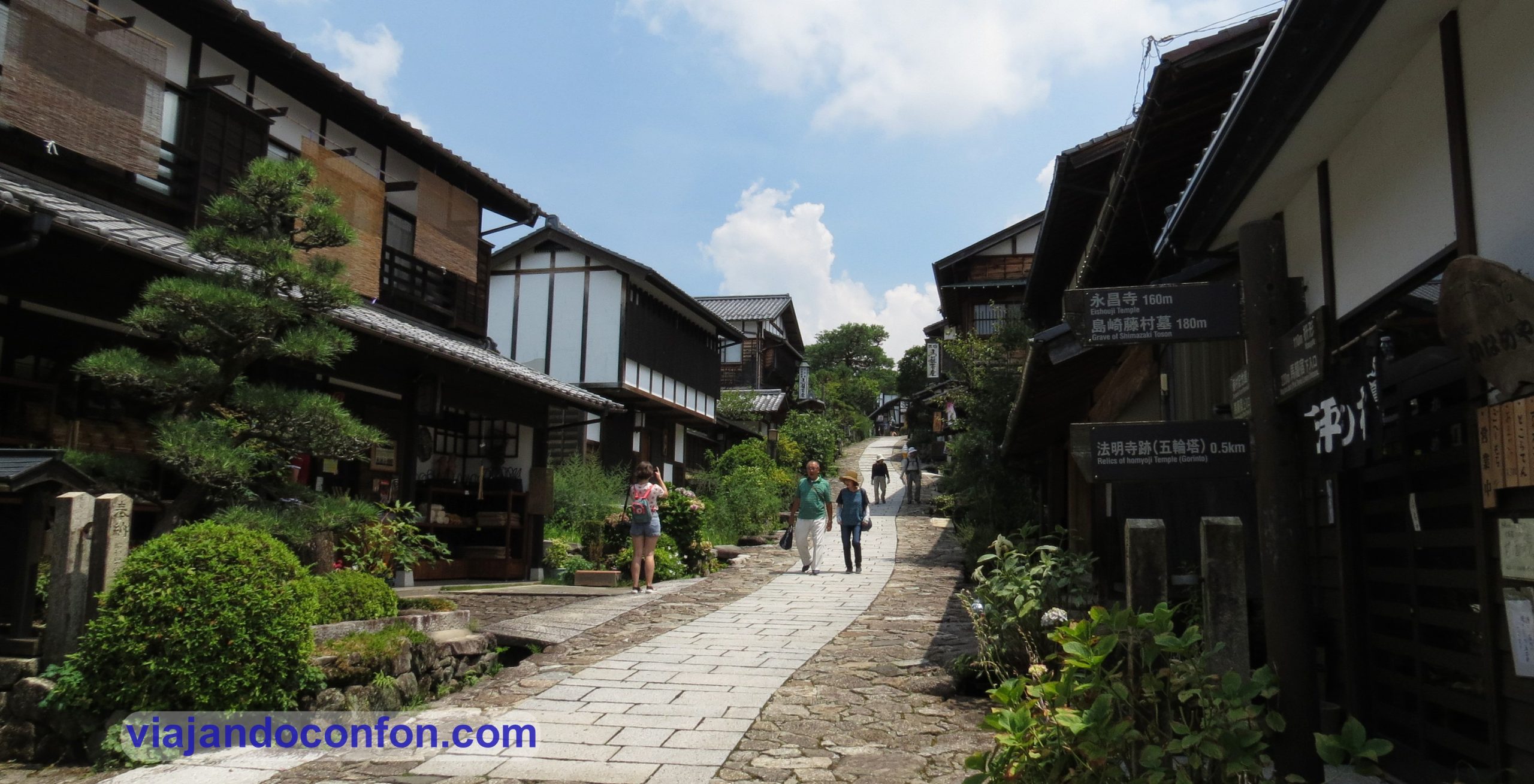
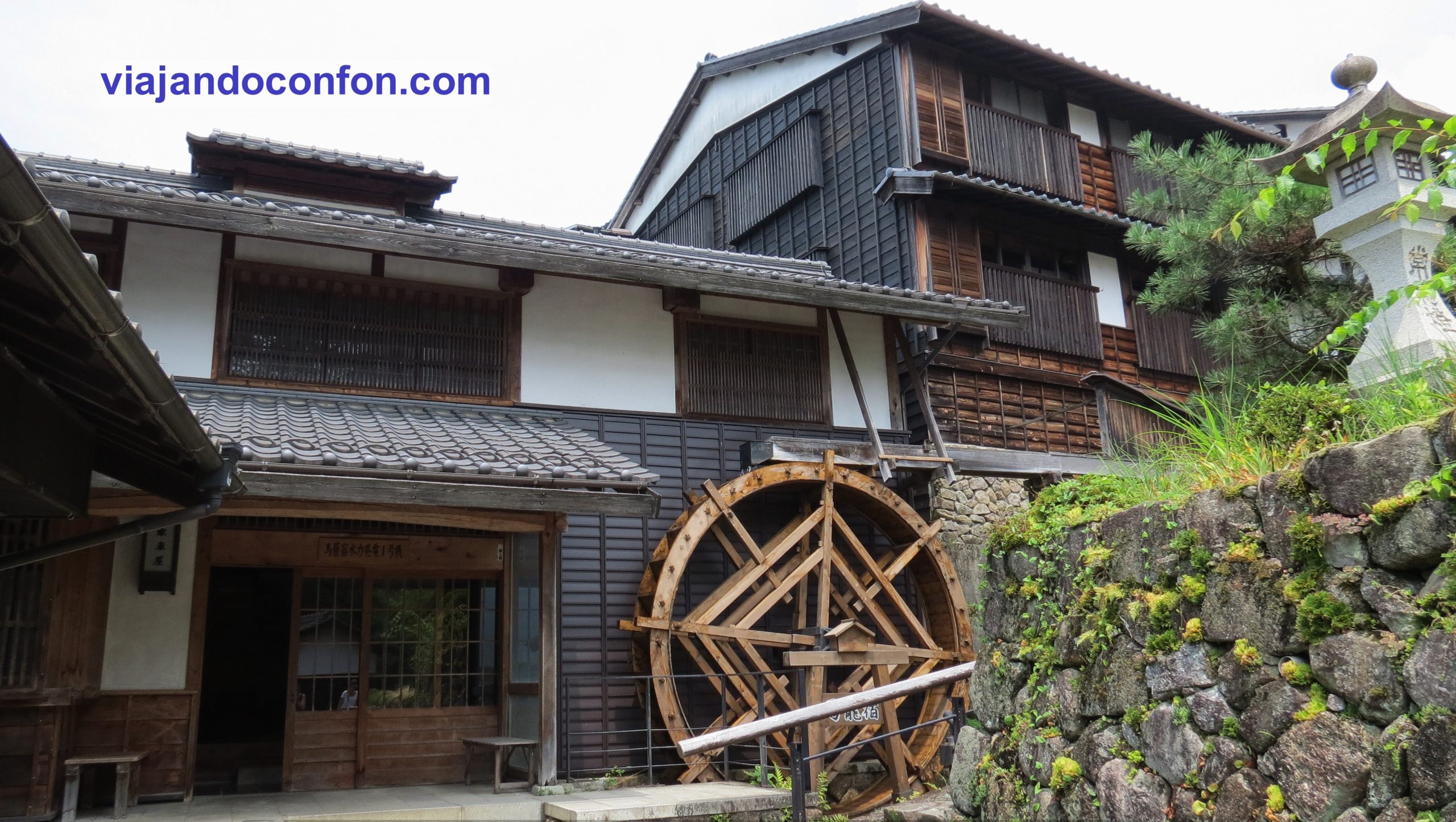
We continue going up to the end of the town where there is a viewpoint where we take a break to admire the impressive views of the valley. The views in winter have to be spectacular with the snowy valley.

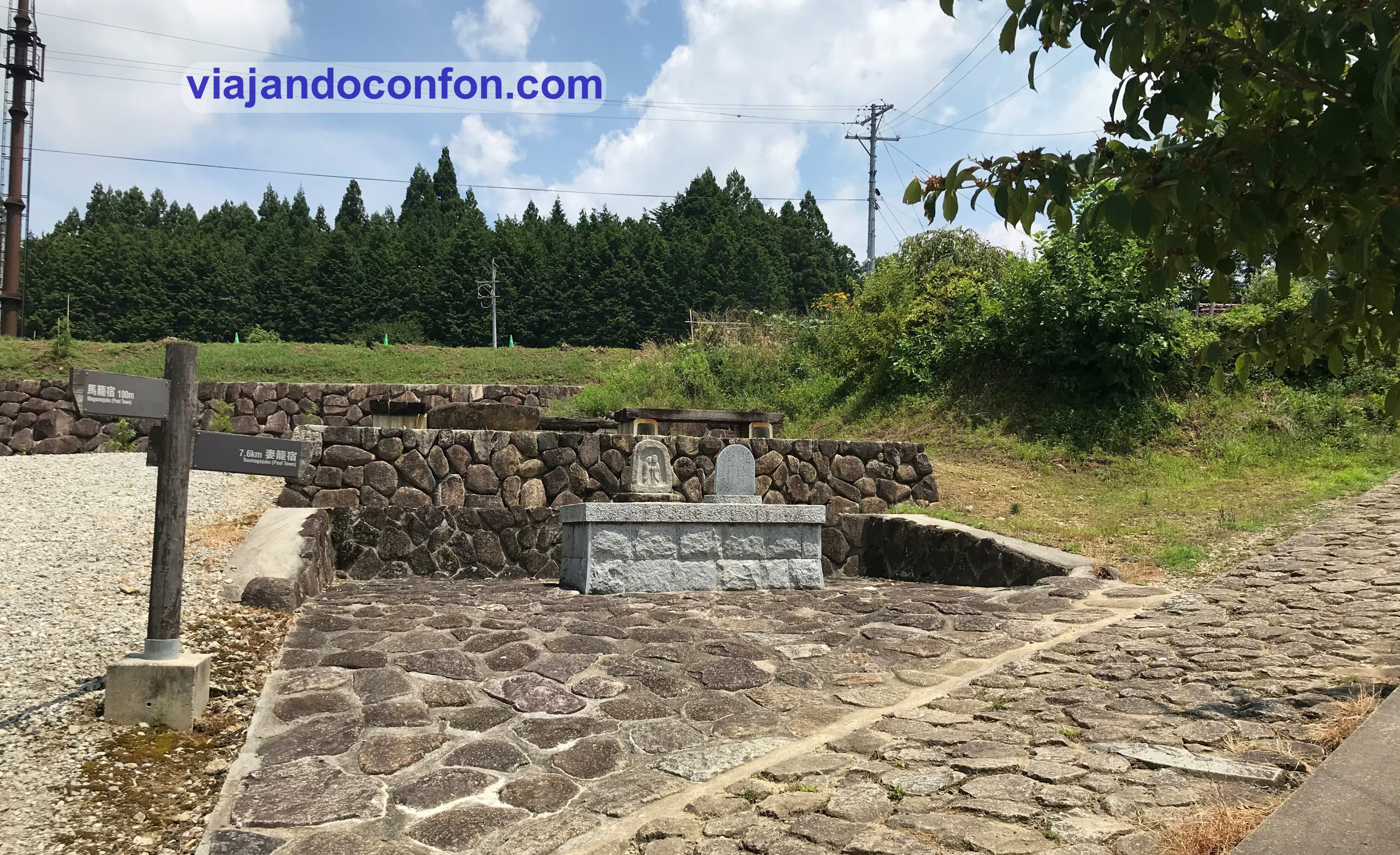
We follow the road, from here, 7.6 km separate us from Tsumago.
Along the way we find bells to ring and scare the bears away. The truth is that I don’t know if they really work because we didn’t see a single one on the entire route.
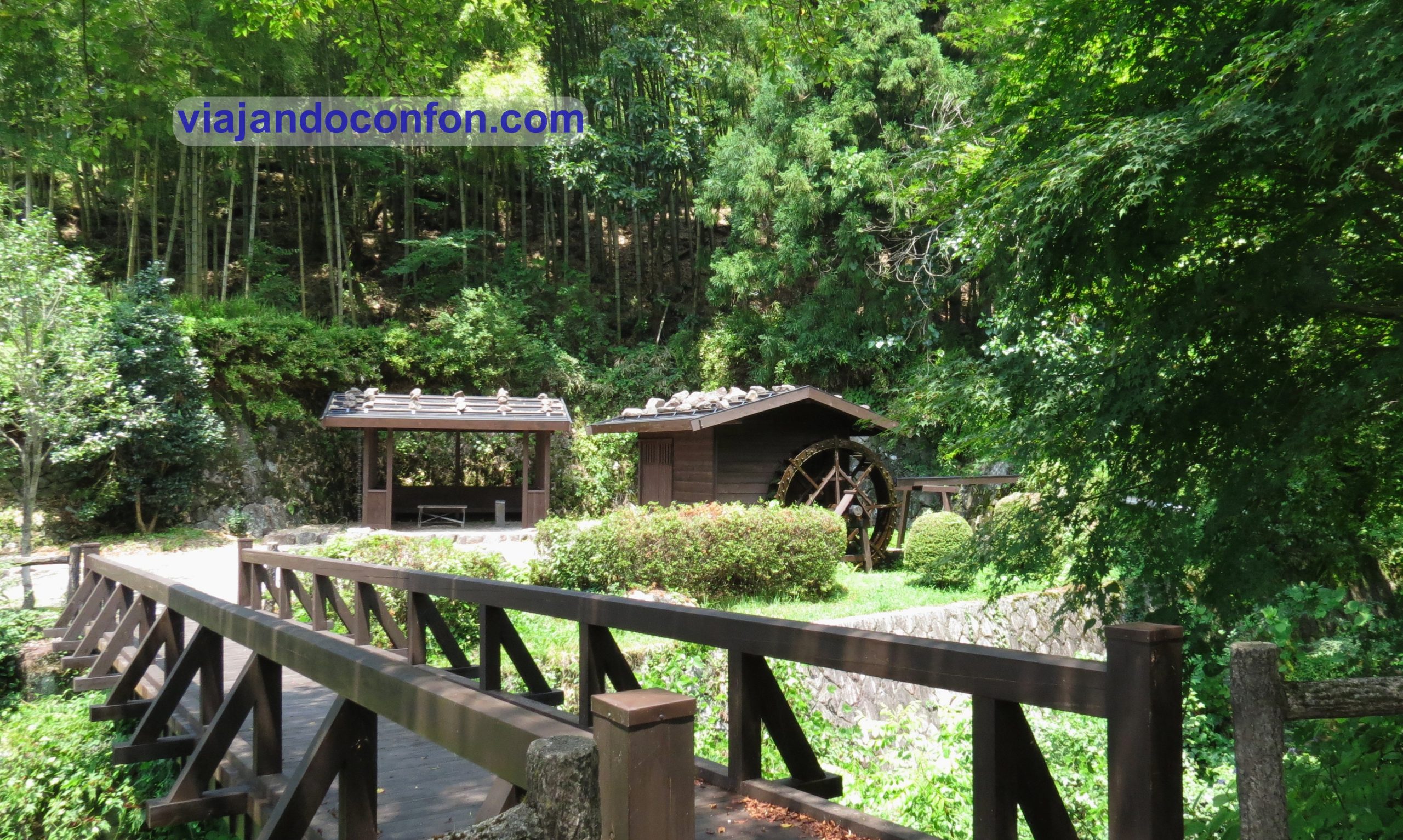
About two kilometers away we find the Kumano-jinja sanctuary (熊野神社), a good place to take a short break in the shade.

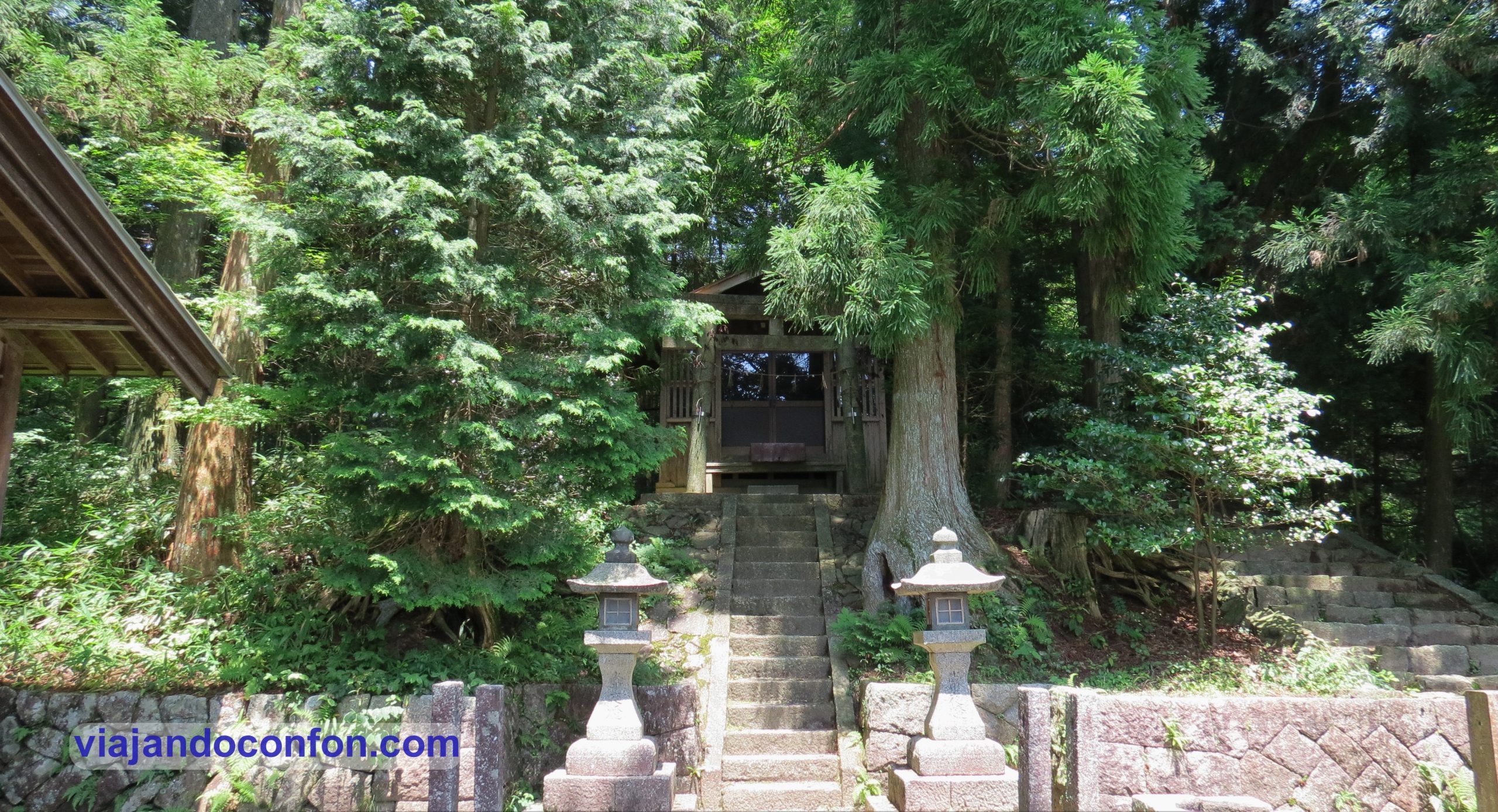
We continue in the spectacular wooded environment scaring bears. The truth is that the route is really impressive.
After about 3 km we find a tea house in the middle of the forest. There they offer us rest in the fresh air and a tea in exchange for a tip.

A little further on we sat in the shade to eat some sandwiches that we had brought for lunch.
The tranquility of the environment infects you and you take it very calmly. A tranquility that is only broken when a tourist passes by doing the route. Especially if he’s wearing a scary bell.
After gaining strength we continue the path. Several kilometers later we leave the forest and the path continues through an area of orchards until it reaches Tsumago, rest station number 42 on the old Nakasendo route.

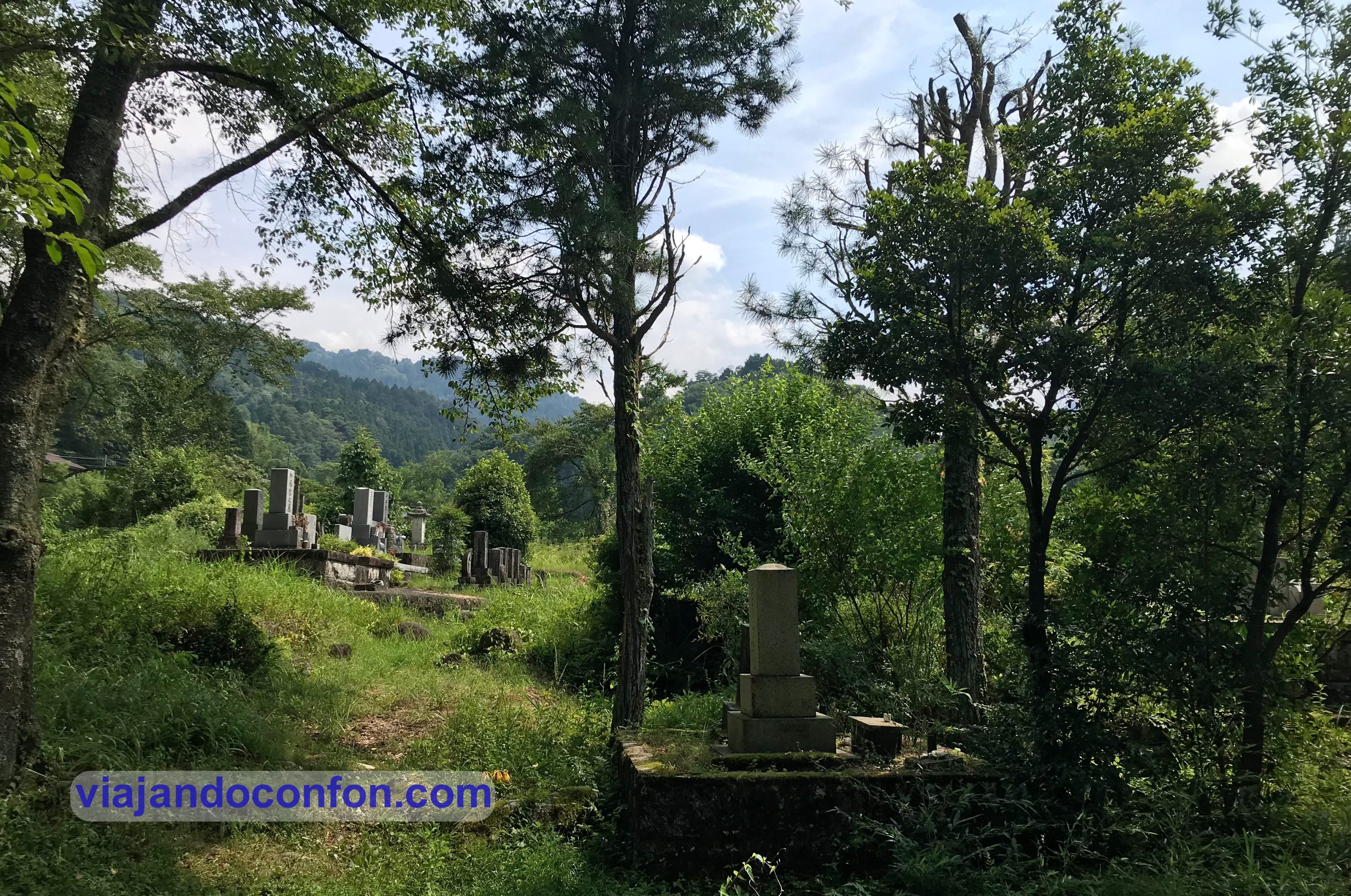
Tsumago gives the impression of being less artificial than Magome, but it is still noticeable that it is very well cared for thanks to tourism.
It has several points of interest such as the Kotokuji temple or the Nagiso museum, passing through craft shops.
It also has a tourist information office where they give you all kinds of information and where there is Wi-Fi and you can rest in the cool air.
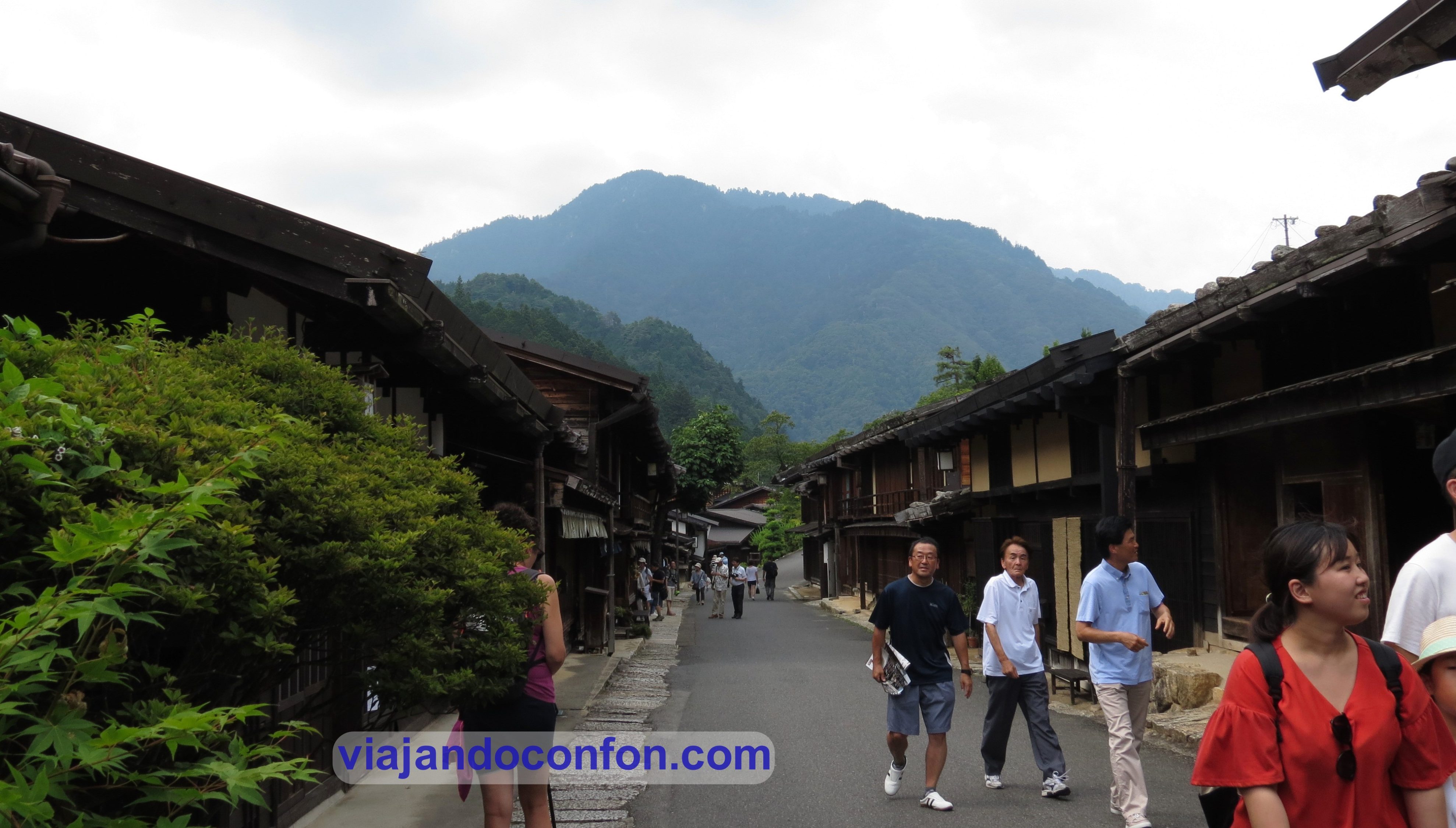
We took a short walk through the town and got on the bus to the nearby town of Nagiso. There we take the train back to Nagoya at 16:55.
At 18.05 we were already in Nagoya. We went straight to the hotel to take a shower and immediately went to the street to take a walk around Nagoya.
We were walking around the commercial area of Sakae. At the sunshine mall there was a little concert by some kind of boy idol group and it was all pretty funny.
From how organized the followers were to the dances they did.

We went to freak out for a while at the pokemon center. It is located inside the luxurious Matsuzakaya shopping center (I don’t know how they let us in with the pints we were wearing).
Since we hadn’t walked enough that day, we went in search of Nagoya Castle.
At that time it was already closed but we went around the moat hoping to see it but we only managed to see the highest part and several defense towers.

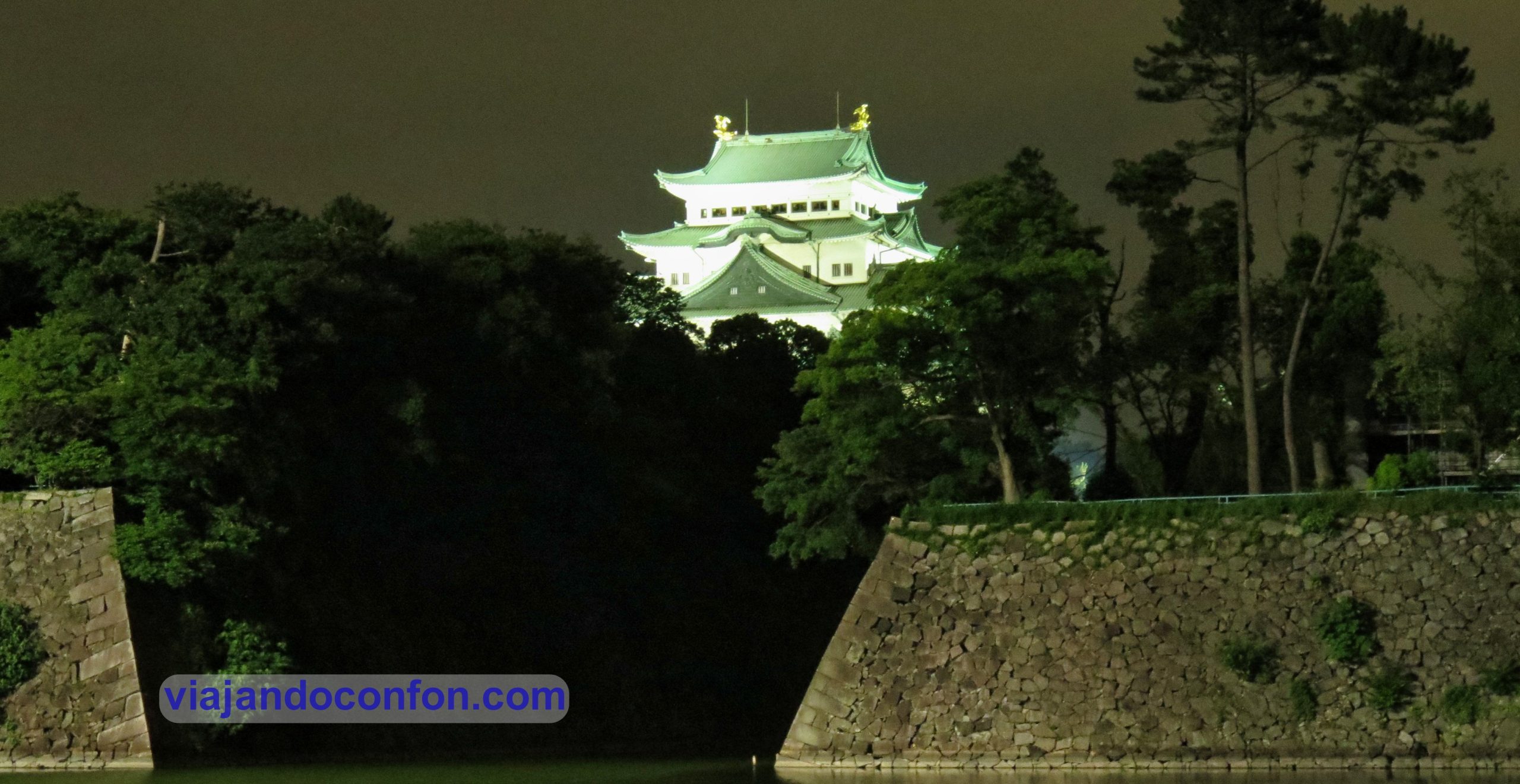
After the huge tour we did, we went back to the Sakae area to eat a delicious tonkotsu ramen in one of the Ichirán chain stores. And with a warm belly to the hotel to rest the 28 kilometers that we had walked that day.
July 27th
This is starting to end, it’s time to return to Tokyo. We took the shinkansen early to make the most of the day.
Around 10 in the morning we were already in Tokyo. We left our things at the hotel, which was the same as the first few days, and we went to Asakusa.
Due to personal circumstances, in 2017 I promised to return to Senso-ji Temple one day to make an offering. Promised is debt.

There were so many people that instead of going down Nakamise street, we went down one of the parallel streets. Wonderful idea because there we discovered a place where you can get melonpan filled with ice cream, what a delight!

Before entering the temple we purify ourselves with incense. We make our queue, and make the promised offering.
Then we take out an omikuji through the stick system with the number in Japanese (thank goodness there is always someone to help you).
As this time the omikuji predicted “the best” of luck, instead of leaving it at the temple, I brought it home.
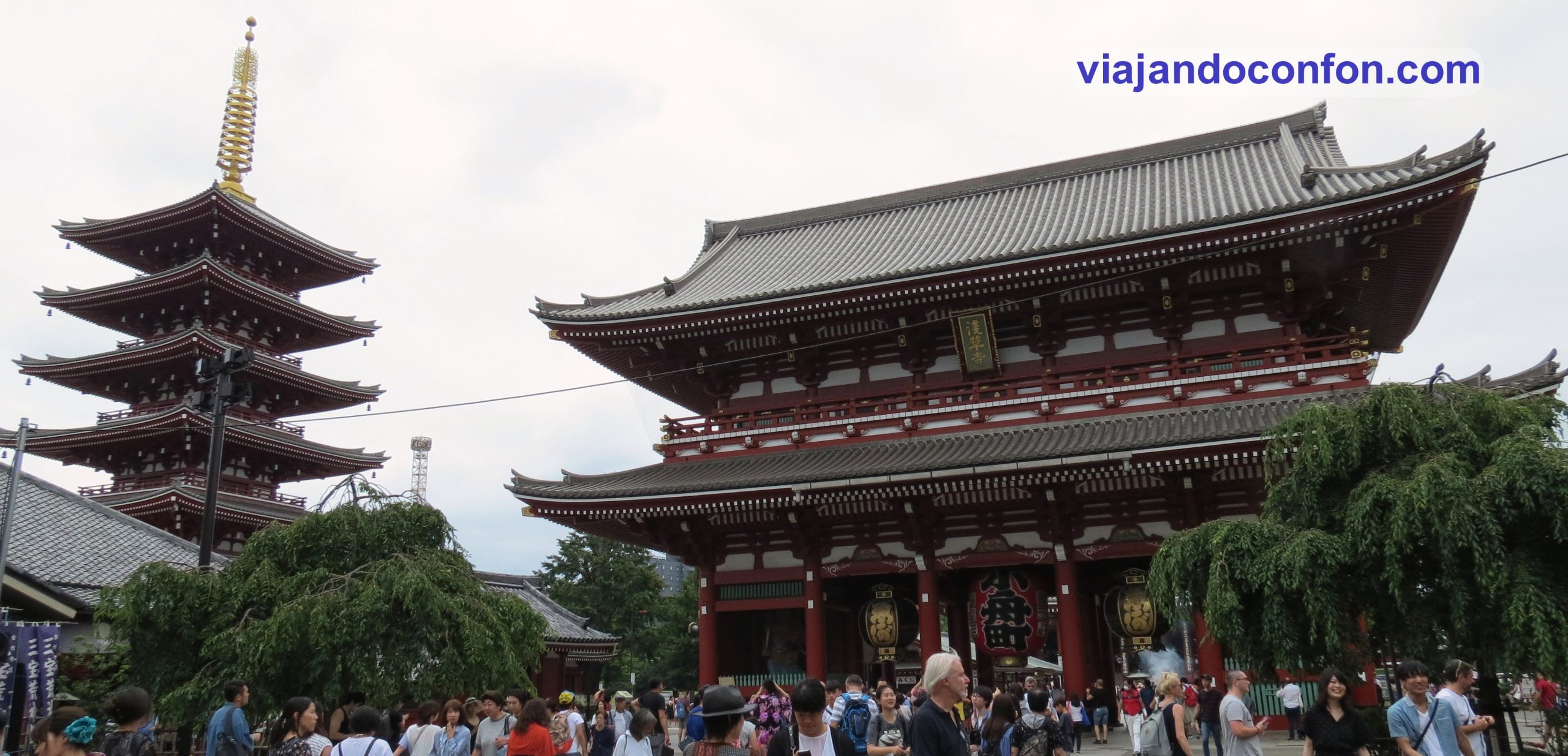
There were so many people that it was uncomfortable to walk around the temple grounds. We went out the back door in search of an ice cream shop specializing in matcha tea ice cream. They have different intensities of flavor, which I had seen on a blog.
It’s called Suzukien Asakusa (壽々喜園). We did our queue and I ordered with intensity 5. It was delicious. While we were at it I bought a jar of matcha tea to bring home.
From there we went to Shinbashi to eat karaage (Japanese fried chicken) at a place we knew in 2016 and loved it is called Karayama Shinbashi (からやま 新橋店).
On that day the traffic in the area was cut off and in the station square there was a kind of festival where there were food stalls and a stage where traditional dance performances were being staged.
From there we went for a walk in Shinjuku. We visited a few shopping malls and happened upon the official store of the 2020 Olympics that had opened two days earlier.

Near sunset, we went up to the observation deck of the Metropolitan Government Building.
The observation deck has breathtaking 360º views and it is said that on clear days you can see Mount Fuji. Three attempts in two years and we still can’t see it.
The views as the sun goes down and the city lights up are amazing. There is also air conditioning, vending machines, gift store, wifi and a restaurant, and admission is free.
Find the best activities at the best price in Tokyo with Civitatis:
On the way back from the viewpoint, already at night, we went for a walk in Kabukicho. It is the adult entertainment area par excellence in Tokyo.
There are numerous gigantic karaokes, bars, nightclubs and love hotels. Both for men and women. Although most of them are run by the yakuza or Japanese mafia.
I have read in some blogs that the PR people are very aggressive. I don’t know if it was because I went with my partner but they didn’t say anything to us.

The truth is that it is a very curious walk with buildings full of neon and local geeks like the robot restaurant or the giant godzilla in a multiplex.
From here we went back to Kamata, the neighborhood where we have the hotel. There, next to the JR station, there is a ribbon sushi restaurant that we discovered in 2016 that is delicious and relatively cheap. The Sushi Matsu Kamata 2 gōten (すし松 蒲田2号店). We ate a total of 12 dishes and it cost us 2,980 yen (22€).
That night we go to bed with uncertainty as a typhoon is expected to pass through Tokyo the next day.

Buy with Japan Experience your Japan Rail Pass at the best price. You can travel around Japan for 7, 14 or 21 days.
July 28th
It is raining in Tokyo at dawn. It seems that the expected typhoon is deflected and will only catch us by a glancing blow, so we go outside.
Today is a new excursion. We go to Kamakura to tour the area on the Enoden electric railway.
For this we take the Keihin-Tōhoku line to Yokohama and there we change to the Yokosuka line to Kamakura station, where the rain seemed to give a little respite.
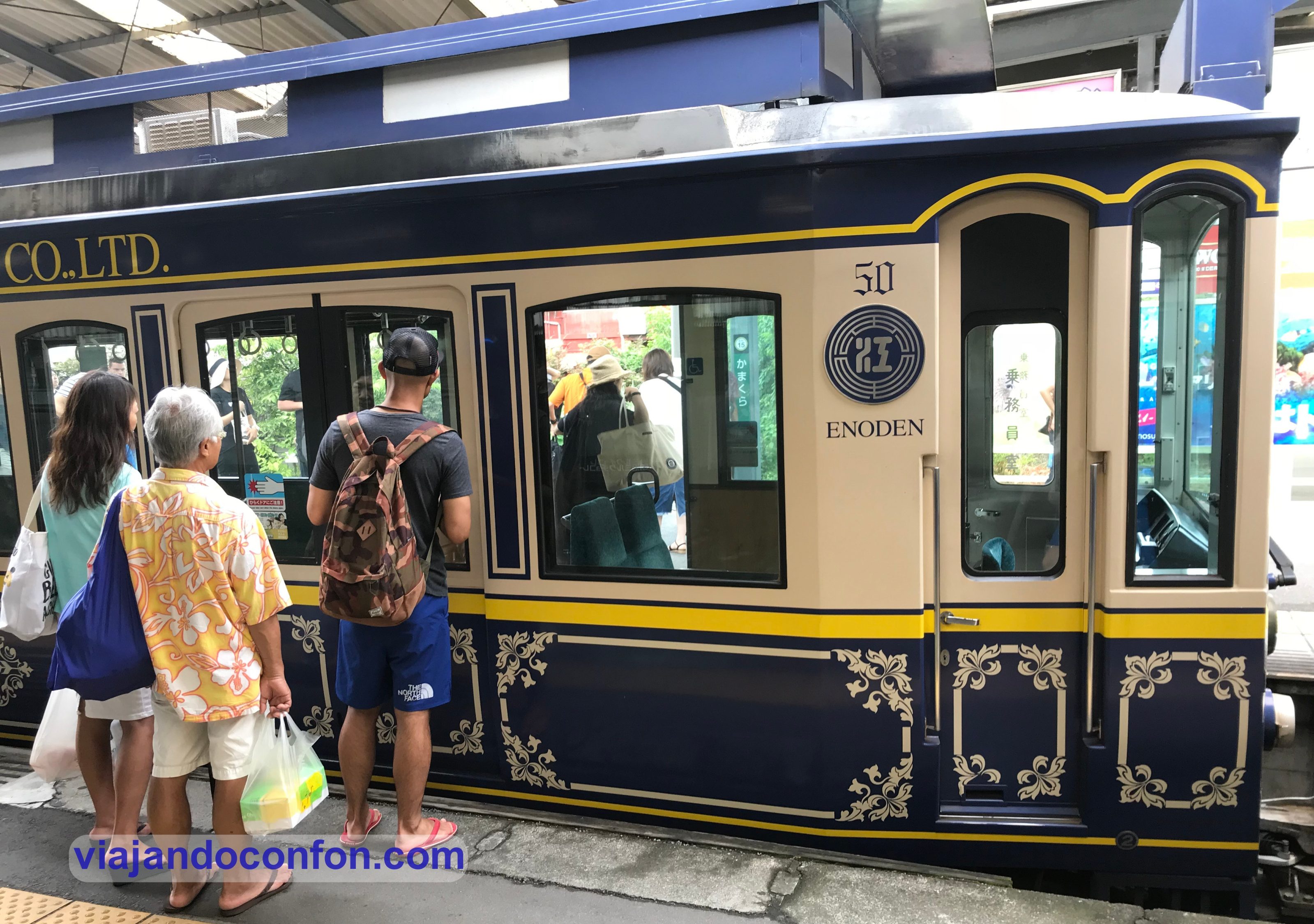
You can visit Kamakura with the beautiful Civitatis tour:
There we stamped our stamp booklet with the corresponding station stamp and made our way to the Buddhist temple Kōtoku-in (高徳院). This is where the great Buddha of Kamakura is located.
In 2016 we also visited him and bought a lucky charm, which I don’t know if it’s because of him or it’s coincidence, but from here I had a couple of very good years and with very, very good luck, so it was time to make a new offering of thanks, just in case. I am tremendously grateful to him.

We return to the Enoden in search of the next and main destination of the day: Enoshima island.
We get off at Enoshima station. We put the corresponding stamp and we go for a walk to cross the 600-meter bridge that connects Honshu with Enoshima and reach the island.
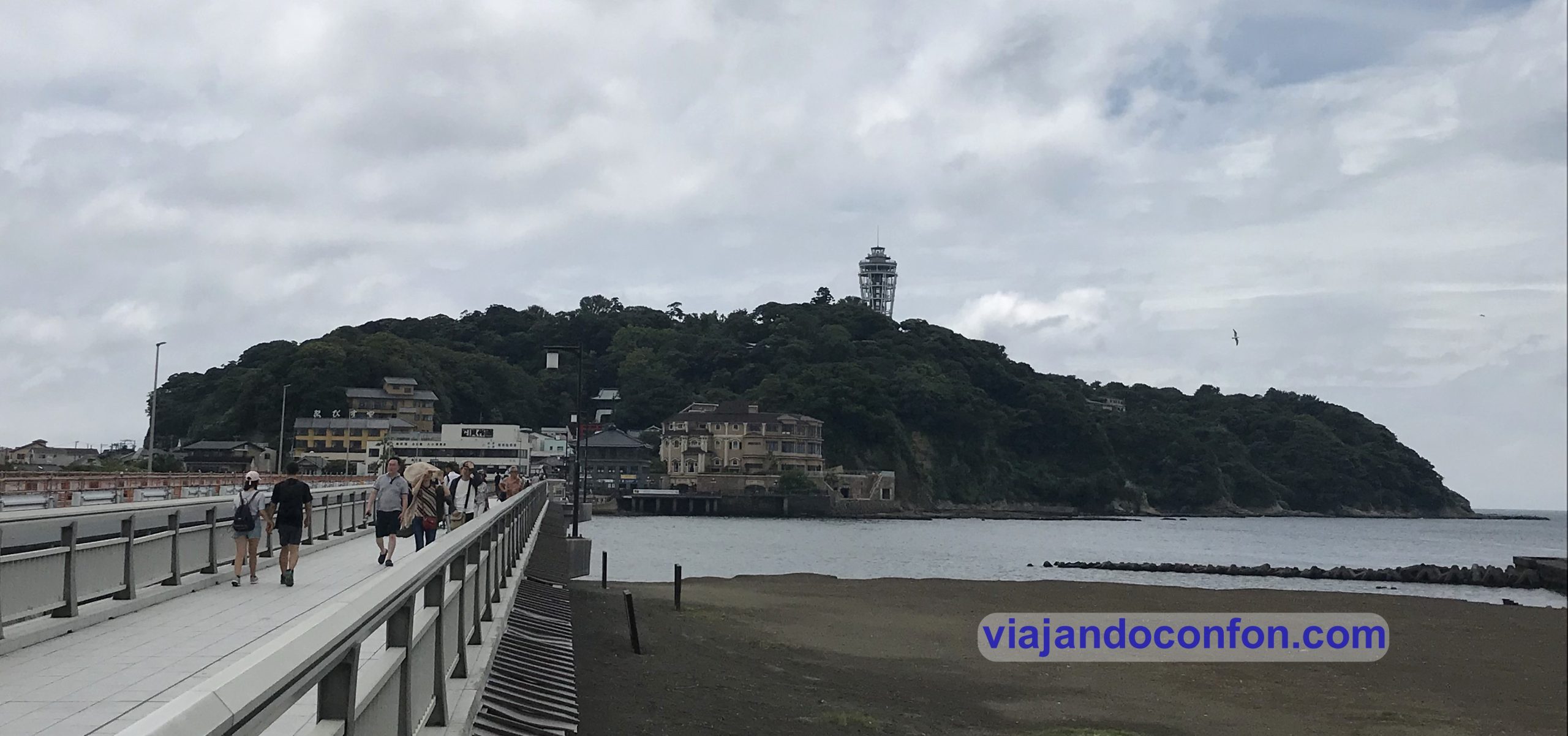
As we finish crossing the bridge, we arrive at Benten-Nakamise Street. The street is filled with small souvenir shops and tourist restaurants.

On this same street we cross a large bronze Torii that indicates that we are entering a street that leads to a Buddhist temple.
The torii was originally made of wood but was rebuilt in bronze in 1821.
At the end of the street we find a large red Torii that indicates the entrance to the Enoshima Shrine. Next, a few steps after the Zuishinmon gate.

Just before the gate, on the left hand side we can get a ticket for about 400 yen (3.22 €) to go up the escalators, but we decided to walk up which was more charming. By the way, the escalators are only for going up. To go down, you have to walk.
We continued climbing and arrived at the Enoshima Shrine complex.

It is a complex of three pavilions: the Hetsunomiya shrine, founded in 1206 and dedicated to the deity of the three sisters.
The Hoanden Hall where the statues of Happi Benzaiten from 1182 and Hadaka Benzaiten, from the Edo period, are located.
It is dedicated to the three goddesses of Munakata. Until the Edo period, it was dedicated to Benzaiten and was called Eshima Benten or Eshima Myojin.
The current enshrined deity was changed when Shinto and Buddhism separated in the Meiji period.
From here we have a nice view of Benten-Nakamise Street and the city and its beaches.

We continued climbing and reached another impressive viewpoint with even better views than the other one.
There was a post with a small platform that turned out to be a place to rest the camera on the cell phone to take a selfie. Later on we would see more of these very well placed posts.
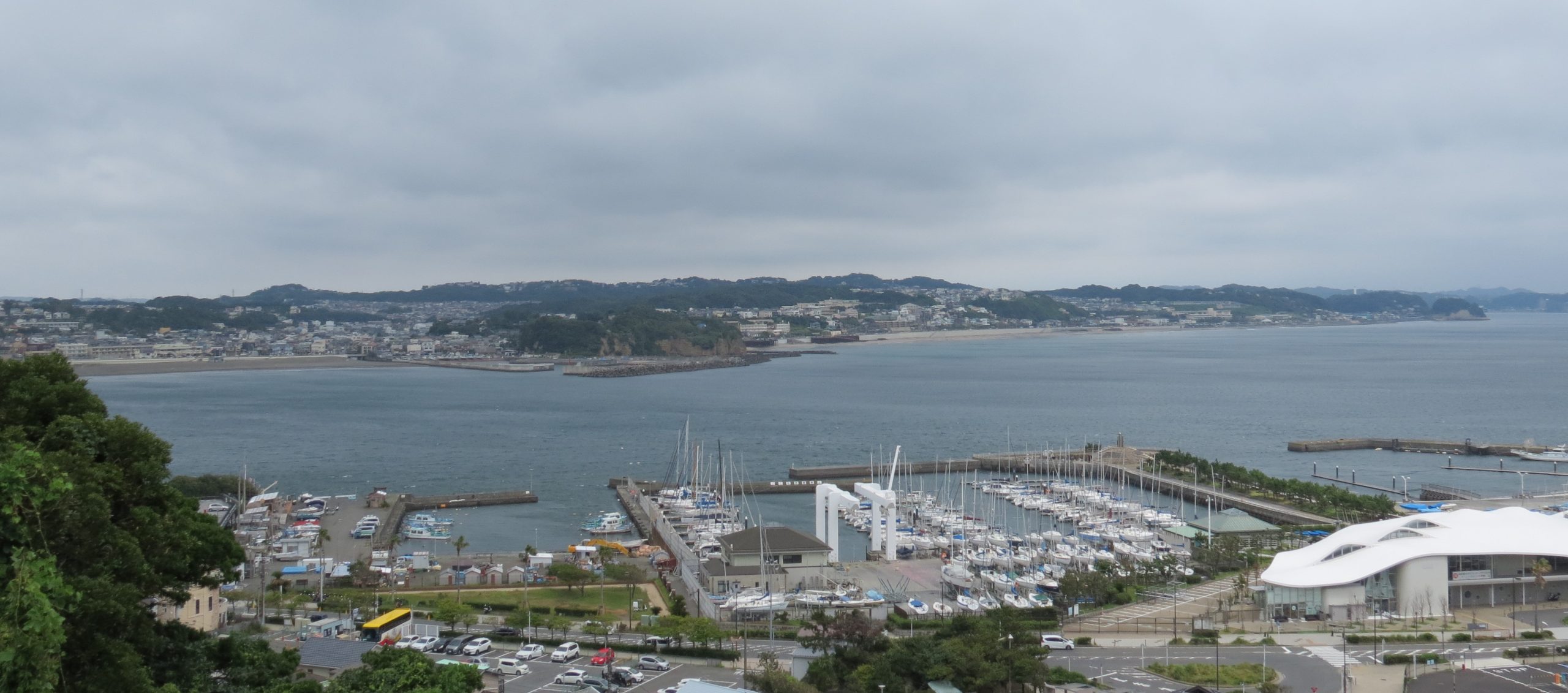
A little further on from the viewpoint, without going any higher… we arrive at the second shrine of Enoshima: the Nakatsunomiya shrine.
Built in 853 and rebuilt in 1689 by order of the Tokugawa Tsunayoshi Shogun. It is dedicated to Ichikishima Hime no Mikoto.

A little further up we find the Samuel Cocking Gardens. It is an extensive garden of tropical plants created in 1880 by the British merchant Samuel Cocking.
As we did not have much time and there was an entrance fee, we passed on going in and continued on our way.

We took a walk around the upper part of the island and went on our way to the modern Buddhist temple Enoshima Daishi.
Built in 1993 and known for its huge 6 meter statue of Fudomyo. Inside they were performing some very curious chanting ceremonies in front of the fire that could be accessed without problems.
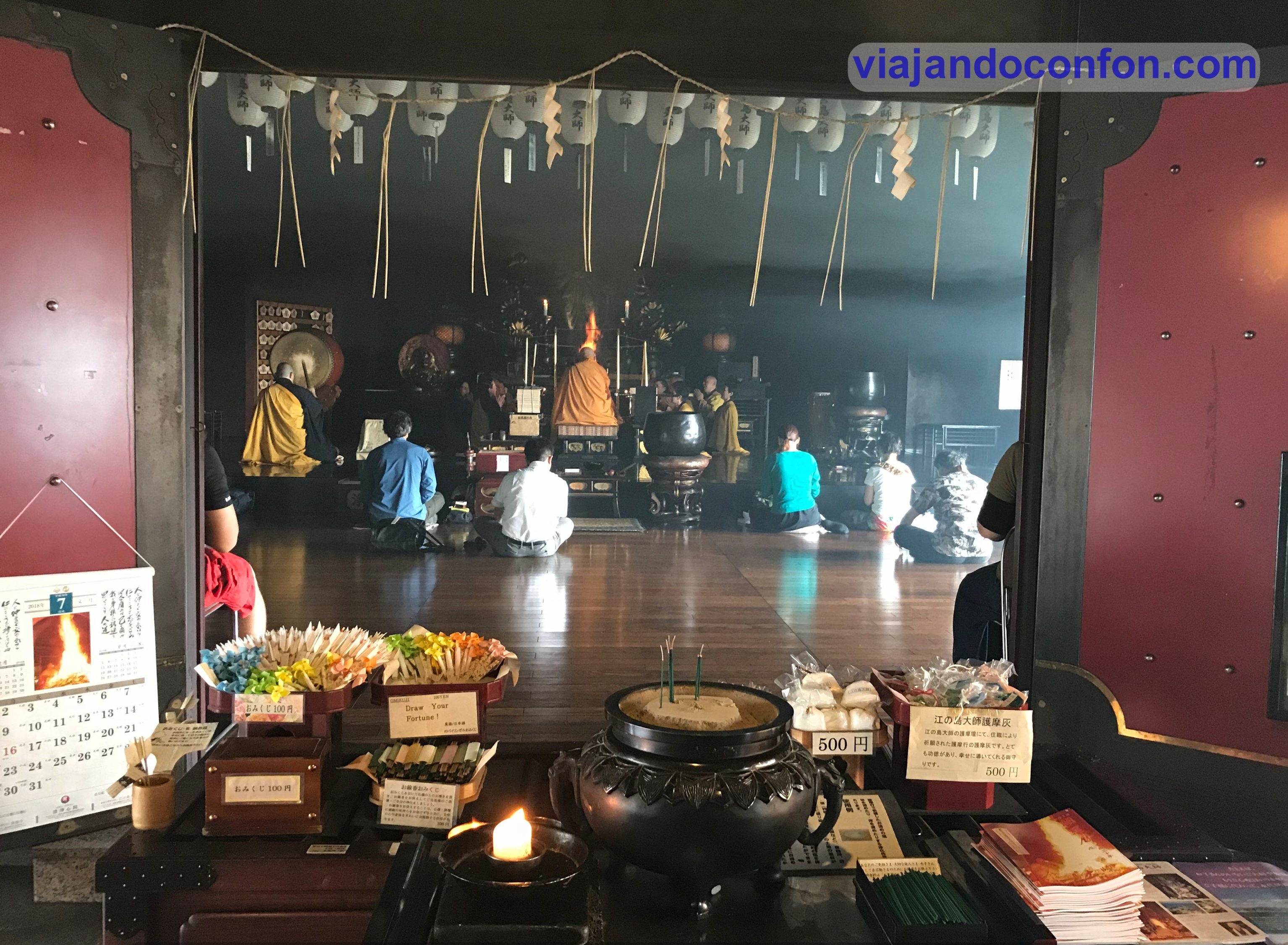
We continued our walk leaving behind small souvenir shops and restaurants. One of the locals that had caught our attention, since the door indicated that only locals, i.e. Japanese, were allowed.
We had read on some websites and blogs that this happened in Japan, but this is the first and only place where we have seen it. Although I do not justify it, I imagine that they have had some bad experience with foreigners, but the U.S. flag was well placed on the door ¿?¿?¿?


After passing these small streets, we arrived at the last and oldest of the three shrines of Enoshima: the Okutsunomiya Shrine.
It was destroyed by fire in 1841 and was rebuilt the following year.
One of the pavilions that caught my attention at the shrine was the Ejima Ryugu Shrine. It is a small shrine built in 1993 in a cave with a dragon at the top of the entrance.
The pity is that it was closed that day and we could not go in to see it. Just in front of it we found another post to take selfies.
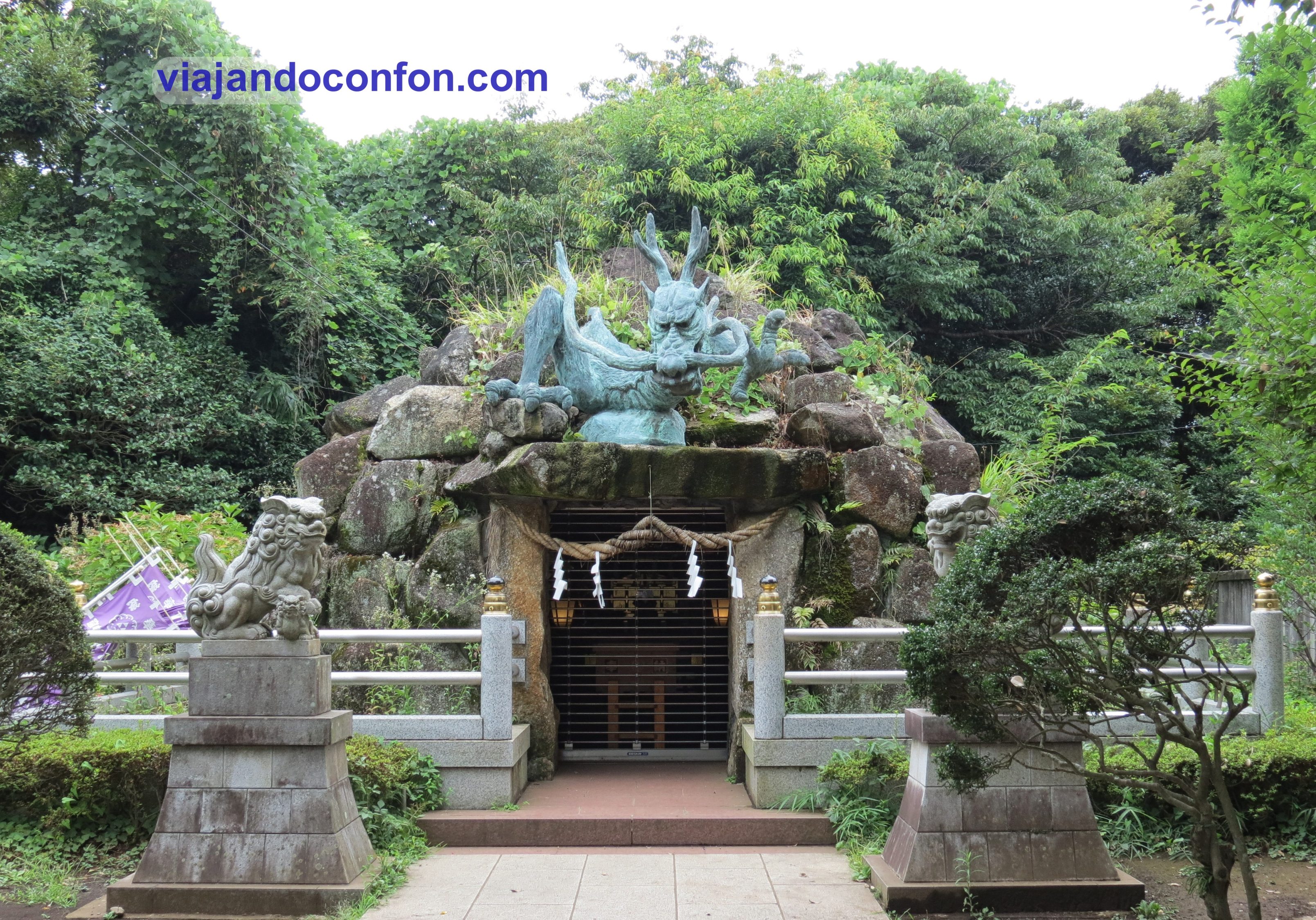
Nearby we find the lovers’ bell, which couples ring together and where they leave padlocks with their names on one of the fences near the bell. It also has its corresponding selfie pole and this gives a very good service, we can attest.
From here comes the good part, we start going down stairs… and down… and down… and down… and then we have to go up… and up… and up… until we reach the sea level.
There after a short walk along the rocky shore we arrived at the Enoshima Iwaya caves, which are caves that were created by tidal erosion.
We climbed back up the stairs and went all the way across the island on our way to Enoden again.
We got on the train and stopped at Gokurakuji station, which is basically a halt. By this time it was starting to pour rain but we still got out to see Shinsho Gokuraku-ji Temple (極楽寺). It is a temple of the Shingon Risshu sect built in the year 1,259.

Between the heavy rain and the time it was, it didn’t take us long to visit. In a while we were back at the Enoden station to take the next train.
Shortly after we got off again at the final station Kamakura to look for a place to eat under the rain of the typhoon.
The rain seemed to give a little respite and wandering around, we found a ramen place run by a rather old lady. There were only 3 or 4 tables.
We ordered a fried rice that was delicious and a ramen that was to lick the bowl. One of the best we have ever had.
The bad thing is that the name was in Japanese and does not appear in the street view. A pity to be able to recommend it.

While I was in the restaurant, the downpour started again. On top of that, on the way to the station my umbrella broke.
Back in Tokyo, we went to the Sunshine city mall in Ikebukuro, looking for some manga comics that I was looking for in a book off.
I found it and since it was closing time, my partner went to pay while I went to the bathroom. There something curious happened to him. The cashier came to talk to her in Japanese, and she was thinking that she was a westerner and that she didn’t understand a word. Until she realized that, of course, she was supposed to be speaking Japanese when she was getting 4 comics in her own language… Anyway… tourists.
After the experience and taking advantage of our last night in Japan and that it had stopped raining, we went to Akihabara for dinner and a last stroll through the freaky electronic town.
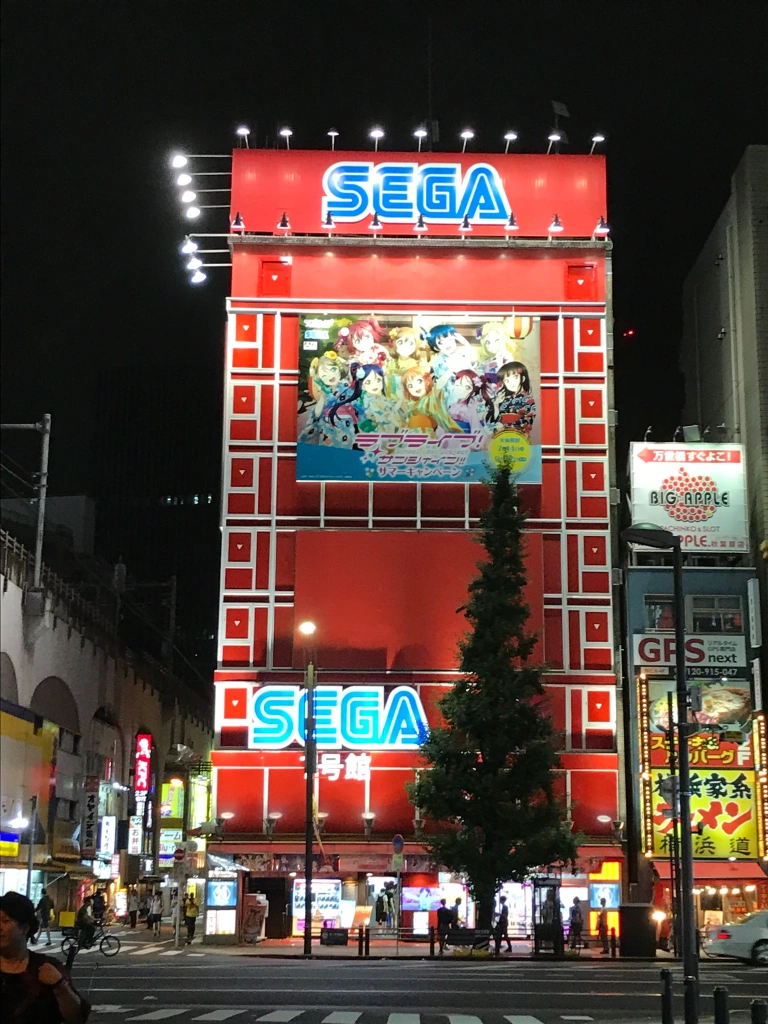
And to sleep.
July 29th
Last day in Japan and we have to take advantage of it. Today it’s time for a good geeky day.
We went to the neighborhood of Katsushika to see the statues of the anime series Captain Tsubasa. The only regret I have is that months later they renovated the station and made it even more themed.
To get there we took the private Keikyū Main Line, for 580¥ (4.40€), from Shinagawa station to the small station Yotsugi station.
As soon as we got out of the station we found the map of where the statues are. We started with the Bruce Harper statue next to the entrance to the station and from there, a walk through the neighborhood to find the 7 statues related to the series.
These statues are located there because the creator was from this neighborhood and they were placed there as a tribute and, by the way, to attract some tourism to the neighborhood.
The whole neighborhood is dedicated to soccer in every corner. We went looking for each and every statue until we arrived at Keisei Tateishi station where we took the train back to the south of Tokyo.
We got off at the Kabuki Theater stop. We were going in search of the Totobe restaurant. A simple sushi restaurant near Tsukiji that we discovered in 2016 where only Japanese workers had been eating. No tourists so it was great and cheap. But we were very unlucky and it turned out that they are not open on Sundays. Cachis la mar. It was time to look for a place to eat.
We decided to take the subway to Tokyo station to eat an exquisite ramen in Tokyo ramen street in a place that we also discovered in 2016. It is the Rokurinsha restaurant. To enter you have to queue for quite a while but it is worth the wait.

To end the visit in the country, we went to Harajuku for a last walk along the most geeky street: Takeshita Dori. We bought some gifts at the Daiso and strolled along the luxurious Omotesando street.

Already exhausted, we picked up our bags from the hotel and went to the airport. The flight was leaving Haneda at 21:55.
As soon as we arrived, we were told that there was a delay. We went to the counters to ask, and they told us that the baggage belts were not working. In an hour they would give the news over the loudspeaker again. We were given a voucher for 1,500 yen (12€) per head for dinner at the airport.
We left our bags there and went in search of a place to have dinner.
Haneda airport is inspired by the Edo period and the truth is that it is very cool. We decided to have dinner at a ribbon sushi place that was exquisite.

Finally, two hours later than planned, we took off for Paris and with this we said goodbye to Japan until next time. We will be back to Japan (hopefully in 2021 2022 2024 2026).
Discover the best activities and tours at the best price in Japan with Civitatis:
We continue with our second trip to Japan.
July 19th
Early morning and the train station. We take the shinkansen back to Kyoto at 9:08 in the morning. At 9.45 we arrive and we go directly to the hotel to see if we could leave our things. The chosen one was the Orient Gojozaka, where we stayed for a week in 2016. It is very well priced and is a small apartment with a kitchen, a desktop PC in the room with internet connection and, most importantly, a washer and dryer.
Remember to always travel with travel insurance. With IATI, specialists in travel insurance, you have a 5% discount for being our reader.
Upon arrival at the accommodation, at reception they told us that there was already a room ready that if we wanted to check-in now. Marvelous! We settled in and went to Kodai-ji Temple (高台寺).
The Kodai-ji Temple (高台寺 ) is located in Higashiyama next to the Ryozen Kannon temple and is one of the essential temples in Kyoto. It was founded in 1605 by Kita-no-Mandokoro as a memory of her husband, Toyotomi Hideyoshi.

Despite the heat, a very pleasant walk through its gardens is made, visiting the many pavilions of the temple and its small bamboo forest.
As soon as we leave the temple we find the Kodai-ji Sho museum (高台寺掌美術館), a small museum with old items and paintings. It is very curious and with air conditioning.
At the exit we went for a walk through the neighborhood until we reached a bus stop where we took one to the Heian Shrine (平安神宮). This sanctuary is another of the essentials of Kyoto, especially for the well-known and gigantic entrance Torii.

The Shinto shrine was built in 1895 to commemorate the 1,100th anniversary of the city of Heiankyō, to honor Emperor Kammu as the kami, or god of the city. There was a part under construction but you could see most of it (from shadow to shadow).
After the hot walk we went straight to eat at Ramen Miyako restaurant, which, as its name suggests, is a ramen restaurant. We discovered it in 2016 by chance and it’s possibly the best ramen I’ve ever had, so we have no hesitation in going back. You may have to queue but it’s worth it.

On the way out we ate some kakigori, traditional ice creams at the Cha-Cha ice cream parlor very close to the hotel.
After the refreshing break, we took the JR San-in Line from Kyoto Station to Sagano-Arashiyama Station. We wanted to see the Arashiyama Monkey Park which in 2016 we had to discard due to lack of time. Bad luck was upon us and it closed at 4:30 p.m. and there was barely half an hour left, so we have to leave it for a future trip.
We dedicated ourselves to walking through the area contemplating the Togetsu-Kyo Bridge (渡月橋), built in the Jowa period (834-848) is the most famous bridge in Arashiyama, which crosses the Katsura River. From it you can perfectly contemplate the change of seasons during the year, from the momiji to the cherry blossoms.
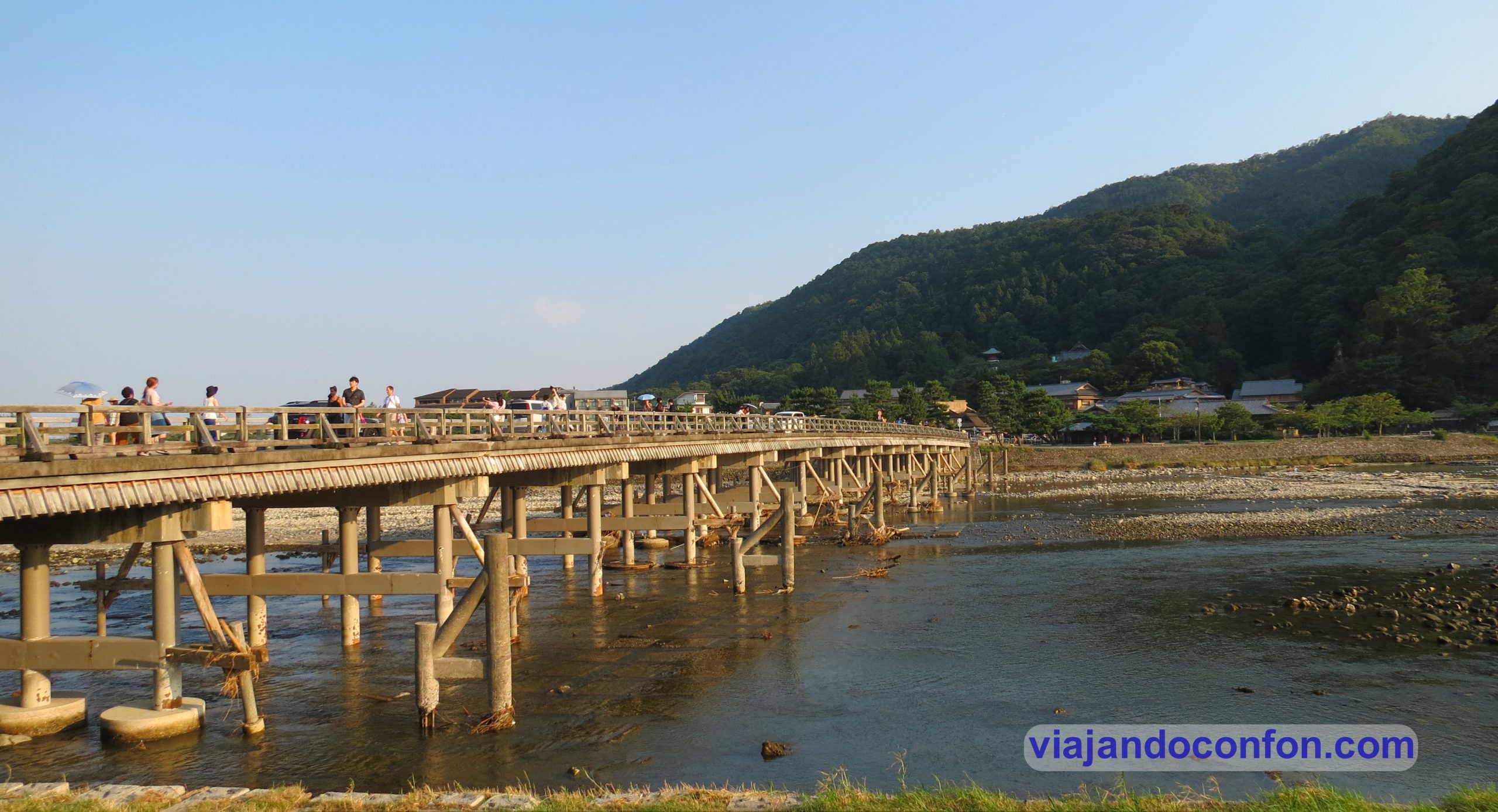
We continue the pleasant walk through the area until we end up at the Tenryu-ji Temple (天龍寺), one of the essentials of Kyoto. Built in 1339, it is one of the 5 most important Rinzai in Kyoto. It is next to the Arashiyama bamboo forest and is perfect to combine both visits. We arrived after hours and the pavilions were closed but access to the temple grounds was open. The enclosure is wonderful and has spectacular views of the mountains.
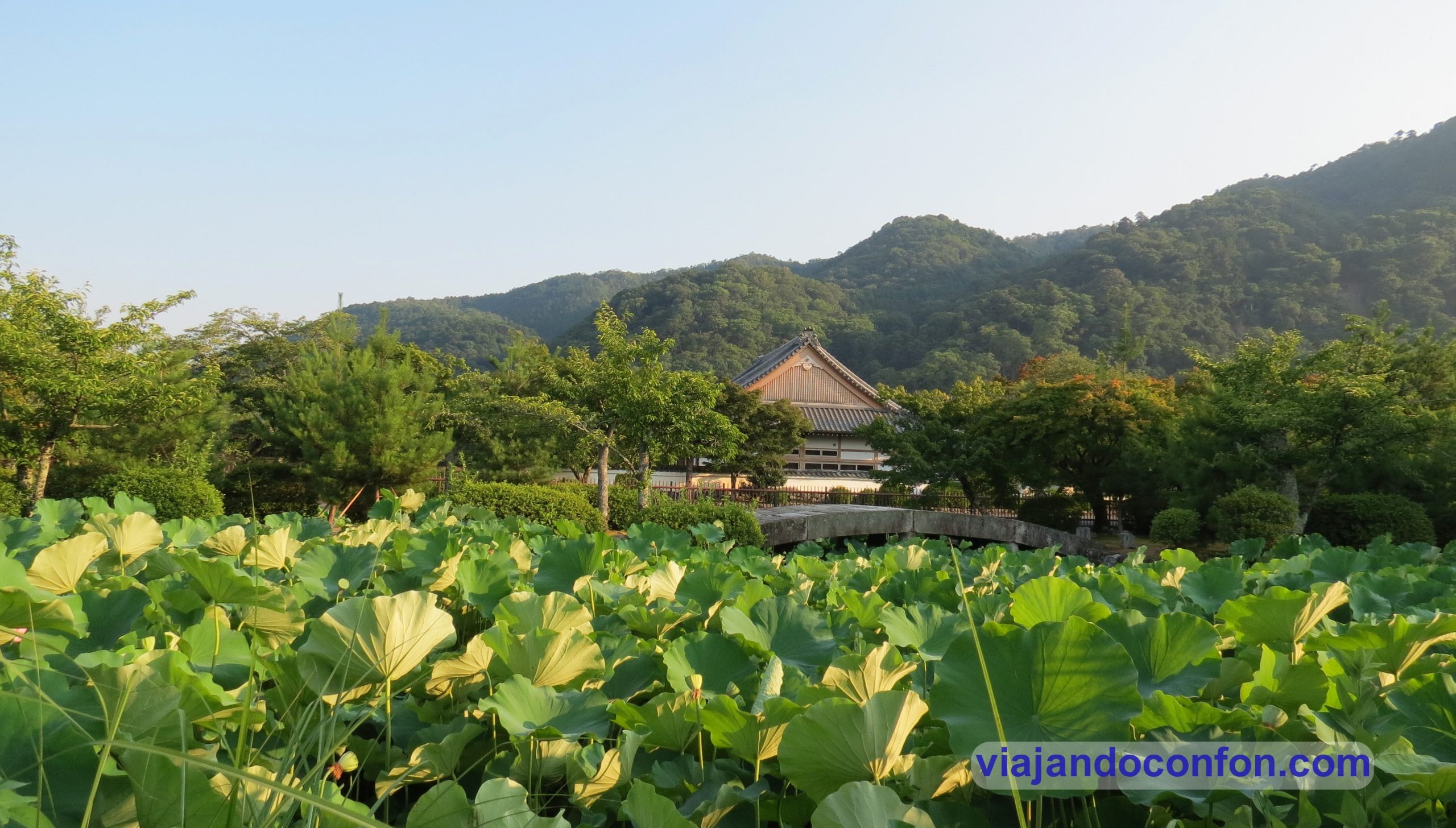
After the visit we took the train back. We went up to the roof of Kyoto station, which has truly spectacular views.

It was starting to be dinner time so we took a bus to Pontocho. There we ate some noodles in a place that we discovered in 2016. A place that, despite being in the heart of tourism, is very cheap and quite shabby and we discovered it because there were only workers eating inside. I couldn’t say the name since the sign is in Japanese and it’s not on google maps. On maps you can locate it because it is next to a bar called “moon walk Shijo Kiyamachi”. Here I leave a photo of the restaurant entrance.


The place is very small, barely 7 or 8 people can fit in, but it is worth waiting a bit because they are delicious.
After filling our stomachs, we took a walk through Pontocho and Gion and took the opportunity to see the Yasaka Sanctuary at night, which is spectacular. From there to the accommodation taking a walk to go to bed early because the next day we had to get up early and a hard day awaited us.
Along the way we discovered a large supermarket called Fresco. It was very cheap and open 24 hours. As it was very late, I already had many discounted products. We took the opportunity to buy breakfast for the next day, several sweets that were greatly reduced because they expired the next day.


July 20th
Today is hiking. We do the route that connects the villages of Kibune with Kurama, in the mountains of northern Kyoto.
We got up very early and went to the Kiyomizu-Gojō station, which is the closest to the accommodation. There we took the private Keihan Main Line to Demachiyanagi station where we changed to the Eizan Main Line (also private) to Kibuneguchi station. In total about 45 min of travel and 700 yen (€5.63). As good foreigners, we are wrong about the price. As soon as we got off at the station, a company employee asked us for our ticket and sent another man to pay the difference. As it was basically a halt, there was no price adjustment machine like in other stations.
From the station we took a walk (you can get there by bus) to the Kifune-jinja Shrine (貴船神社). It’s about 2 km but the walk through the forest is very pleasant and at that time it wasn’t (yet) too hot, although it wasn’t too good vibes to see signs warning of bears along the way.

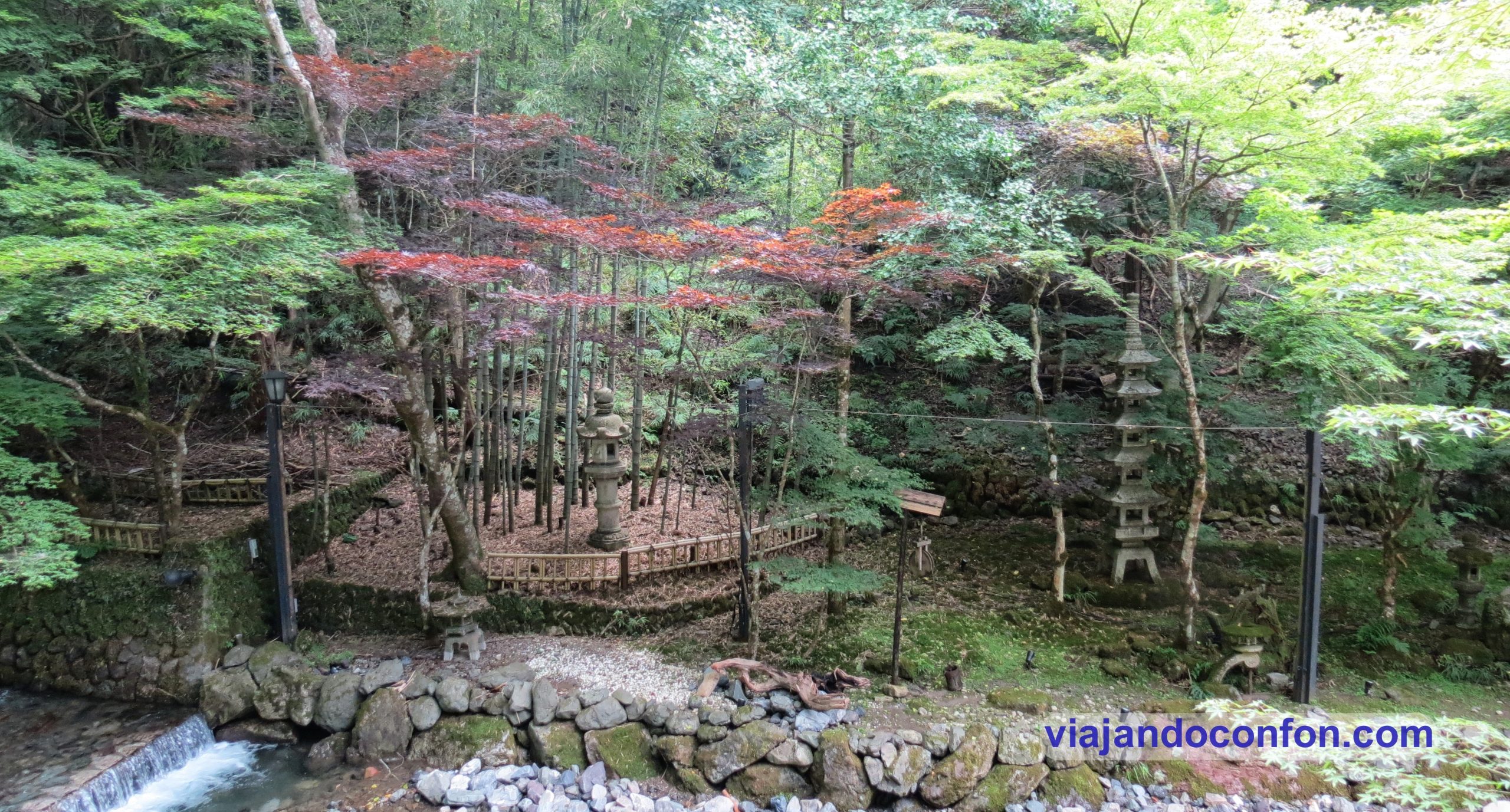
The Kifune-jinja Shrine (貴船神社), founded in the year 1055 and is dedicated to Takaokami no Kami, god of water.
In summer, in the surroundings of the temple along the river, numerous restaurants are installed on its shore. We couldn’t take advantage of them because it was too early to eat.
The temple is nestled in a truly spectacular wooded environment and it is 100% recommended to visit it, in addition, admission is free. There we bought some omikuji or fortune papers that became visible with the water, you had to put the paper on the water of the stream that passed through the temple and the message appeared in Japanese, but, very modern, it had a QR code on it. the one who gave you the English translation.


After visiting the shrine, we set off towards Kurama. To do it we have to go to the red bridge and when we cross it we find the Nishi no mon (西の門) entrance gate, where you have to pay 300 yen (€2.41) to enter the route.
From there begins a good set of stairs through the lush forest, which becomes hard with the heat and humidity but is spectacular.
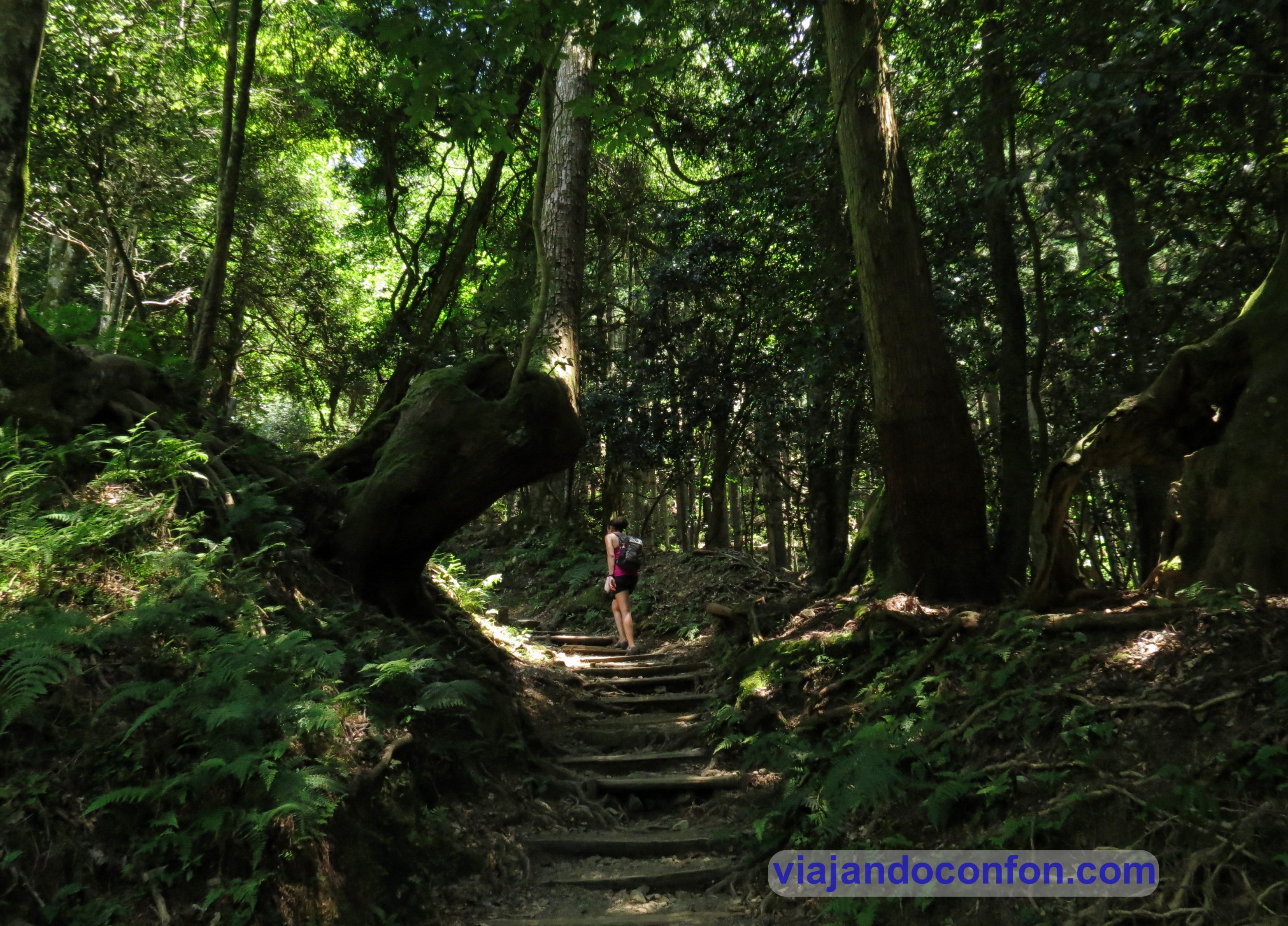
After a long time climbing the stairs, we arrive at a landing where the Oku-no-in Mao-den (奥の院魔王殿) temple is located. There are some benches where we sit down to rest a bit. While they were sitting down I took out a small fan that connects to the mobile and on the next bench there were two gentlemen (quite old) who began to laugh at me. And it only occurs to me to tell them in Spanish: “what you have is envy.” I think they imagined what I told them because the four of us began to laugh out loud.

We continue up a bit more and arrive at the small temple Sōjō-ga-dani Fudō-dō (僧正ガ谷不動堂) dedicated to Fudo, one of the Buddhist gods of light. There we rest a little bit to continue climbing a little more.
We pass through the famous walk of the cedar roots (Kinone-michi (木の根道)) and begin the descent passing through the Jizo-do temple (地蔵堂), with beautiful views, and the natural water source Ushiwakamaru no chikaramizu (牛 若丸の力水) which was very fresh. And leaving behind some warnings to watch out for bears, snakes and giant hornets.


Going down a little more, we arrive at the Kurama-dera Temple (鞍馬寺), the main visit on the route. The temple was founded by one of the disciples of the Chinese monk Ganjin. During the Heian period it was a very popular temple. It belonged to Tendai Buddhism for a long time, but in 1949 it was established as an independent temple of the Kurama Buddhist school.
The visit must be taken with time because the temple is beautiful and has spectacular views of the surrounding mountains. From its viewpoint you can see the wooded sea that surrounds the temple.
There we made a good stop on the way. We bought some cookies and soft drinks and rested taking advantage of the haven of peace that was the complex (at least that day).
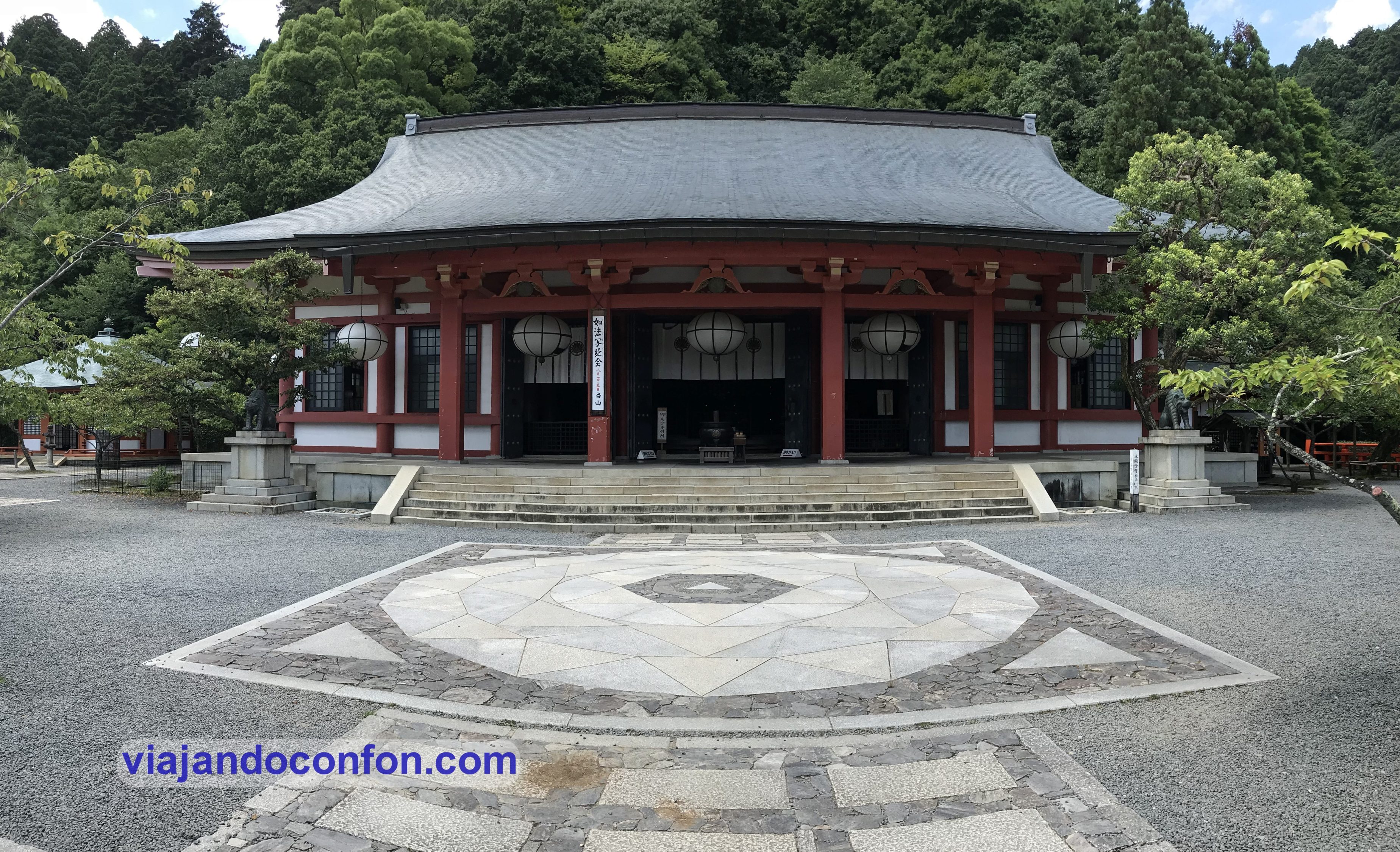

We continued descending calmly towards Kurama although already a little lighter since it was almost 4 in the afternoon and my stomach was beginning to complain.
We arrived at Kurama and we found a big problem: the few places to eat were closed and there were no combins or anything. And now that? Well, hold on until you get to Kyoto, because before you had a bath in the open-air onsen of Kurama.

To get to the onsen you can walk about 15 minutes, or take a free shuttle bus from the train station parking lot that runs every 10 minutes. We chose the second option since with the heat and an empty stomach things were complicated.
In the Onsen you can use the entire bath for 2,500 yen (€20.11) or just the outdoor bath (rotenburo) for 1,000 yen (€8). If you stay at the ryokan, admission is free. We choose the rotenburo.
Before entering there is a booth where you pay 1,000 yen (€8). Right there you can take some towels so there is no need to carry them from home. The small face towels are 300 yen (€2.41) and you can keep them, and the big ones are 400 yen (€3.20) and those are rented, you have to return them.
The bathrooms are spectacular. In the middle of the forest with stunning views of the surrounding forest. In winter with the snow it has to be a real blast. The only “downside” is that it is very touristy and there were too many western tourists (like us hahaha).
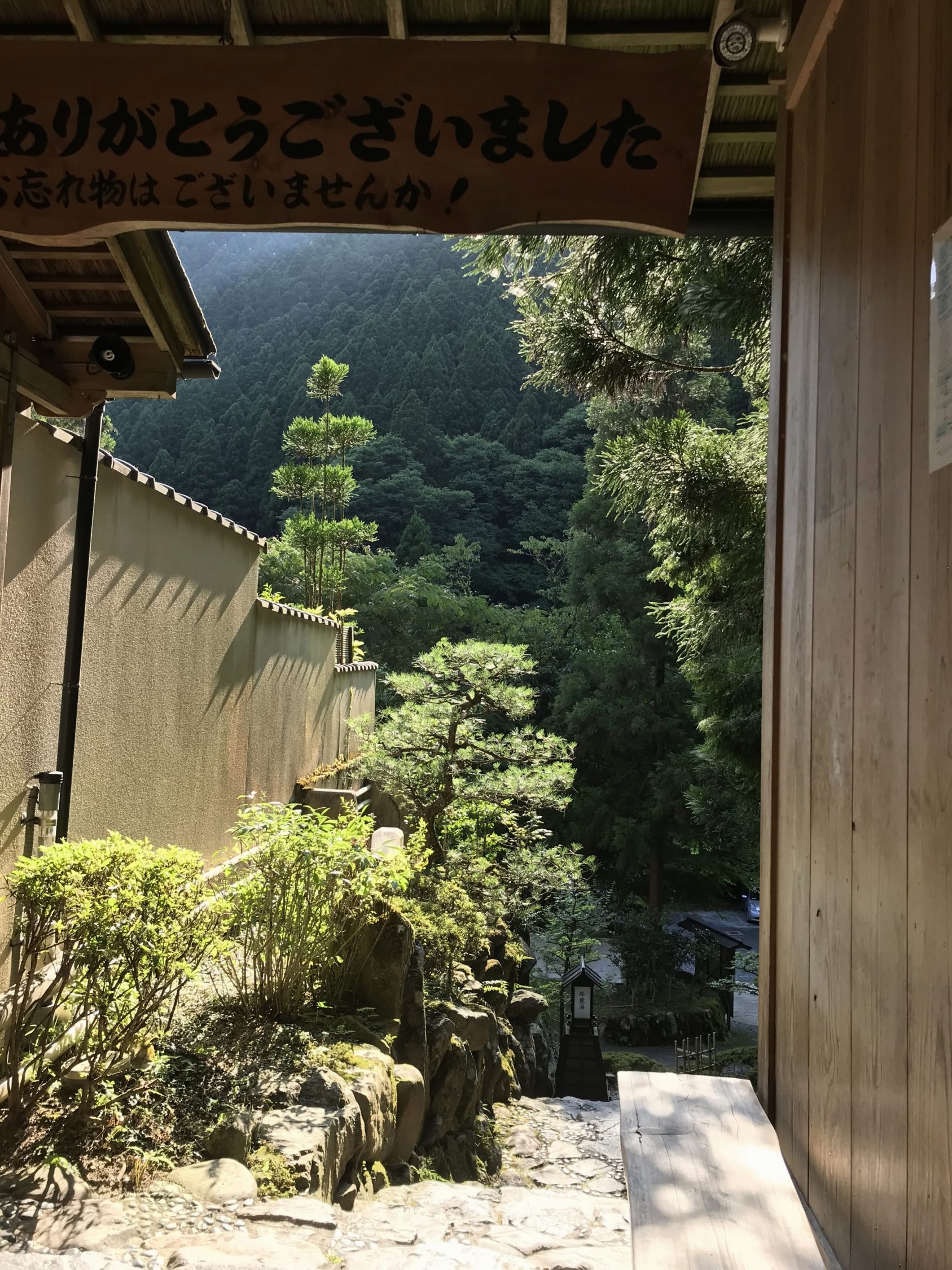
About an hour and a half later we decided to go back to Kyoto for an early dinner that we still hadn’t eaten.
A little shower and a walk along Shijo-dori street and through its shotengai and a dinner based on grilled eel in a Sukiya. And soon to bed you had to get up early again.
July 21st
Today we played a destination that we already visited in 2016 but that we lacked things to see. It’s so impressive that you had to go back: Miyajima.
It is an island south of Hiroshima in the Seto Inland Sea. Known for its impressive floating Torii at Itsukushima Shrine.
If you have little time to visit the island and you don’t want to sleep there, you can always hire a guided excursion from Hiroshima:
We got up very early and took the shinkansen at 8 in the morning. At 9:56 we arrived in Hiroshima and changed to the Sanyo line (via Iwakuni) which left at 10:15 and arrived at Miyajimaguchi station at 10:43. We passed a combini on the way to the ferry and got on the JR ferry (included in the JR Pass) at 10:55. At certain times of the day, the outward journey of the ferry is lengthened a bit and passes by the great Torii to be able to admire and photograph it.
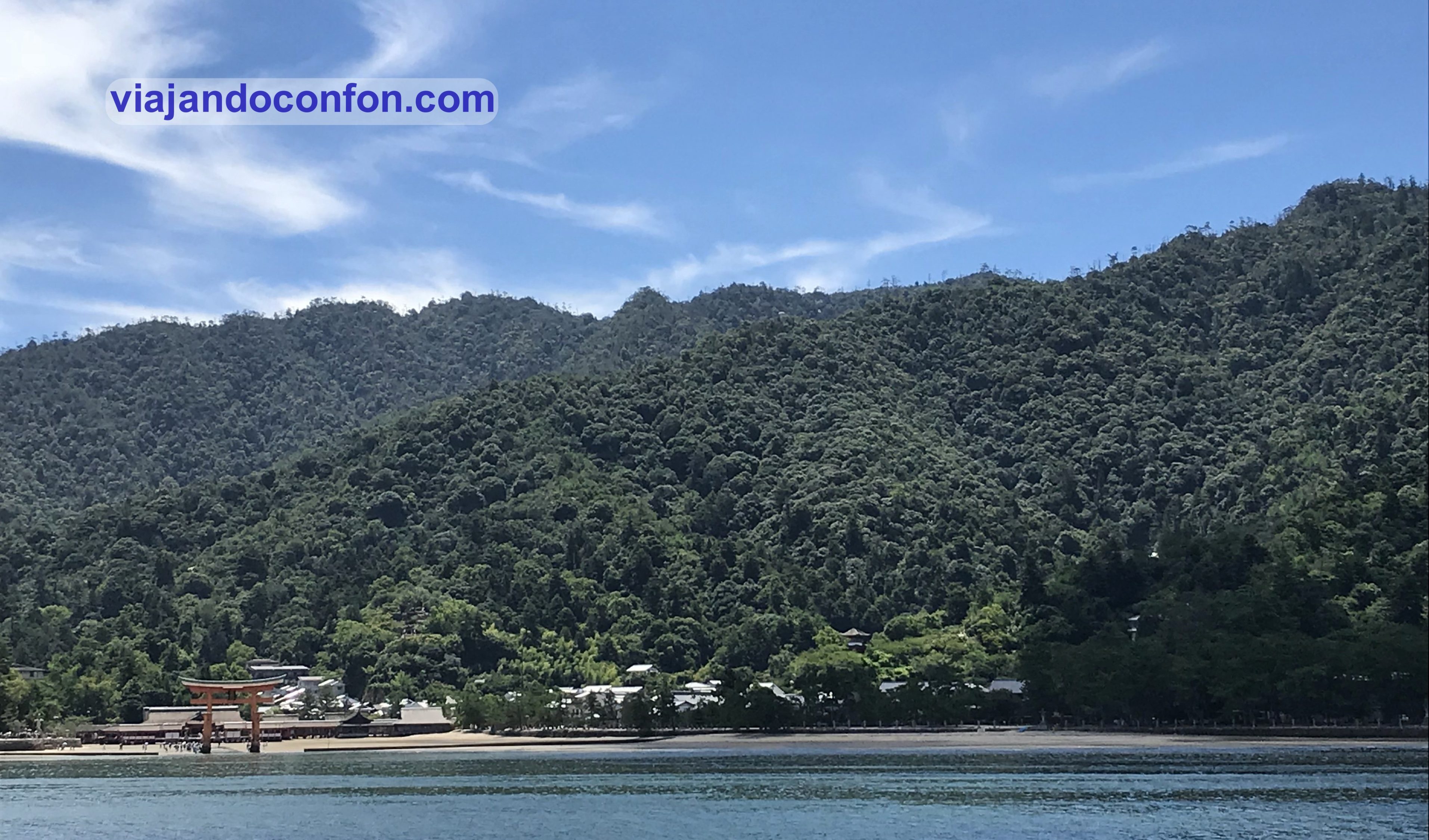
As we got off the ferry we went directly to the ryokan where we were going to sleep that night. The chosen one was the Sakuraya hotel, very close to the ferry station. Very comfortable and with a very simple onsen but, like all, it is a great pleasure.
We left our things and ran towards the Daishō-in temple (大聖院). One of the most important temples of the Shingon Buddhist sect. The temple area is very large and with many stairs, but you can walk very well under the shade of the trees, visiting the different buildings. I would say that it is a must visit in Miyajima.


After visiting the temple, it was time for the main visit for which we had returned to Miyajima two years later: climbing Mount Misen.
We headed for the cable car but, instead of going through the town, we went through the Momijidani park enjoying the scenery. The price of the cable car is 1,000 yen (€8) one way and 1,800 yen (€14.40) round trip.
Already along the way we anticipated that the excursion was going to be surprising. We first got on a tiny four-seater cable car in which only the two of us were going. The views from this first cable car were truly wonderful, through the lush forest of the island.
Halfway there we changed to a larger cable car and in which we were going at least 10 people from which part of the Seto Inland Sea could be seen and they were giving information in Japanese through a loudspeaker. A real past.
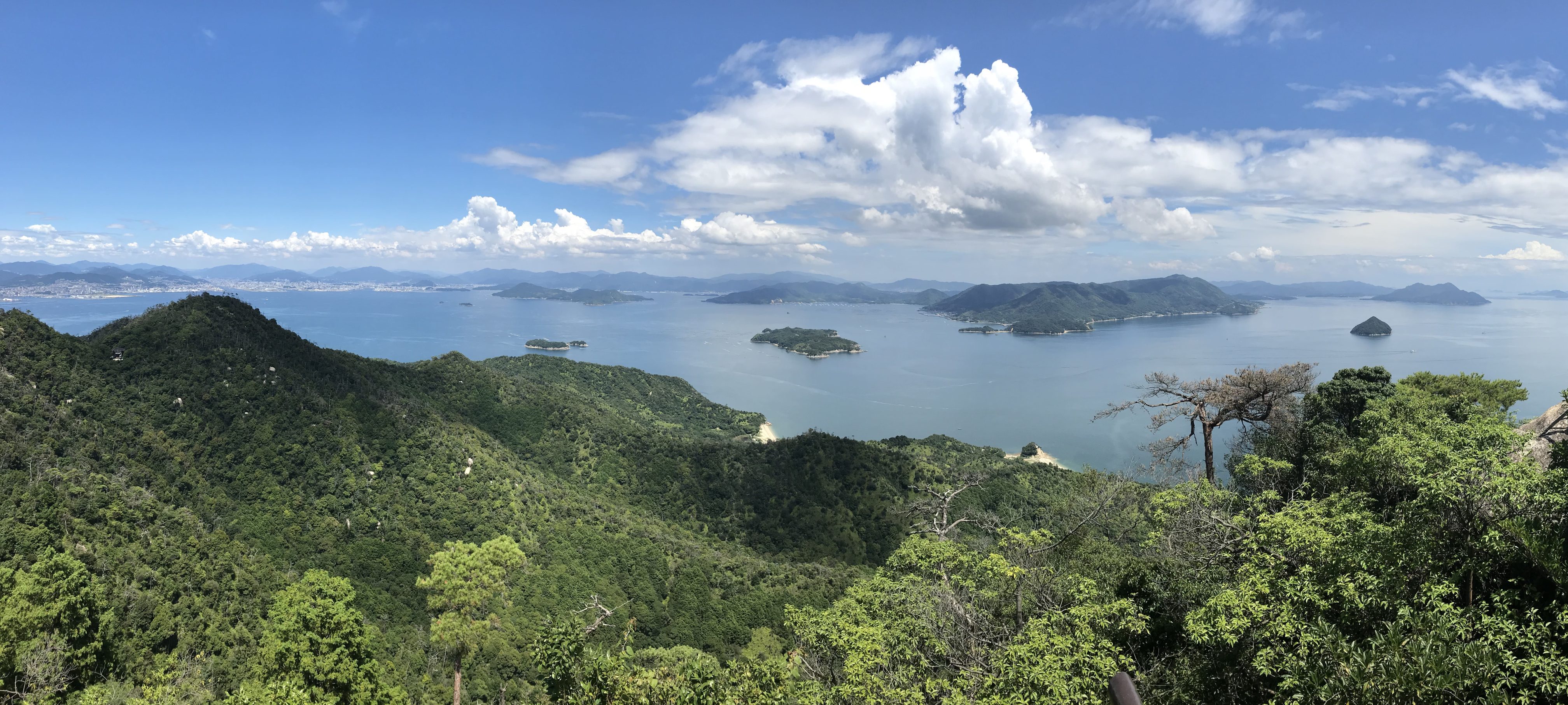
The cable car leaves us at an information center where there are drink machines (of course) and a restaurant (not expensive) with incredible views.
Outside the center, there are several viewpoints to admire the very very cool views of the Seto Sea.
From here, we begin the climb on foot to the top of Mount Misen. The path is almost all a path with quite irregular steps but relatively simple and very beautiful. On google it says that it takes about 20 minutes but, I don’t know if because of the heat, it took us about an hour.
On the way we pass by the Misen Hondo Hall, where Kobo Daishi, founder of the Shingon Buddhist sect, stayed for 100 days to meditate. During those days, through an ascetic ceremony, he lit a fire by burning goma-gi. That flame lives on to this day 1,200 years later in the Reikado hall. With that same flame the flame of peace in Hiroshima was lit.
The hall is also known as the sanctuary of lovers because of the eternal flame that symbolizes eternal love.
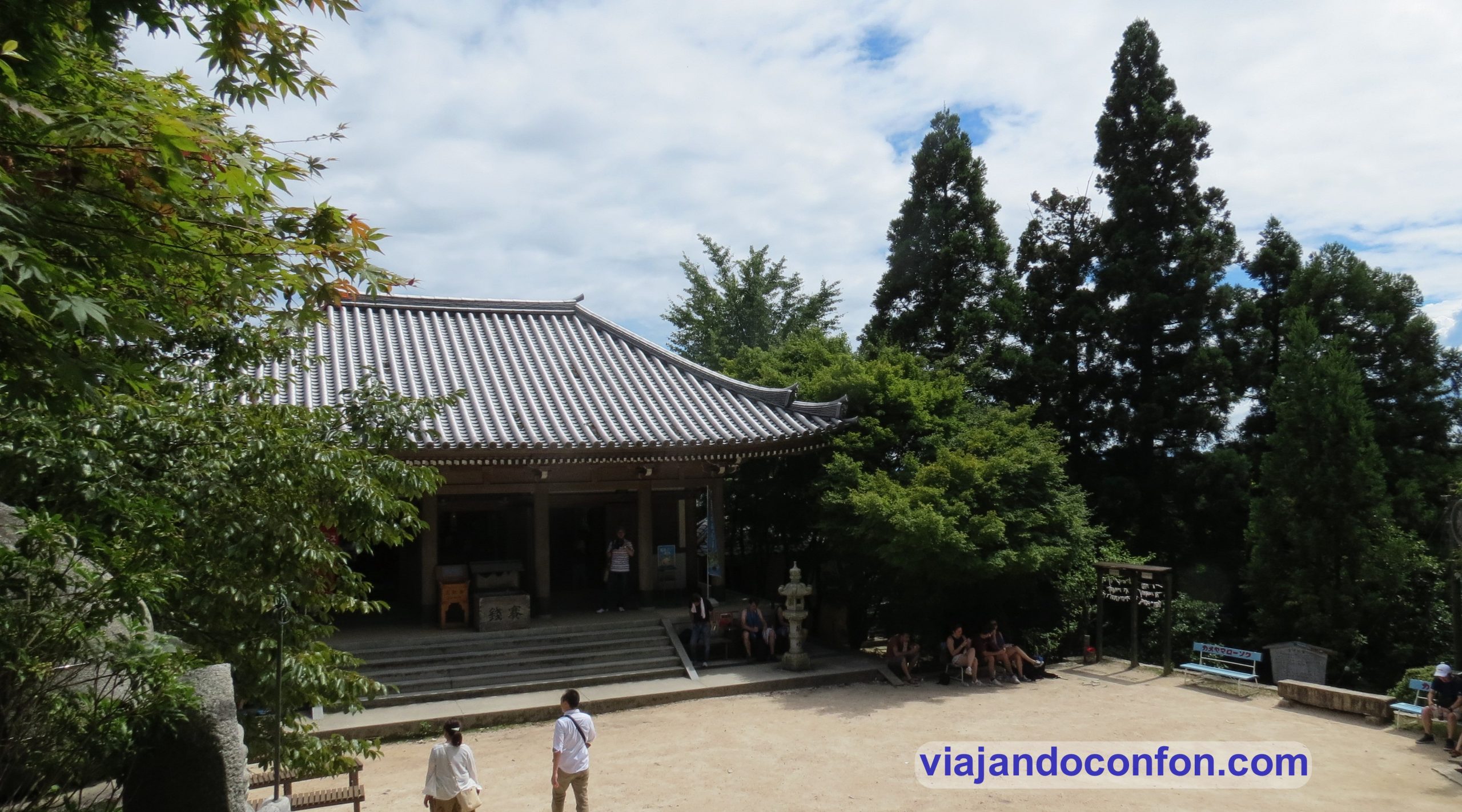
After a little rest in the shade and a bottle of cold water, we continue up to the top passing through the Sankido hall, dedicated to three ogres with wisdom, fortune and exorcism; but also to home security and business prosperity.
On the way we pass through the Kannondo and Monjudo halls. The first to promote easy childbirth and the second to succeed in studies.
A little further up we pass the Fudo-iwa rock, where there is a statue of Fudo Myoo, protector of the Shingon Buddhist sect, and the Kuguri-iwa rock, which forms an arch through which you have to go through to continue the path.

A little further up we finally reached the top of the mountain. There is a viewpoint from which there are truly spectacular 360º views. You can see the Seto Inland Sea, the coast of Honsu and even the city of Hiroshima. In addition, in the viewpoint there are bathrooms, wifi and a small information desk. It was really worth going up.


We rested for a while in the viewpoint to the shade and we got ready to go down. For this we decided to do the whole tour on foot. Despite being down, it is quite hard, since there are about 3 kilometers in which almost all the time is going down stairs. We ended up with busted knees. But the trail is wonderful, you come across a temple and some charming little corners with a bench so you can rest admiring the views.

Throughout the trail, as in other hiking trails we had done in Japan, there were signs warning that there were poisonous snakes, deadly poisonous Mamushi vipers. Rigorous photo and walk. It’s all laughter and joy until you come across one and shit yourself, and instead of standing still and waiting for it to happen as they tell you, you jump up and run.
With the scare in the body you keep going down. When you start to calm down after a while PAM! Other. On this occasion, already psyched up, if we stay still to wait for him to leave. So as advice, pay attention and be careful.

Approximately after an hour and a half we reach the town. It was almost 4 in the afternoon and we still hadn’t eaten. It was difficult to find an open place to eat at that time but after trying several restaurants, we finally managed to eat a katsudon and a tonkatsu chicken.
After eating we checked in at the ryokan and took our first relaxing bath in the onsen. Very quiet since at that time it was empty.
After the bath we went for a walk and to watch the sunset with the great Torii. This time we coincided with high tide, unlike when we were in 2016.
It is a truly spectacular sunset. It is said that it is one of the most beautiful in the world and, for the moment, it is the most beautiful that I have seen.

After dark, we took the ferry to buy some dinner in a combini next to the station and on the way we went back.
We ate quietly and went for a night walk. At night the town breathes absolute tranquility. Without cars and only with some tourists who spent the night on the island like us. What a pity that the night ended because it was a magical walk, but you had to get up early. After the night walk, a last bath in the onsen of the ryokan, and to rest.


Find the best activities and tours in Miyajima with Civitatis:
July 22nd
It was time to get up early again. We took the 8.40 ferry and at 9.09 the JR Sanyo line to Hiroshima. There we changed to the shinkansen at 9.54. It was going to burst and we had to sit separately in different carriages, but since the destination was Okayama 40 minutes away, it wasn’t much of a problem either.
At 10:34 we arrived in Okayama. We left our bags in a locker at the station that cost us 700 yen (€5.60) and we got on the tram to the crow, the black castle of Okayama (岡山城). Then we found out that we could have saved a few yen and walked since it was so close.
We got off the tram and took a nice walk along the banks of the Asahi River to the castle complex.
Okayama Castle, called the crow because of the black color of the building, was built in 1597 by order of Toyotomi Hideyoshi. Over the years it deteriorated and some of its 35 towers fell due to lack of maintenance.
During the bombings of the Second World War, almost everything that was left standing burned. Of the original building, only the foundations, parts of the wall and the observation tower of the moon remain. The main tower that can be visited today was rebuilt in 1966.

After visiting the castle, we went back (this time on foot) to the train station. We got on the shinkansen at 12:35. We reached shin-Osaka 49 minutes later and went directly to the hotel. It was difficult for us to find it since the wrong address came in booking and without data on the mobile … After about half an hour walking around we found it. It is the APA Hotel Higashi Umeda Minami Morimachi Ekimae. Recently inaugurated and, in addition, with breakfast included. Like almost all the hotels in which we have stayed in Japan on the two trips, the room is small but very clean and even elegant.
We left our things and rested a bit while I searched the internet for a place to eat. The chosen one was a small okonomiyaki restaurant called Yukari tensan in a shotengai near the hotel. As soon as you enter, you have to take off your shoes and leave your shoes at the entrance. The okonomiyaki was really spectacular, it was quite a discovery. The meal cost us 2,420 yen (€19.38) for two okonomiyakis and a beer.
After eating we walked through the shotengai towards the Osaka Tenman-gu Shrine (大阪天満宮) shrine. A famous (and touristy) Shinto shrine dedicated to Sugawara Michizane built in 1845. We coincided with the Tenjin festival, one of the most famous in Japan that is celebrated from the end of June to July 25. In fact, we were able to see a small female “procession” carrying a small throne through the shotengai the next day.

We took a short walk around the shrine and took the subway to Ebisuchō station for a night walk through the Shinsekai (新世界) neighborhood. Osaka’s entertainment district par excellence, with the Tsutenkaku tower (通天閣) as its flag, with its 103 meters is one of the symbols of the city.
The Tsutenkaku Tower (通天閣), was built in 1912 as part of an amusement park. In 1943 a serious fire left it badly damaged and it was dismantled and rebuilt in 1956 by the Hitachi company.

After World War II, Shinsekai gradually deteriorated to become the most dangerous and poorest area in all of Japan. It seems that it is still considered dangerous but we did not think so, at least the area of the tower and the restaurants. It is very curious to walk through its lively streets full of restaurants with impressive ornate facades to attract the attention of passers-by.

After an exhausting walk among so many people, we decided to go to the Dotonbori area for a night walk in the area and have dinner at a restaurant that we had booked online.
We had dinner at a small teppanyaki restaurant that serves Kobe beef. It’s called Wanomiya and I can’t say the price since it was a birthday gift they gave me. We took two menus and the meat was to cry. What a delicious thing. The cook was giving us advice on how to eat it, it was spectacular even the vegetables. Will have to go back.

After dinner we took another little walk around Dotonbori and went back to sleep.
Find the best things to do in Osaka with Civitatis:
*It helps us to maintain the blog
July 23rd
Today is excursion. We got up very early and as we had breakfast included in the hotel, we took a good look at the buffet and left for the station.
At 8.25 we got on the train to Shin-Osaka and there we changed to the shinkansen at 8.39 to Himeji, where we arrived at 9.15 in the morning. At the station there was a small exhibition about the Nada No Kenka Matsuri (held in October). In it you can see some photographs and one of the thrones that they take out during the festival.

We left the station and walked along the avenue that leads to Himeji Castle (姫路城). It is a small walk of 1 km. and it can be done quietly on foot.

Himeji Castle (姫路城), was the first place in all of Japan to be inscribed as a World Heritage Site. It is one of the 12 original castles that remain in Japan and is one of the most spectacular in the country. It is worth dedicating a morning to explore it.

After spending the morning visiting Himeji castle we went back to Osaka to take the train to Kii-Katsuura.
That day the heat was really unbearable, waiting for the train to Kii-Katsuura we were on the verge of collapse, infernal heat on the platform and the station hall had no air conditioning. Later, when we hooked up Wi-Fi, whatsapp messages began to arrive from Spain that if we were okay, that they had seen that we were in Japan in the middle of a heat wave and that on that particular day, the highest temperatures in the history of Japan had been recorded, and it was in Osaka as well. It really was hell. To make matters worse, the train that had to leave at 5:23 p.m. was almost half an hour late.
The train finally arrived and, what a thing, it was a panda bear! The train was almost empty and air conditioned. As soon as we get on and before sitting down, to change our clothes and clean up a bit to travel as comfortable as possible. We had 4 hours of rest in the cool until our destination. Although we were somewhat worried when we saw the instructions on what to do in the event of a tsunami in the seat pocket. Of course, explained by a panda bear.


Around 9:30 p.m. we arrived at Kii-Katsuura. It is a small coastal town, which is the tuna mecca in Japan and, in addition, it is one of the gateways to the Kumano Kodo route, the most important pilgrimage route in Japan. Although the Kumano Kodo is really a network of roads through Japan of about 1,200 km.
As soon as we left the small station we went to the hotel. It’s the Charmant Hotel, a small independent hotel run by a fairly elderly lady who was really lovely. Despite only speaking Japanese, she managed to explain everything to us about the Kumano Kodo route. Where to catch the bus and the line, where to get off, what to visit, where to catch the bus back… She also recommended where to eat the next day. In the fridge she leaves you some juices and water for free and some sweets. In addition, in the afternoon he invites you to a sweet bean soup very typical of the area.
We left our things in the room and went to a nearby familymart to buy some dinner, since everything was closed in the town at that time. The truth is that it seemed like a ghost town and it was not 10 at night.
On the way back, have dinner and go to sleep, it was going to be a hard day.
Find the best activities and tours in Japan with Civitatis:
Today we are going to talk a little more in depth about Mount Nokogiri (鋸山), a beautiful excursion from Tokyo. I think it’s the one I liked the most (so far). His thing is to get up early and go early since the road is long and slow to get there.
Nokogiriyama (鋸山) is a 330-meter mountain on the western coast of the Bōsō Peninsula in southern Chiba Prefecture. Its name means mountain range. It faces the Uraga Channel, the waterway that connects Tokyo Bay and Sagami Gulf. The distinctive features of Mount Nokogiri are its sawtooth-shaped ridges (hence its name). These were created by the extraction of building stone during the Edo period.
Stretching along the slopes of the mountain is Nihonji Temple (日本寺), a Sōtō Zen Buddhist temple (曹洞宗). It was built in the year 725, which makes it one of the oldest temples in the Kantō region.
The temple complex is extensive and consists of multiple areas. A network of walking trails connects the areas that will take us a whole morning to explore and enjoy.
Here we leave you a map taken from the official website of the Nihonji Temple (in Japanese): http://www.nihonji.jp/

Nihonji Temple (日本寺)
It was inaugurated on June 8, 725 by Emperor Shōmu Tennō and the priest Bosatsu Gyōki (行基). He first belonged to the Hosso sect, then to the Tendai sect, and then to the Shingon sect. It became the Sōtō Zen sect during the reign of the third shōgun Tokugawa Iemitsu when it became a center of Zen practice.
In the Kantō region, Nihon-ji is the only Nara Period temple built by imperial decree (such temples were known as chokugansho (勅願所)). Some ancient documents say that the emperor donated 18 tons of gold to the temple. An imperial tablet written by the emperor himself and a scroll depicting 33 Buddha images personally embroidered by Empress Kōmyō.
According to the historical stone monuments that still exist today, the temple consisted of seven shrines, twelve monastic buildings and one hundred lodges for priests.
The temple’s fame reached its peak in the Edo period (1603-1868), especially under the rule of the third shōgun, Tokugawa Iemitsu. It was in 1774 that Guden (愚伝), the head priest of Nihon-ji, expanded the temple and made Nokogiriyama into a sacred mountain. The Nihon-ji Daibutsu and the 1,500 arhats were added to the southern slope in the same period. The temple suffered considerably in the aftermath of the Meiji Restoration, when the haibutsu kishaku (廃仏毀釈), an anti-Buddhist movement, resulted in extensive destruction of temple property. Many of the arhats were beheaded, but later restored.

The main deity of the temple is Yakushi Ruriko Nyorai (Medicine Buddha). Originally revered solely by ruling sovereigns and judicial elites for his own personal benefits (to cure life-threatening diseases), Yakushi would later become the central deity in 8th-century rites to ensure the well-being of the entire kingdom. In the early 9th century, the deity was also called upon to appease vengeful spirits that cause calamities. The main feature is that he has a medicine bottle in his left hand.
Yakushi Ruriko Nyorai is said to heal war wounds, so numerous military commanders have visited this temple. After losing the Battle of Mount Ishibashi, Minamoto no Yoritomo prayed for luck at Nihonji Temple.
Immediately after the start of the Kamakura Shogunate, Minamoto no Yoritomo set about demolishing all Japanese temples that were in disrepair, and rebuilt the Yakushi Honden in the first year of Yowa (1181). Nihonji Temple, which was completely renovated by Yoritomo, would be devastated again due to the continuous fire of the second half of the Kamakura Shogunate, but Takashi Ashikaga will rebuild it again in the 14th century. It was also rebuilt again in the 16th century by the Satomi clan, the local warlords of Awa Province.
Visiting Mount Nokogiri
The most common and popular entrance is the one that is made through the cable car located in the city of Kanaya.
It is convenient to bring water since we will only find water in the vending machines that are next to the Big Buddha and next to the cable car exit.
The only public baths are also very close to the Big Buddha.
The entrance fee (2020) is ¥600 for adults and ¥400 for children.
Summit Area (山頂エリア)
We entered from the cable car station, where there are vending machines for drinks and a small restaurant.
From this point we have spectacular views of the area surrounding Kanaya and of Hota.


From here starts the path that leads to the door where we pay our entrance and they give us a map and an informative brochure.

We climbed about a million steps and arrived at the spectacular and gigantic 30-meter sculpture of Hyaku-Shaku Kannon (百尺観音). Although it looks like it has been here for centuries, it was carved between 1960 and 1966 to commemorate the victims of World War II and traffic accidents. He is revered as a deity to protect the safety of nautical, air, and land transportation.


After climbing about another million steps in the tremendously humid July heat, we arrived at the Jigoku Nozoki (地獄のぞき) viewing area, the “View of Hell”. The most famous and spectacular viewpoint in Nokogiriyama, it offers stunning views of the Bōsō Peninsula and the Uraga Channel. Across the bay, you can see the Miura Peninsula and, on clear days, Mount Fuji. It consists of a small ledge on the mountain from which there are truly spectacular views while you seem to be suspended in the air. You have to queue to gain access since, from the front, you can take some very cool photos at the viewpoint.



Rakan Area (羅漢エリア)
After taking the obligatory photos we began the descent. We do it along the main path, the path of the 1,500 arhats (千五百羅漢).


In Buddhism, an arhat is someone who has gained a deep understanding of the true nature of existence, who has reached nirvana and therefore will not reincarnate.

Like Arhats in other parts of Asia, they resemble Li Guangxiu’s brilliant set of figures at the Bamboo Temple outside Kunming in China: each facial expression is different, from the beatific to the Tradition holds that if you start Counting your own age from a certain figure, you will arrive at the Arhat that most resembles your own character and your inner being. You may not like what you find.

Well, on the slope of the mountain there are stone images of 1,500 Tokai Arhats, made by the artist Jingorō Eirei Ōno and his 27 students during 19 years (between 1779 and 1798), carved in a special stone brought from the Izu peninsula. . These Tokai Arhats are found in small natural caves and on carved rocks. Unfortunately, many were destroyed during an Anti-Buddhist Movement in the Meiji period, between 1868 and 1873, reducing their number to 538. That is why sometimes only parts of the statues remain. Many of them have recently been restored.


The way down is truly incredible, with the sculptures in the spectacular wooded setting of the mountain, making you forget the tremendous summer heat.

Explanada del Gran Buda de Nokogiri (大仏広場)
Halfway up the mountain we find the jewel of the temple: the statue of the Great Buddha of Nokogiri or Nihon-ji Daibutsu (日本寺大仏).

It was originally carved out of the same rock it stood on in 1783 (third year of Tenmei) by Jingorō Eirei Ōno and his 27 students and measured 37 meters. At the end of the Edo Period (1603 – 1868), due to erosion by wind and rain, it collapsed. The sculpture that we see today dates from 1969 and measures 31 meters, 7 less than the original.
It rises from a semicircular base, in the shape of overlapping lotus buds, to a stone halo resembling a disk and with “little” Buddhas surrounding Yakushi Ruriko Nyorai.
The sculpture is spectacular and leaves you speechless. On the esplanade there is a kind of shaded picnic area where you can rest in the shade and have a cool drink from one of the vending machines that are here.
Find your ideal hotel at the best price in Japan with Agoda:
*It helps us to maintain the blog
Middle Zone (中腹エリア)
After a well-deserved rest, we begin the descent again, passing through several temple buildings, such as the Yakushi Honden (薬師本殿医王殿), destroyed by the great fire of 1944 and rebuilt in 1997.



Omotesando Area (表参道エリア)
Already in the lower part, we can find the Shinji-ike pond (心字池) and some more buildings such as the Kannondou (観音堂).



Here the route of Mount Nokogiri ends, about two hours approximately. An excursion that will not leave you indifferent.
To return to Tokyo, the most practical thing is to take the train from the JR Hota station, which is about a 20-minute walk between crops from the entrance to the complex of the mount, to the JR Hama-Kanaya station and there return to take the boat towards Kurihama.
How to get to Mount Nokogiri
To get to Mount Nokogiri from central Tokyo, it is best to go to Shinagawa Station (品川駅).
From Shinagawa, if you have JRPass, it is best to take the JR Yokosuka Line via Kurihama, to JR Kurihama Station which takes 1 hour and 20 minutes. Without JRPass, the price is ¥940.
*It helps us to maintain the blog
If you don’t have a JRPass, it’s best to take the private Keikyu Main Line, which a little further on, at Horinouchi station, becomes the Keikyu Kurihama line (you don’t have to get out of the car), also from Shinagawa to the station Keikyu-Kurihama. The journey takes 1 hour and 9 minutes and costs ¥800.
If we go with JR, from Kurihama station we have to walk to Keikyu-Kurihama station, which is just opposite. At the main entrance, we got on the number 7 or number 8 bus to the Tokyo Wan Ferry stop, next to the ferry terminal. The journey takes about 12 minutes and costs ¥200 (€1.55).
The company in charge of the ferries is Tokyo Wan Ferry and its website is: http://www.tokyowanferry.com/
Ticket prices are (2022):
| One Way | Round trip | |
| Adults | ¥900 | ¥1.600 |
| Children* | ¥450 | ¥800 |

The ferry ride takes about 40 minutes and we arrive at Kanaya Port in Chiba.
Mount Nokogiri can be reached via the Nokogiri Cable Car, about a 13-minute walk from the port or 10 from JR Hama-Kanaya Station.
Ticket prices are (2022):
| One Way | Round Trip | |
| Adults | ¥500 | ¥950 |
| Children* | ¥250 | ¥450 |
Hours are from 9:00 a.m. to 4:00 p.m. between November 16 and February 15 (winter) and from 9:00 a.m. to 5:00 p.m. from February 16 to November 15.
It can also be reached by climbing the more than 2,600 steps from Nihon-ji Temple (a 20-minute walk from JR Hota).
For more information you can visit the official website http://www.mt-nokogiri.co.jp/
Find the best activities and tours in Japan with Civitatis:
*It helps us to maintain the blog
Discover everything you need to know about Japan at the following link
In this entry we will find the restaurants in which we have eaten in Japan. More or less recommended in case they guide future visitors.
Remember to always travel with travel insurance. With IATI, specialists in travel insurance, you have a 5% discount for being our reader.
Tokyo
Rokurinsha (六厘舍)
A small (very small) ramen restaurant. It is located on Tokyo Ramen Street in the basement of Tokyo Central Station, just up some stairs. You will recognize it by the permanent tail. The estimated waiting time at that point in the queue is marked on the floor. Trust me it’s worth the wait.
As soon as you enter you have a machine in Japanese (luckily with photos) in which you mark what you want, put in the yen and it takes out a piece of paper that you hand over to a boy and he serves you. On the tables you have a jug of cold water that they change for you.
As a curiosity, if you want they give you a paper bib so you don’t get dirty.

Address: Japan, 〒100-0005 Tokyo, Chiyoda City, Marunouchi, 1 Chome−9−1 東京駅一番街 B1 東京ラーメンストリート内
Hours: every day from 7:30 a.m. to 7:30 p.m.
Website: http://www.rokurinsha.com/
Coco Curry House
It is a chain of Japanese curry restaurants found all over Japan. Here we can eat curry in the traditional Japanese style. It is cheap and rich.
Highly recommended. We ate in Tokyo, Nara and Osaka and they were all equally good.
Website: https://www.ichibanya.co.jp/english/


Karayama Shinbashi (からやま 新橋店)
This is a small restaurant that serves tori no karaage (から揚げ), Japanese fried chicken that is delicious. We discovered it in 2016 and on our 2018 trip we ate there again.
Next to the door you have your machine to make the choice and you give the piece of paper to the boy who attends. It is so small that it only has a bar. The chicken was delicious and very cheap and they put it on a menu with a miso soup, a bowl of rice and shredded cabbage.
Address: Japan, 〒105-0004 Tokyo, Minato City, Shinbashi, 2 Chome−16−1 ニュー新橋ビル 1F.
How to get there: It is located in the southern part of the square in front of Shinbashi station, leaving through the Hibiya exit.
Hours: Every day from 10.30 to 22.30.
Website: http://karayama.com/shinbashi/

Yoshinoya (吉野家)
It is a chain that specializes in gyūdon, a bowl of rice with braised meat cut into very thin strips. It is very cheap and very good, with dishes starting at ¥387 (€2.91).
It was founded nothing more and nothing less than in 1899 and they are all over Japan.
Website: https://www.yoshinoya.com/
Gusto Cafe (ガスト)
It is another chain that we find all over Japan. It is not the cheapest place to eat but it has a lot of variety, from Japanese food to pizzas.
The best thing about this chain is that, paying 200 yen (€1.55) you have an open bar of non-alcoholic drinks. For summer dehydration it is really good.
Website: https://www.skylark.co.jp/gusto/
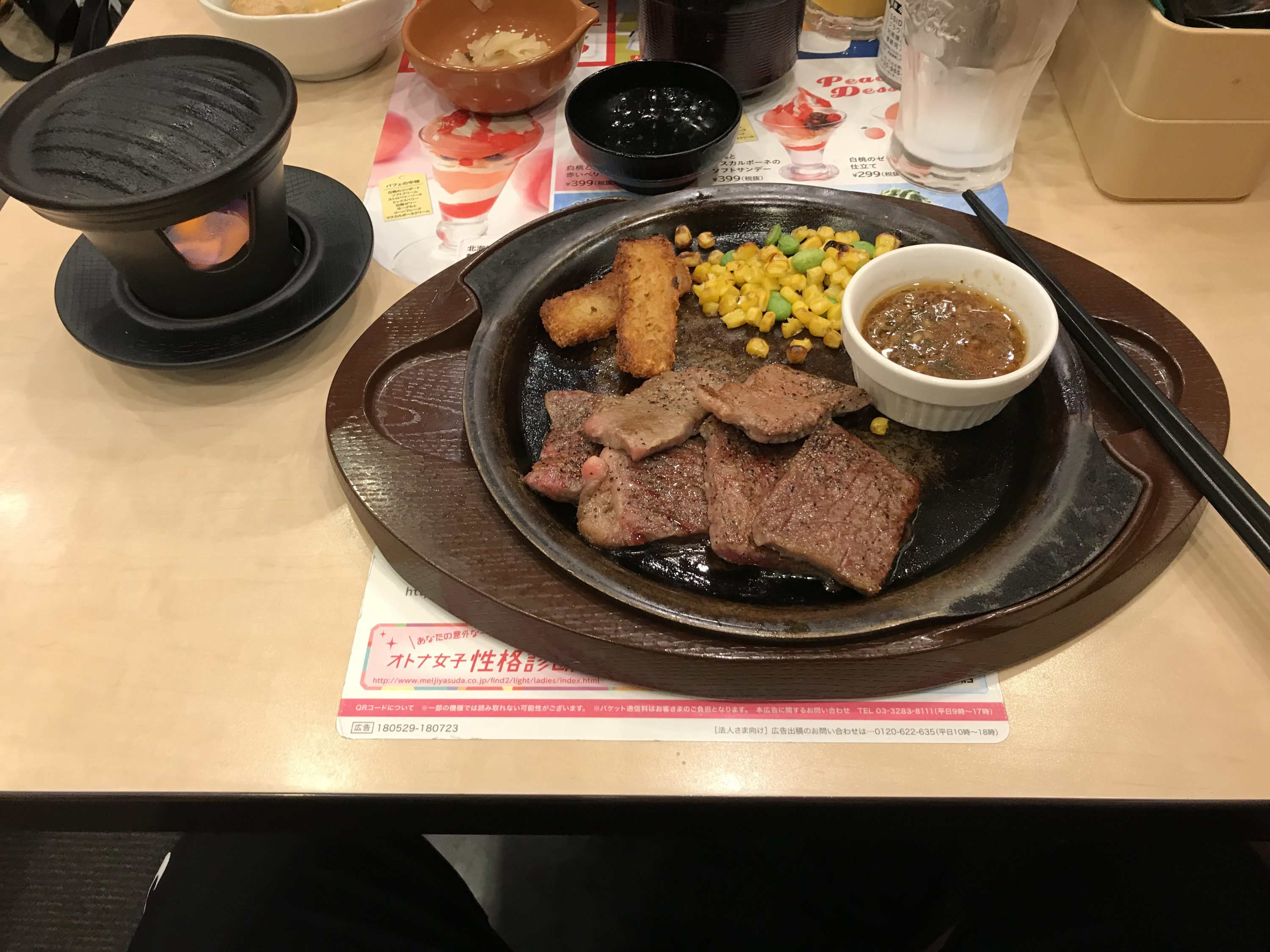

Hidakaya Ramen (日高屋 新宿東口店)
It’s a small ramen restaurant mainly, although it also has something else like rice. Good and cheap in the heart of Shinjuku: 600 yen for the menu (€4.71).
Address: Japan, 〒160-0022 Tokyo, Shinjuku City, Shinjuku, 3 Chome−21−1 清水館ビル.
How to get there: 2-3 minutes walk north from the East exit of JR Shinjuku station, towards Kabukicho.
Hours: Monday to Saturday from 10:00 a.m. to 2:00 p.m. Sunday from 10:00 to 24:00.
Totobee
Permanently closed
A small sushi place near the old Tsukiji market. It is located in a basement and the sushi is delicious and, since it is not touristy, like most of the restaurants around the market, it is quite cheap. Menu only in Japanese but with photos and employees who only speak Japanese.
It is the most delicious sushi I have ever tasted.
Address: since it doesn’t appear on google maps, we can be guided because it is next to a Spanish restaurant called Brochetería Sol Sevilla located at 〒104-0045 Tokyo, Chuo City, Tsukiji, 2 Chome−14−3 天羽ビル.
How to get there: 100 m walk from the northwest of the entrance of Tsukiji Hongwan-ji temple.
Opening hours: I haven’t found the opening hours but I have to say that it closes on Sundays, since I was able to check it the last time I went.



Mos Burger
It is a chain of hamburger restaurants that are all over Japan, McDonald’s type. It is cheap and they are very good although they are a bit small for a Westerner to see.
Website: https://www.mos.jp/
Sukiya
Another chain that we found all over Japan. This time specializing in gyudon and grilled eel, although you can find many more things. The eel is very good and they have quite affordable menus.
Website: https://www.sukiya.jp/en/

Sushi-Ro
It is a sushi chain, the kind that passes the dishes around the tables through a belt. The one in Ueno was highly recommended to us. It is very good and well priced, although, in this place specifically, the wait for a table can go up to an hour. Worth.
Address: Japan, 〒110-0005 Tokyo, Taito City, Ueno, 6 Chome−9−9 オリエンタルビル B1.
How to get there: About a three-minute walk south of JR Ueno Station.
Hours: every day from 11:00 to 19:50.
Website: https://www.akindo-sushiro.co.jp/


Haneda Sushiko (羽田寿司幸)
Sushi restaurant located in Terminal 1 of Haneda Airport (before security checks). It’s very good and, for being in an airport, it’s not expensive.
Address: Japan, 〒144-0041 Tokyo, Ota City, Hanedakuko, 3 Chome−3−2 第1旅客ターミナル ガレリア 3F 羽田空港.
How to get there: it is located on the 3rd floor of terminal 1 of the airport.
Hours: every day from 11:00 a.m. to 8:00 p.m.

Narita
Ton Ton Tei
Tiny tonkatsu restaurant in the city of Narita. A very nice place with spectacular meat and cheap, although somewhat difficult to reach.
Address: 411-1 Tsuchiya, Narita, Chiba 286-0021.
How to get there: We can get there by taking the bus that leads to Aeon Mall Narita that leaves from outside the JR Narita station. We got off next to the door of the shopping center and walked southeast for about 10 minutes. The price of the bus is 210¥ (€1.60).
We can also walk about 10 minutes from the Peace Pagoda of the Narita San Shinso-ji temple, leaving through the back door of the enclosure.
Hours: every day from 11:00 a.m. to 11:00 p.m.

Utsunomiya
It is a chain of gyoza restaurants, the Japanese dumplings, originally from Utsunomiya. It has many varieties. Very cheap and delicious.
Address: 3 Chome-3-3 Ekimae Dori, Utsunomiya, Tochigi 321-0964, Japan.
Hours: every day from 11:00 to 21:30.
Website: https://www.gyozakan.jp/

Kamakura
Tiny mainly ramen restaurant, although they also have fried rice (delicious) and curry. It is run by a quite old lady who is very nice and pleasant.
It is one of the most delicious ramen I have ever tasted.
Address: 1 Chome-8-40 Yukinoshita, Kamakura, Kanagawa 248-0005, Japan.
Opening hours: every day from 11:00 to 21:00.
Website: https://kamakuraren.com/

Kyoto
Ramen Miyako (らぁ〜めん京 祇園本店)
Small ramen joint located between the Yasaka Shrine and the Chion-in Temple. It’s not the cheapest, but it’s the richest ramen I’ve ever tasted.
Normally you have to wait for a table because it is usually full. Worth.
Address: 303 Gionmachi Kitagawa, Higashiyama Ward, Kyoto, 605-0073, Japan.
How to get there: 2-minute walk north of the Nishiromon gate of Yasaka Shrine. Right in front of the Gion bus stop (祇園).
Opening hours: every day from 11:00 a.m. to 8:00 p.m.
Website: http://ramen-miyako.com/about/index.html
Ajinotentoku Shijo Kiyamachi (味の天徳 四条木屋町店)
This tiny restaurant with an unpronounceable name is the place with the best noodles I’ve ever tried. It is found hidden in an alley in Pontocho. The place consists of 10 stools around a bar where a serious and meticulous young man attends.
Discovered by chance, among hundreds of restaurants full of tourists, in this one there were only locals eating. Delicious and cheap.
We choose our food from a machine by the door, insert the money and give the ticket that comes out to the boy.
Address: 455 Shincho, Shimogyo-ku, Kyoto-shi, Kyoto.
How to get there: Just a 2-minute walk north of exit 1-A at Kawaramachi Train Station on the Hankyu-Kyoto Line.
Opening hours: Every day from 12:00 to 15:00 and from 17:00 to 2:00.



Kyoto Tower Sando B1 Food Hall
Located on the ground floor of the Kyoto Tower are a series of small restaurants serving a variety of cuisine. They are reasonably priced and offer everything from fried chicken to wagyu burgers and delicious ramen.
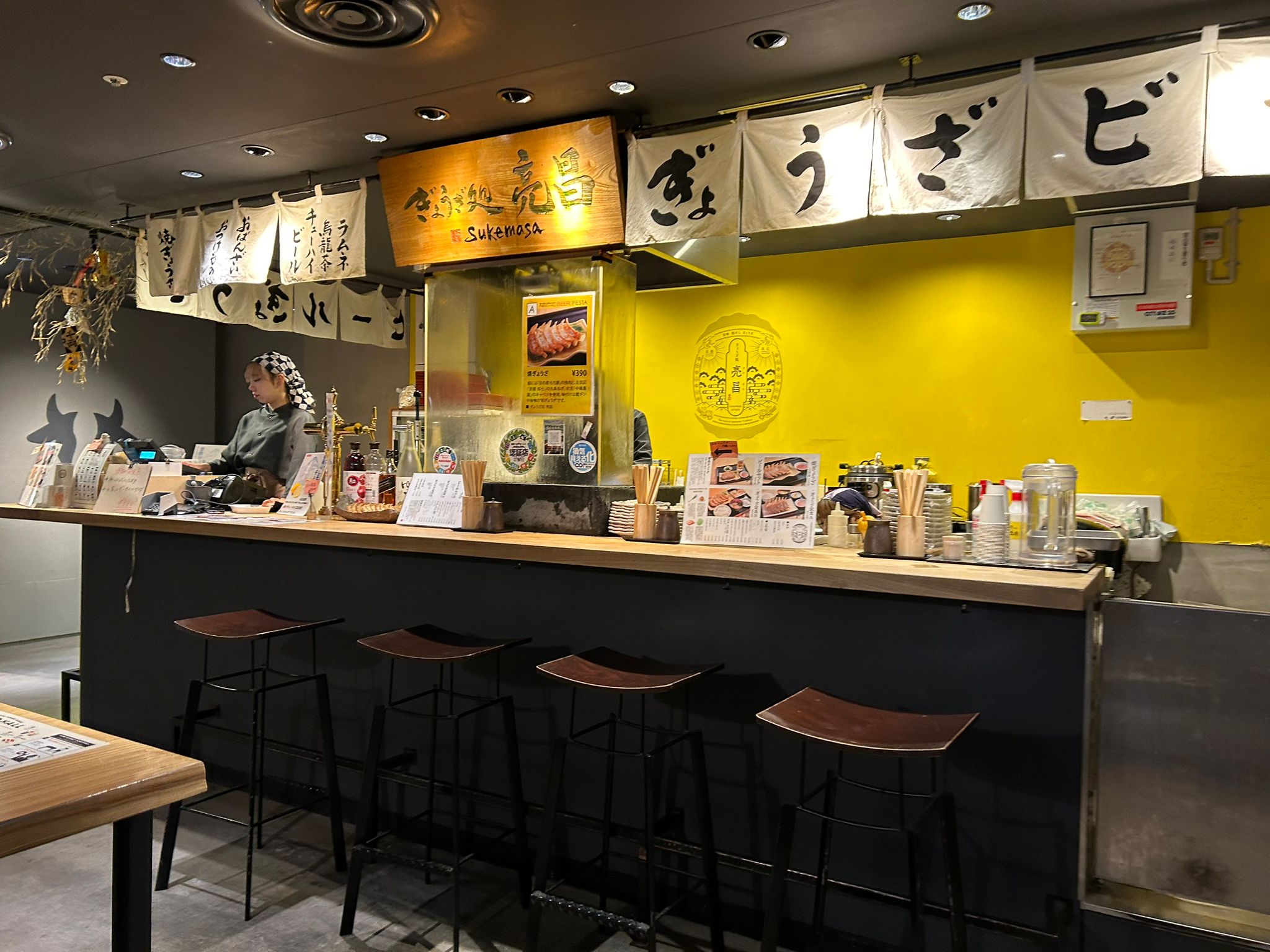

Address: on the B1 floor of Kyoto Tower.
Opening hours: 11:00 to 23:00.
Website: https://www.kyoto-tower-sando.jp/shop/guide
Osaka
Ajinoya honten (味乃家 本店)
It is a place specialized in okonomiyaki, the Japanese pizza. I guess because of the situation, it’s not too cheap but it’s very good.
Address: 〒542-0076 Osaka, Chuo Ward, Nanba, 1 Chome−7−16 現代こいさんビル2F.
How to get there: 1 minute walk from exit 14 of Namba metro station.
Opening hours: Tuesday to Friday from 11:30 a.m. to 9:00 p.m. Saturdays and Sundays from 11:00 to 21:00. Closed on Monday.
Website: http://www.namba-ajinoya.com/

It is a place specialized in okonomiyaki. It is very Japanese and they make you take off your shoes before entering. It’s not very cheap but it’s delicious and they make the okonomiyaki right at your table.
The best okonomiyaki I’ve ever had.
Address: 3 Chome-1-12 Tenjinbashi, Kita Ward, Osaka, 530-0041.
How to get there: 3 minutes north of JR Ōsakatemmangū Station and Minami-morimachi Subway Station.
We can also walk 6 minutes from the Osaka Temmangu temple, to the north also by a shotengai.
Opening hours: every day from 11:00 a.m. to 11:00 p.m.


It is a tepanyaki restaurant specializing in Kobe beef located in Dotonbori. Of course it is expensive, but it is worth it to treat yourself from time to time.
The cook will give you advice on how to eat it, and it is spectacular even the vegetables.
Address: 1-5-2, Dotombori, Chuo, Osaka 542-0071.
How to get there: It is located on the main street of Dotonbori, where we find all the restaurants, about 100 meters east of the Glico sign.
Opening hours: Tuesday to Sunday, from 11:00 a.m. to 3:00 p.m. and from 5:00 p.m. to 10:00 p.m. Closed on Monday.

Nagoya
Rich miso ramen Sakaeya (濃厚味噌らーめん さかえ屋)
It is a small ramen place. It wasn’t touristy at all, so everything was in Japanese and quite cheap and tasty.
Address: 4 Chome-15-14 Sakae, Naka Ward, Nagoya, Aichi 460-0008.
How to get there: 4-minute walk southeast from Sakae subway station.
Opening hours: Monday to Saturday from 11:30 a.m. to 3:00 p.m. and from 6:00 p.m. to 8:00 p.m. Sundays from 11.30 to 20.00.
Website: https://sakaeya.owst.jp/

It is an izakaya type food chain that is all over Japan although it is originally from Nagoya. It is famous for its fried chicken wings.
It’s excessively expensive for a fry-up, but it’s tasty.
Address: 4 Chome-13-24 Sakae, Naka Ward, Nagoya, Aichi 460-0008.
How to get there: 3 minutes southeast of the Sakae subway station.
Opening hours: from 4:00 p.m. to 8:00 p.m.

Chain of ramen restaurants that are all over Japan and I even saw one on my trip to New York. The tonkotsu ramen is spectacular and has the peculiarity that it is eaten in a kind of booth, alone. The subject is very antisocial.
You sit down and mark the box on a piece of paper, the broth, the noodles, the toppings, etc… A blind rises in a small window in which there is someone whose only hands you can see, you give them the piece of paper, and in a minute you put your ramen on and close the window.
Address: Japan, 〒460-0003 Aichi, Nagoya, Naka Ward, Nishiki, 3 Chome−22−7, Ark, 2F.
How to get there: 3-minute walk west of Sakae Subway Station Exit #8.
Opening hours: every day from 11:00 a.m. to 8:00 p.m.
Website: https://ichiran.com/shop/chubu/nagoya-nishiki/

Conveyor belt sushi restaurant located in the Oasis 21 shopping mall in the Sakae district. It’s very good but it’s a bit expensive.
Address: 1 Chome-11-1 Higashisakura, Higashi Ward, Nagoya, Aichi 461-0005.
How to get there: It is located on the ground floor of the Oasis 21 shopping center in the Sakae district.
Opening hours: from 11:00 to 20:00.
Website: https://www.nigirinotokubei.com/
Kii-Katsuura
A small restaurant specializing in tuna sushi, although with a few more things. It is run by a quite old and very serious man, who only speaks Japanese, but has a menu in English.
It must be said that the tuna was to cry. It is very cool as it disembarks at the dock that is just 100 meters away. And it is that Kii-Katsuura is the tuna mecca of Japan.
Address: Japan, 〒649-5335 Wakayama, Higashimuro District, Nachikatsuura, Tsukiji, 2 Chome−2−6.
How to get there: A two-minute walk north from JR Kii-Katsuura Station.
Opening hours: Every day from 11:00 to 21:00.

Here we leave a map with the locations of all the restaurants:
Find the best activities and tours in Japan with Civitatis:
On this page you can find all the information about Tokyo, the capital of Japan, from its history to learning to move, going through what you can’t miss.
Follow us on social media:

As always, we recommend traveling with good health insurance. IATI is a specialist in travel insurance and, for being our reader, you have a 5% discount.
*It helps us to maintain the blog
Content:
General information
Find the best activities and tours in Tokyo with Civitatis:
*It helps us to maintain the blog
What to See in Tokyo
Near Tokyo
Discover Japan through our travel diaries.
Tokyo, the capital of Japan, home to more than 37 million inhabitants in its metropolitan area, almost the same as the total population of Spain.
Tokyo is founded in 1457 under the name of Edo (江戸), with the construction of Edo Castle, the work of Ōta Dōkan (太田道灌), a samurai vassal of the Uesugi clan.

In the year 1590 the shōgun Tokugawa Ieyasu (徳川 家康) took the castle and in the year 1603 established his government here. With this fact, the Edo period (江戸時代) began, which would last until the year 1868.
At the end of this year, with the change of government at the beginning of the Meiji Era, the emperor moved to Edo Castle, turning it into the Imperial Palace and renaming the city with the name of Tokyo. In the year 1871 the fiefdoms were abolished and the prefectures were created, including Tokyo with its 23 special wards.
In the year 1872 the first railway line began to be built and in 1885 the Yamanote circular line (山手線) was inaugurated, which will be the most used on our trip through Tokyo.
In 1923 the great Kantō earthquake (関東大震災) occurs, leaving the city devastated and approximately 143,000 dead.
At the beginning of the year 1936, the Incident of February 26 (二・二六事件) occurs, an attempted coup carried out by about 1,400 young officers of the imperial army.
They assassinated several high officials, including some ministers, but were unable to assassinate then-Prime Minister Keisuke Okada (岡田 啓介) or take control of the imperial palace. Two days later they surrendered.
During World War II, Tokyo was heavily bombed and, after Japan’s surrender, the city was occupied by Allied forces. At present, the United States Army still maintains Yokota Air Base (横田空軍基地) and several barracks.
Discover the best activities and tours in Tokyo with Civitatis:
*Helps us to maintain the blog